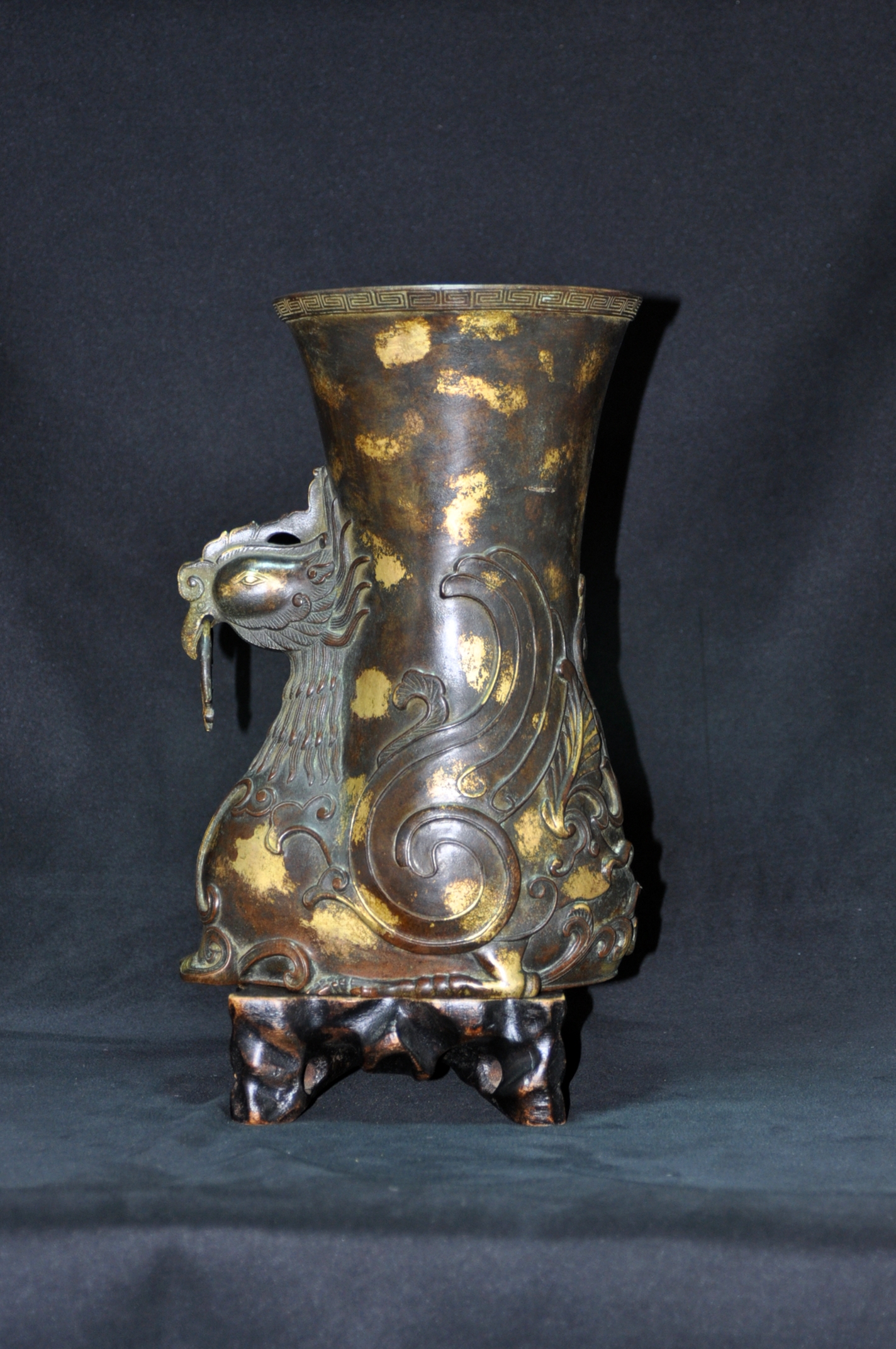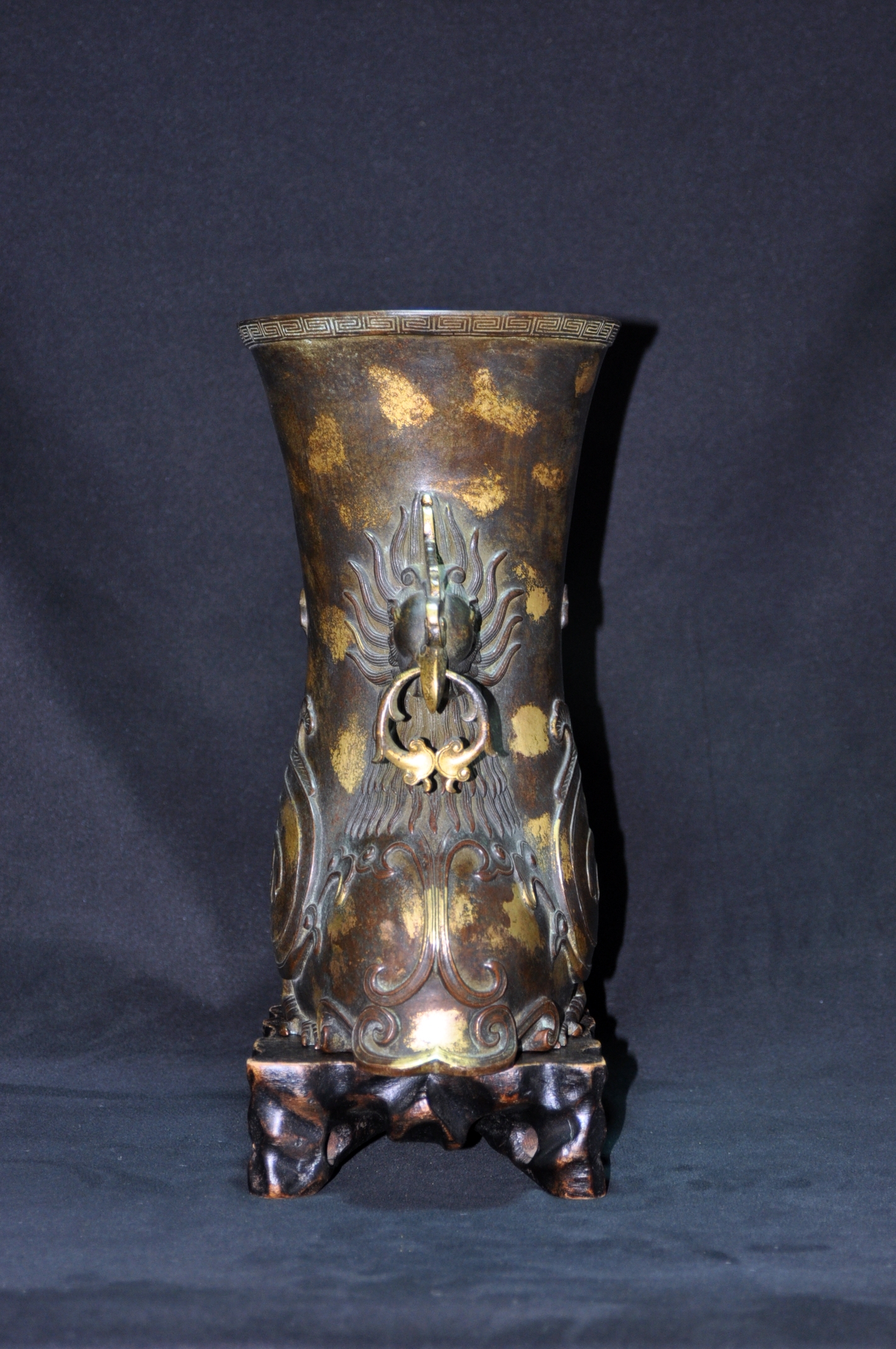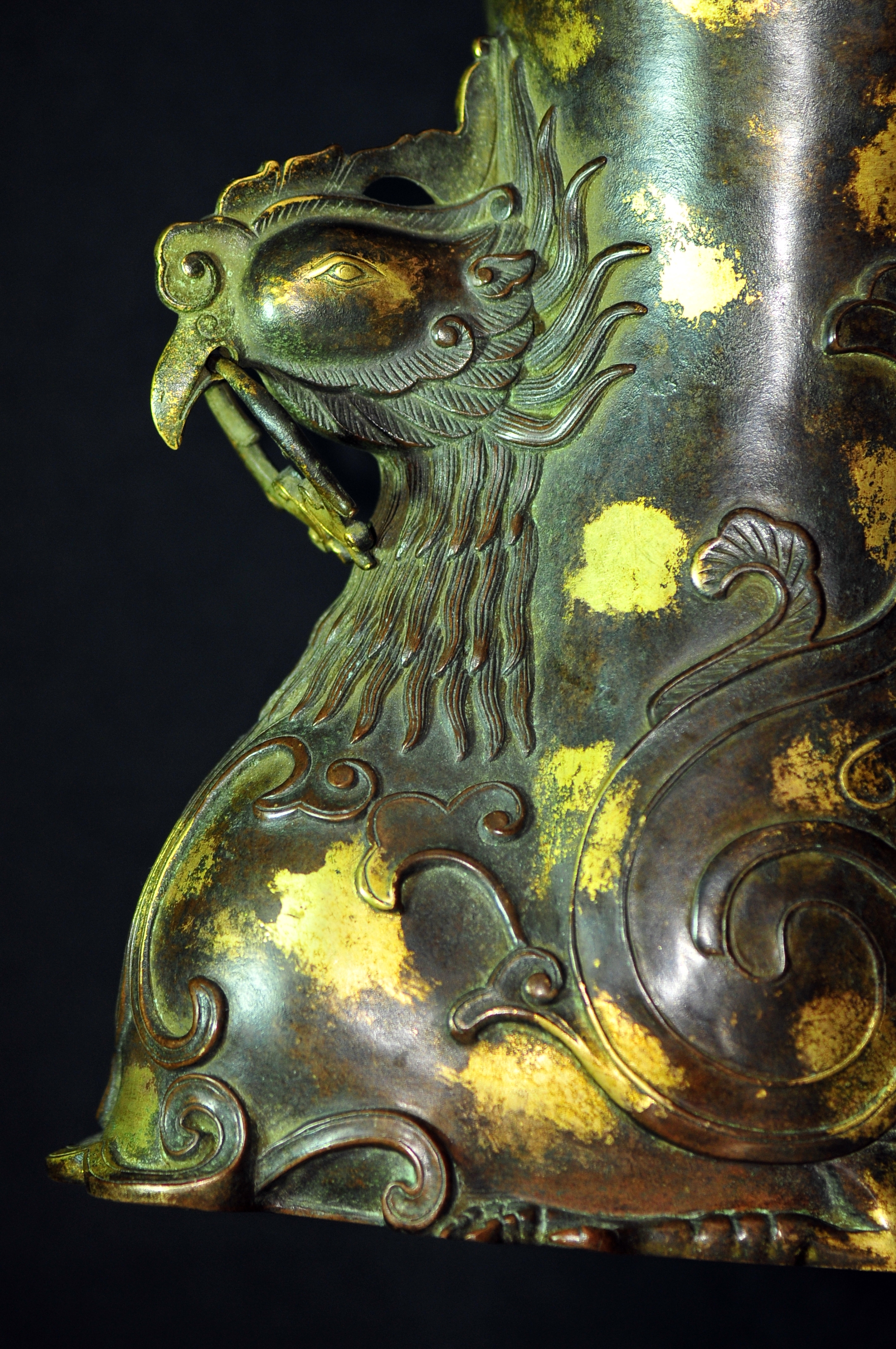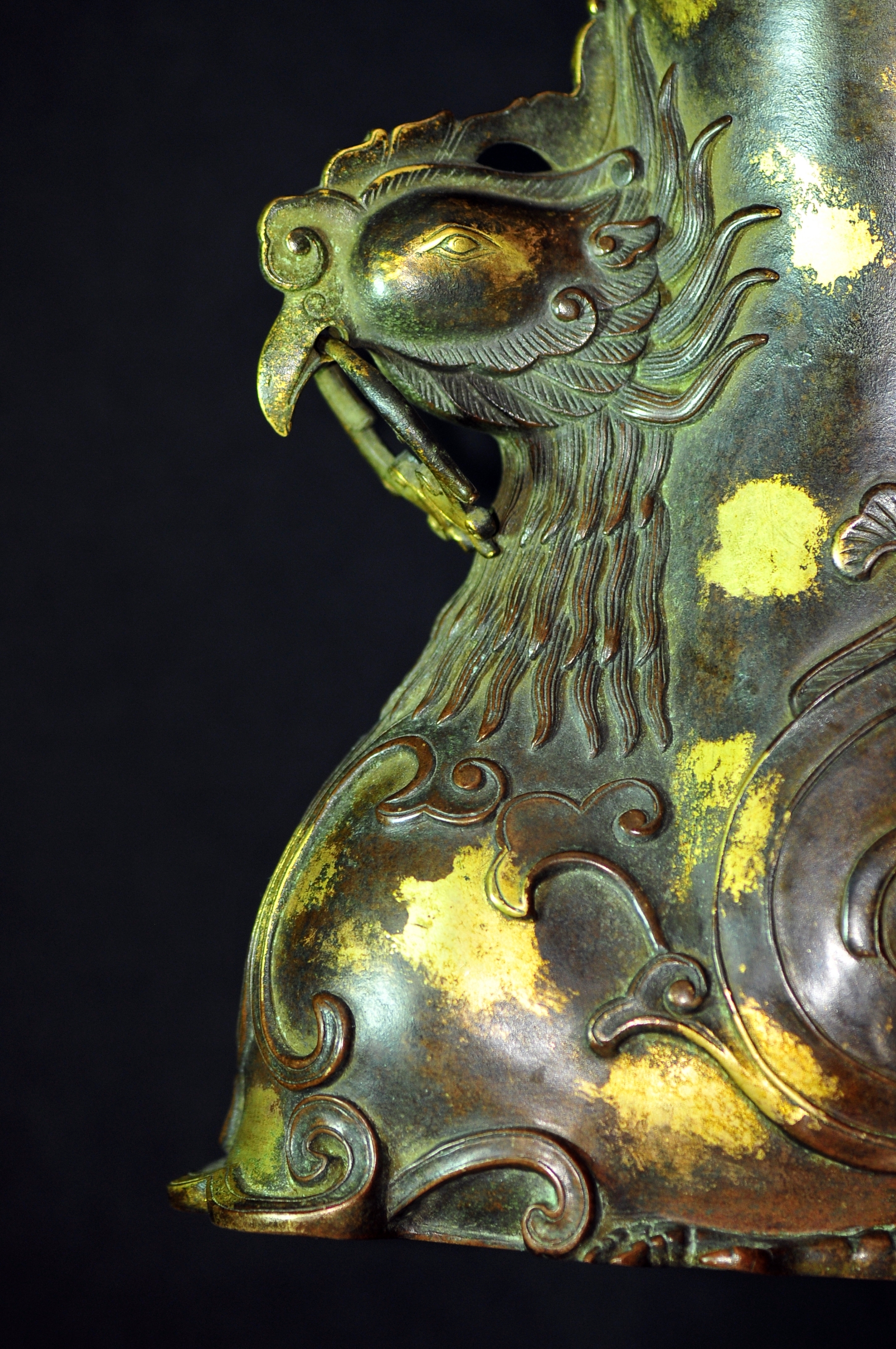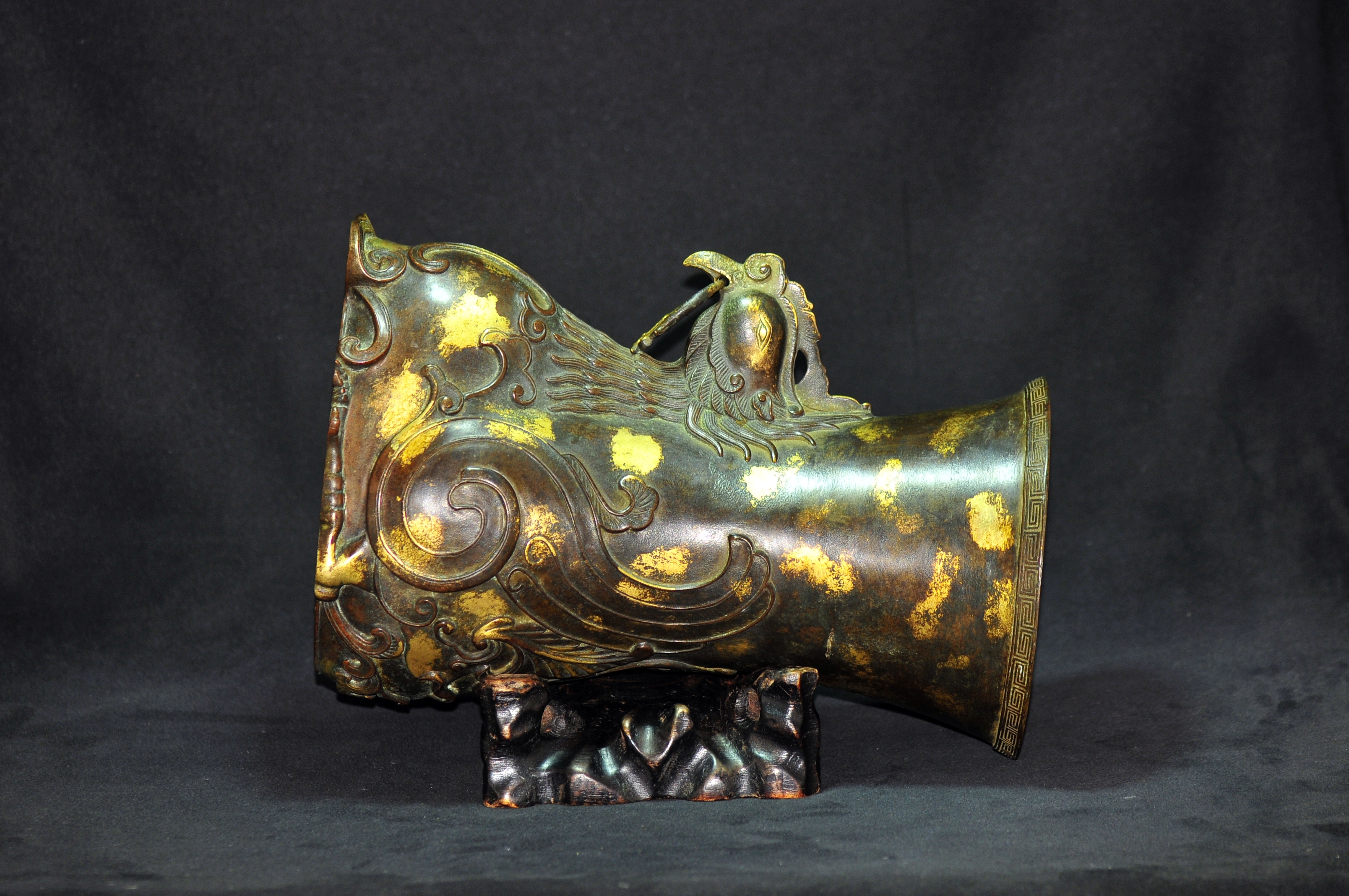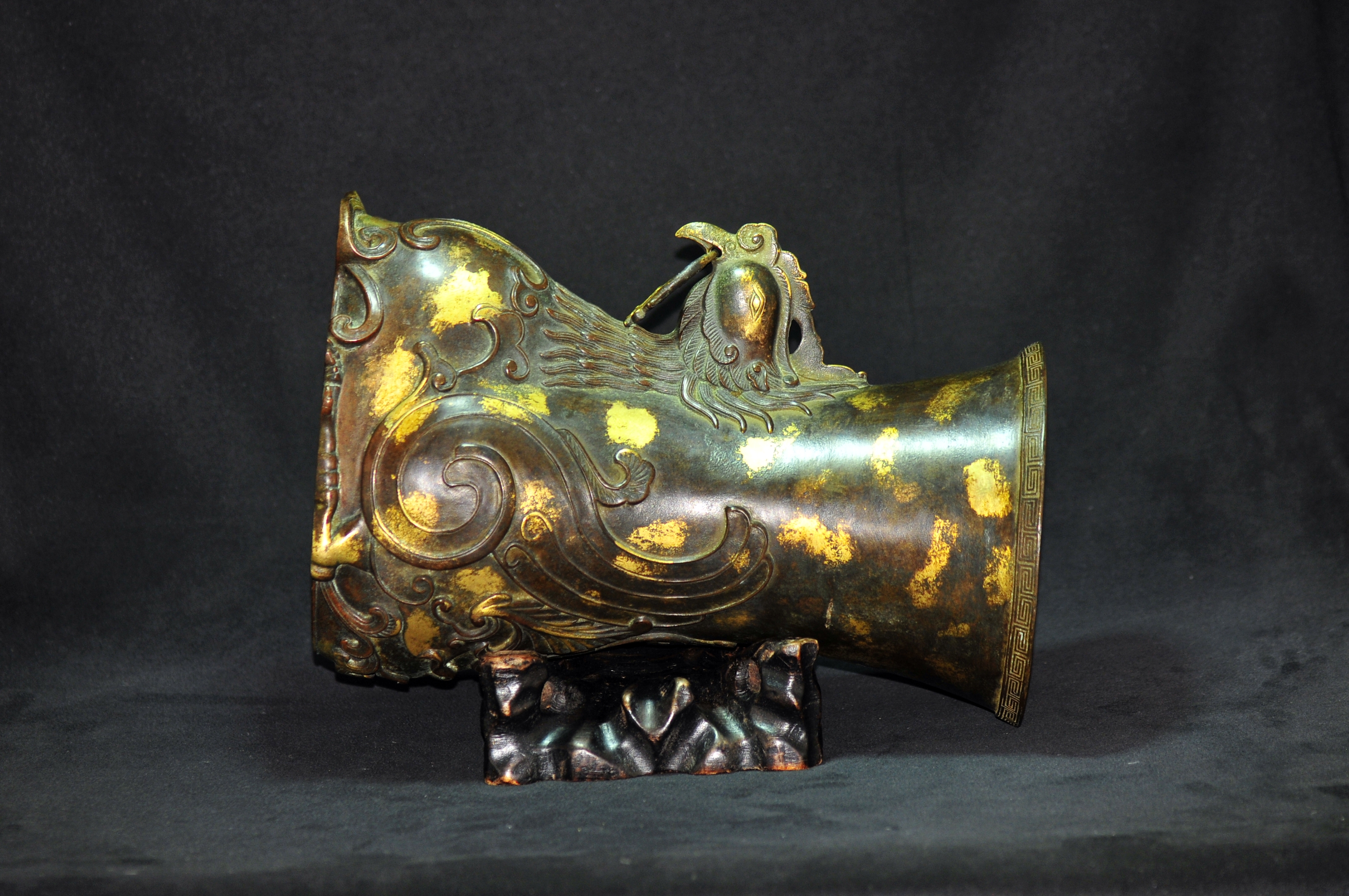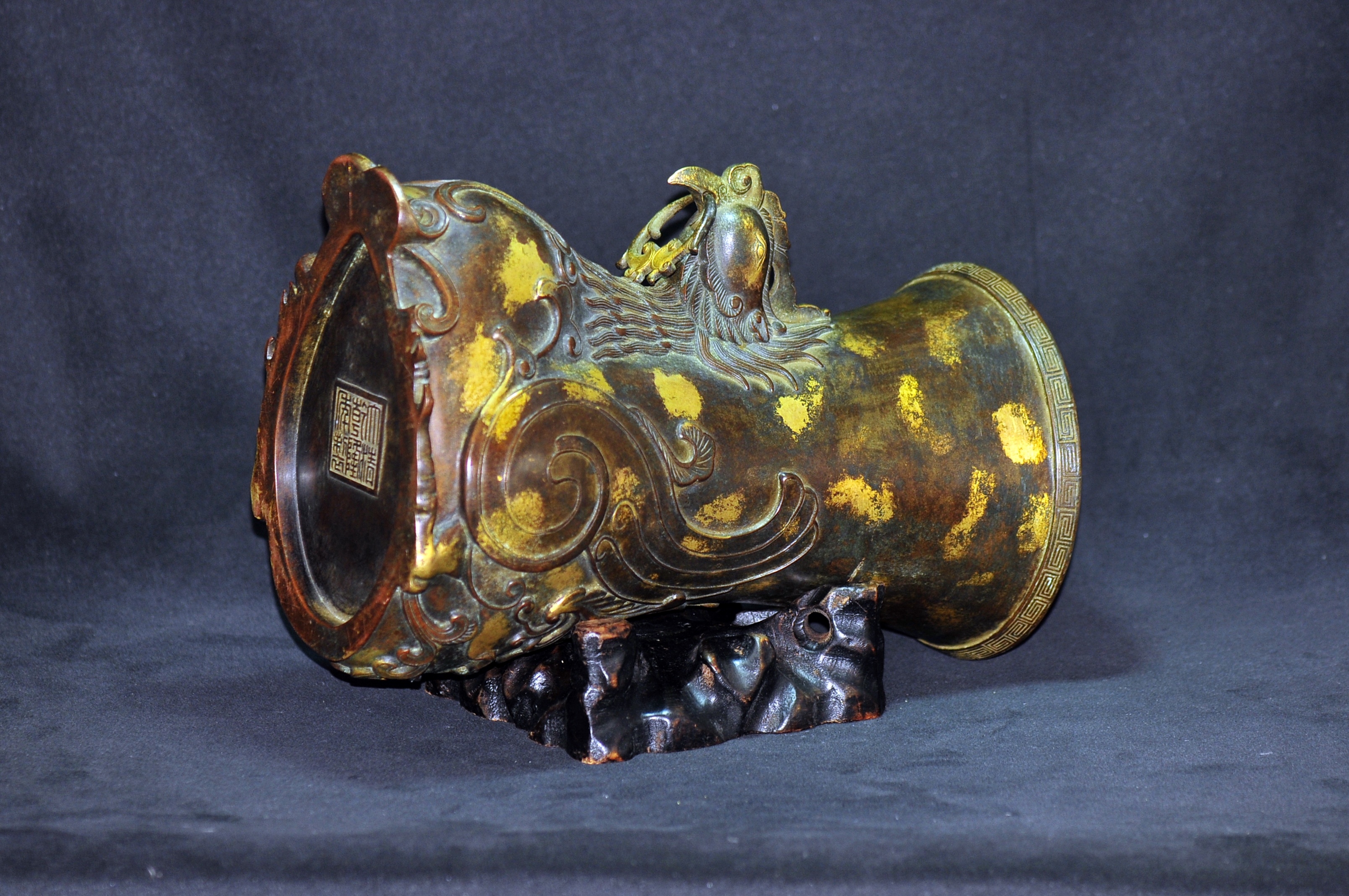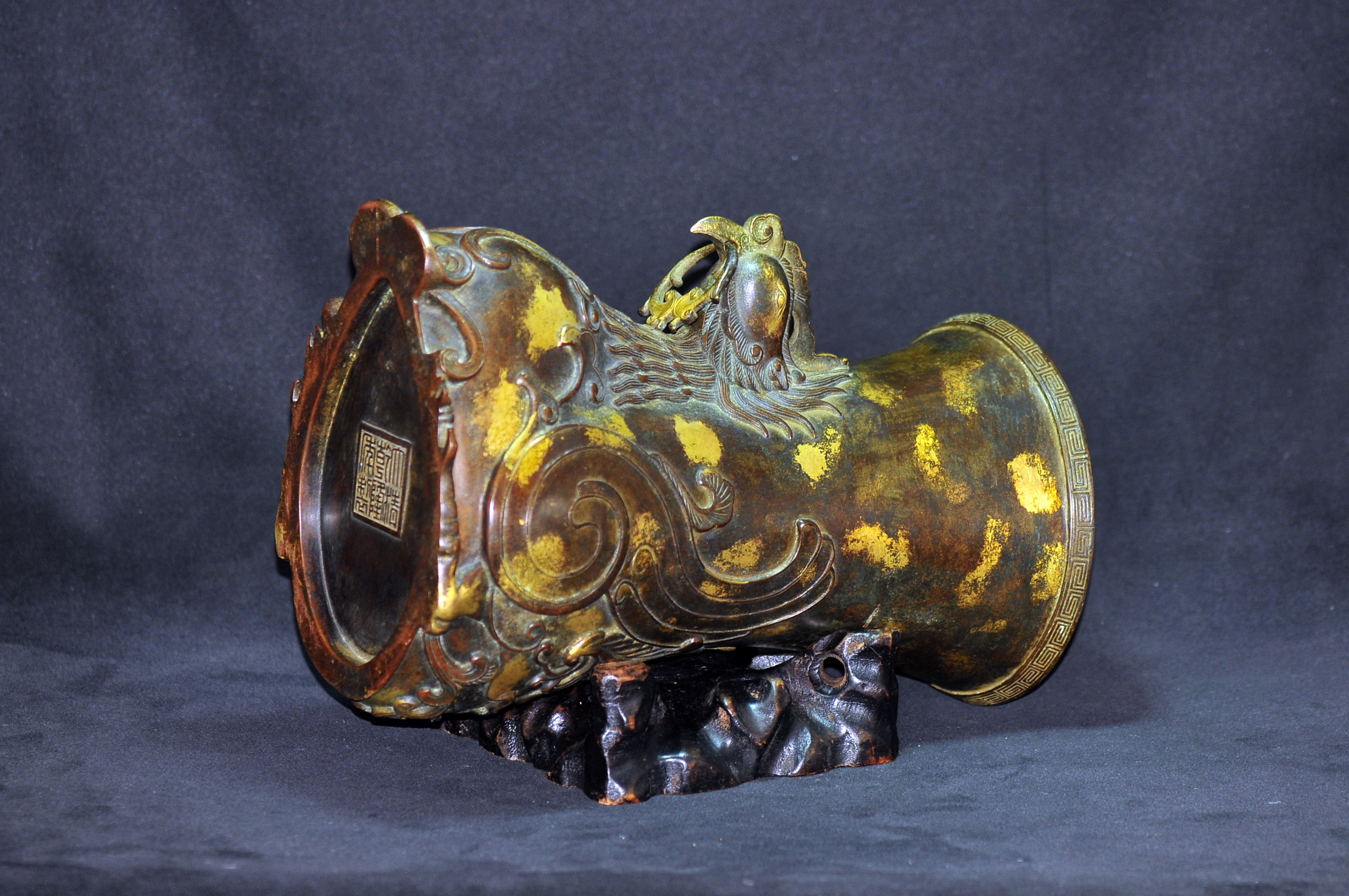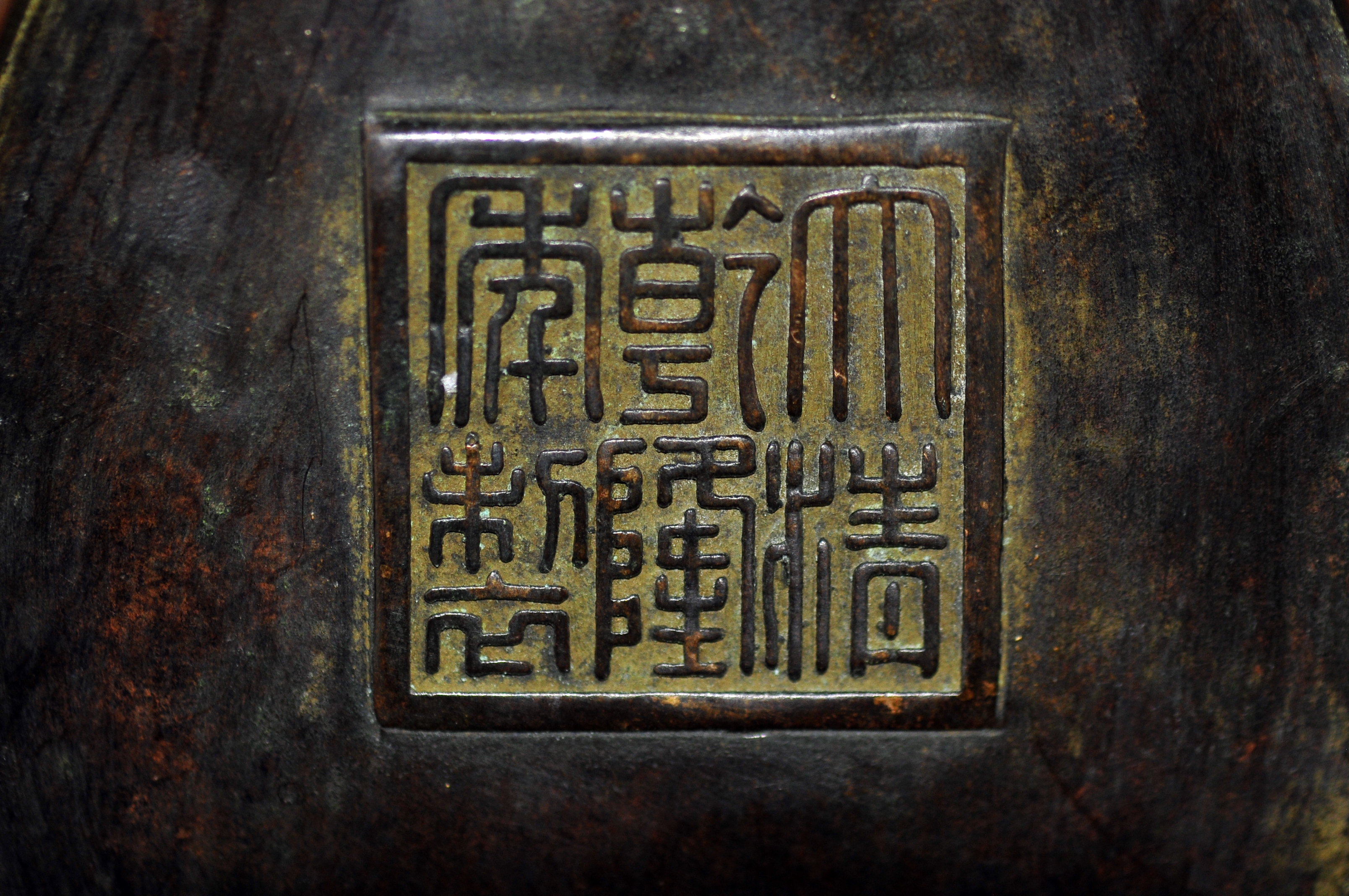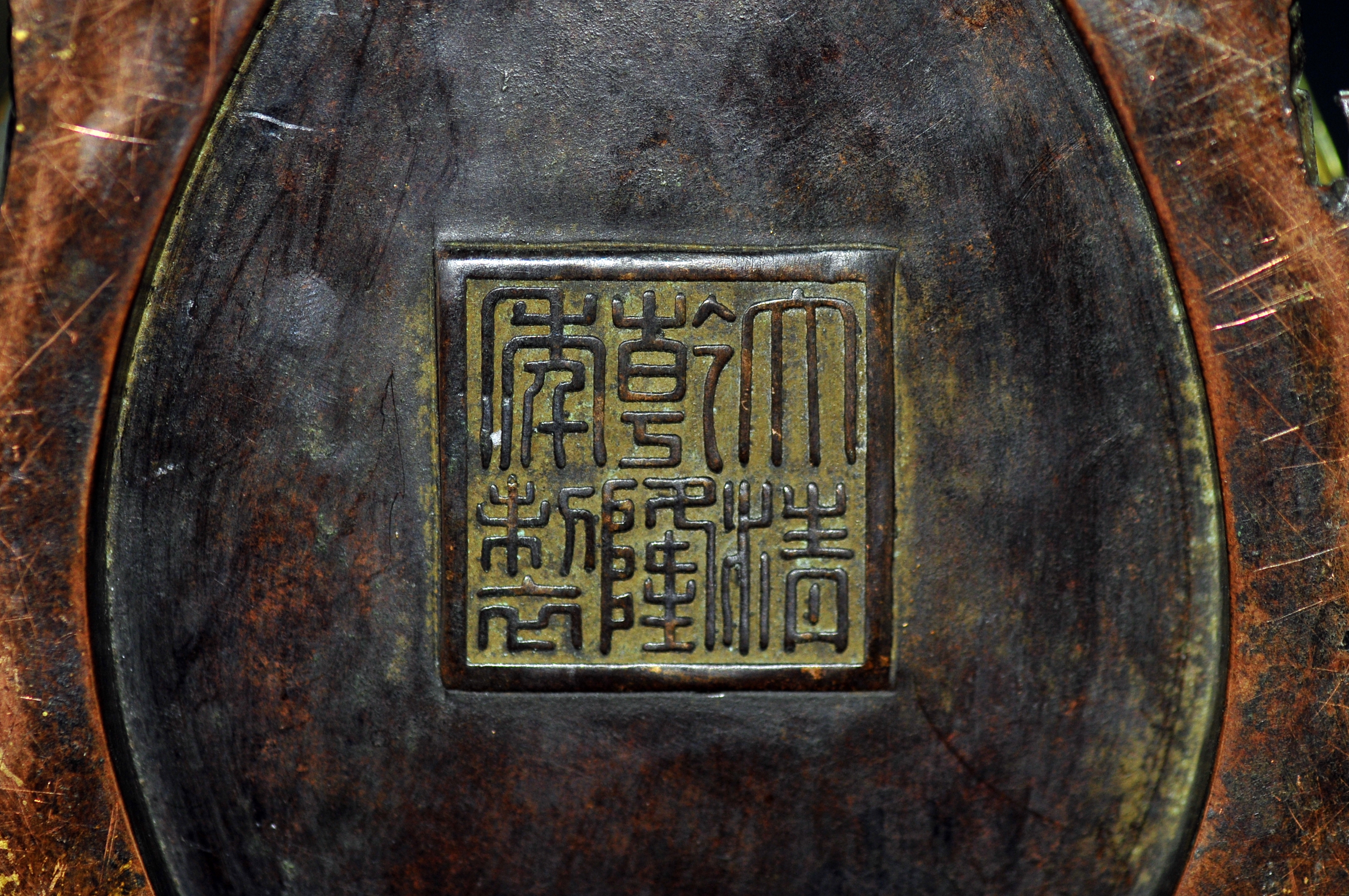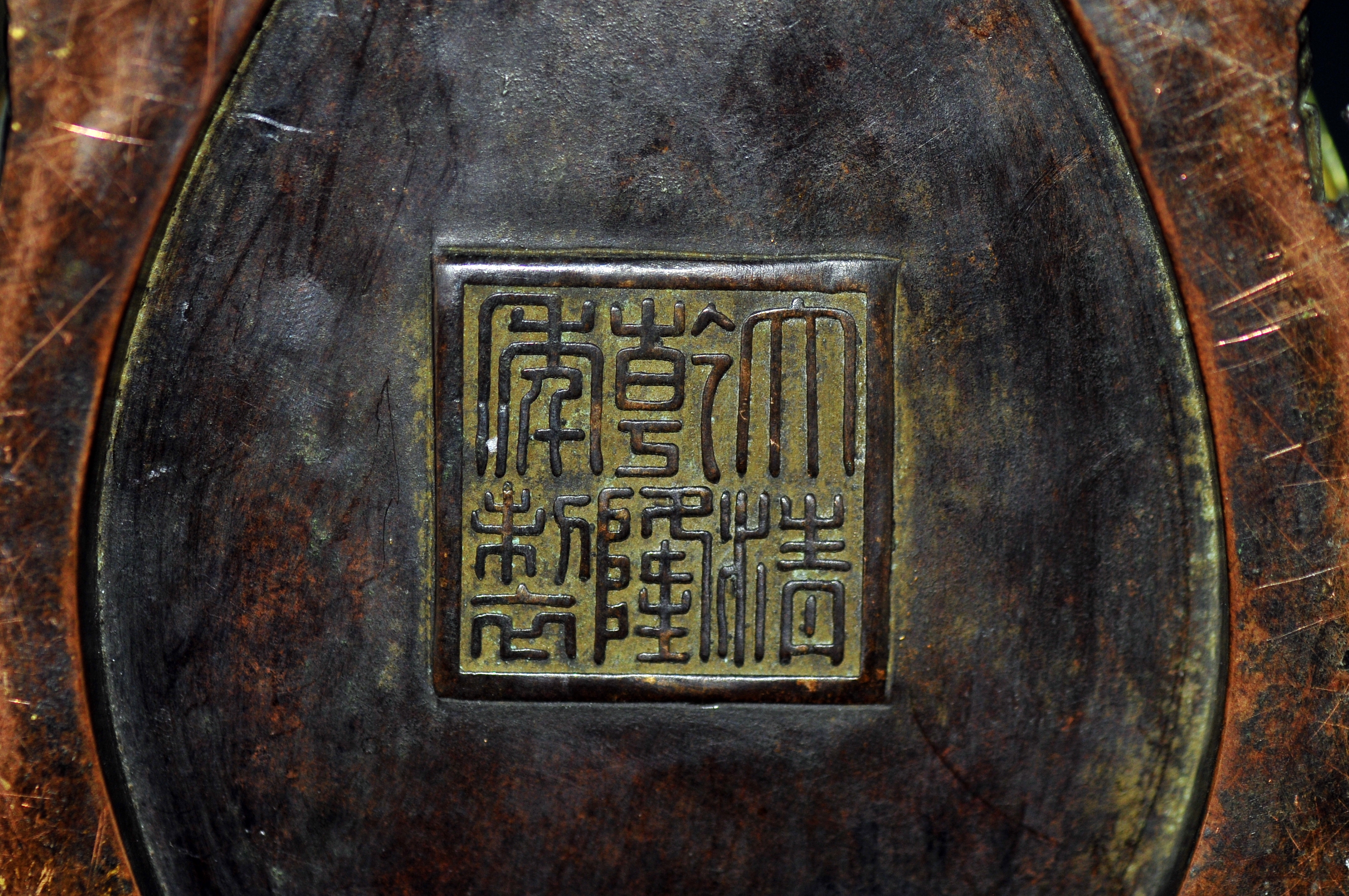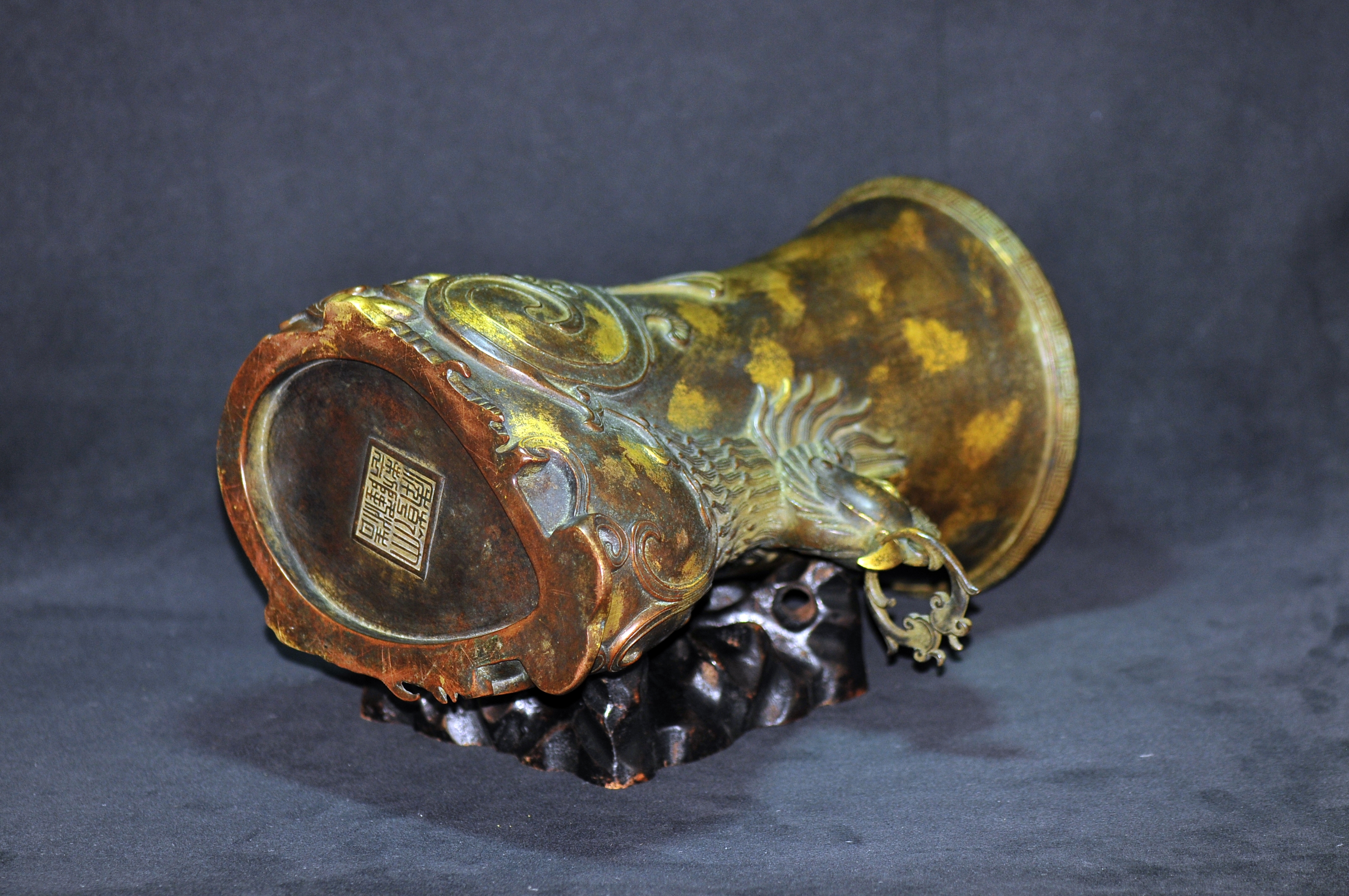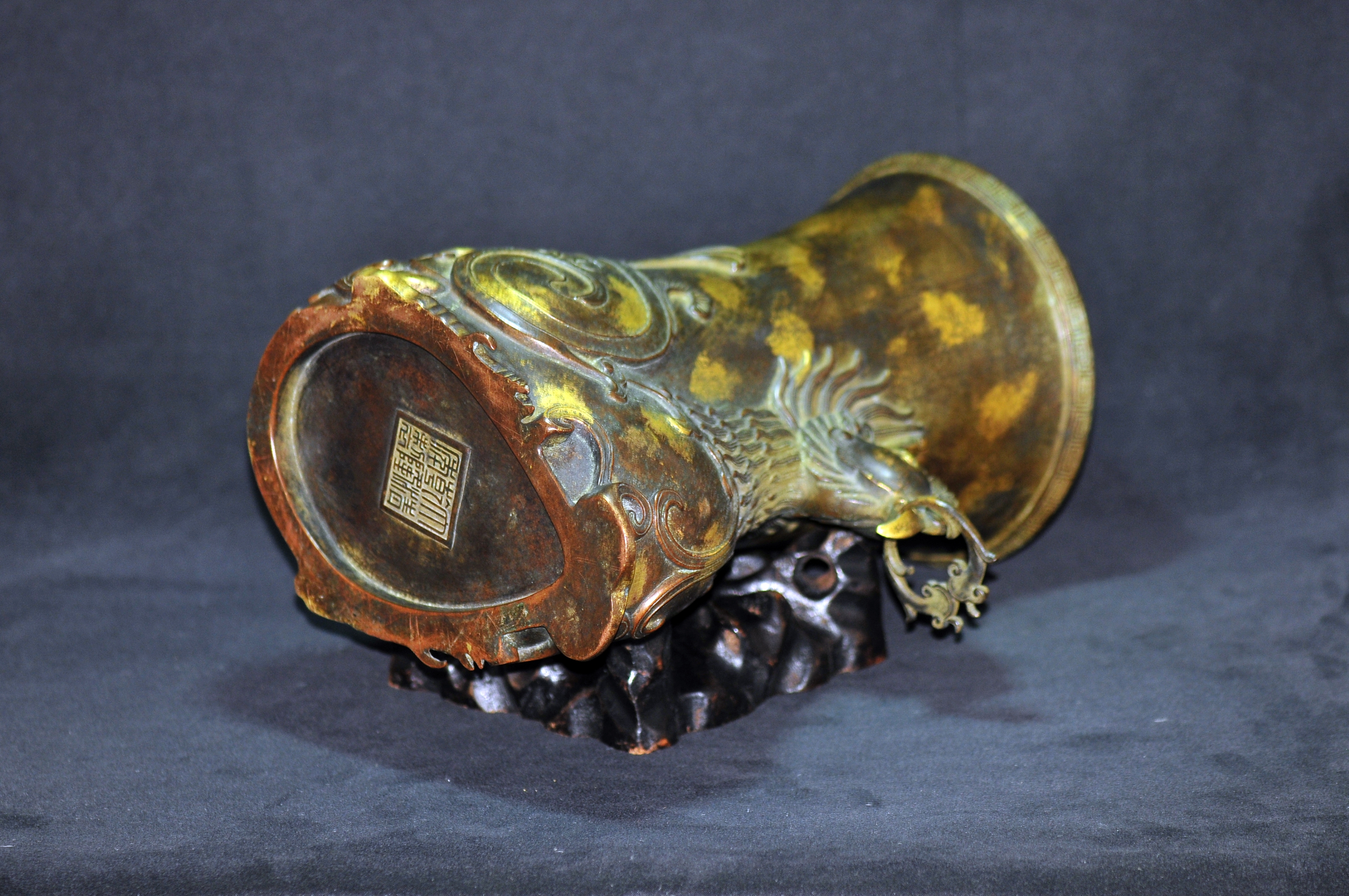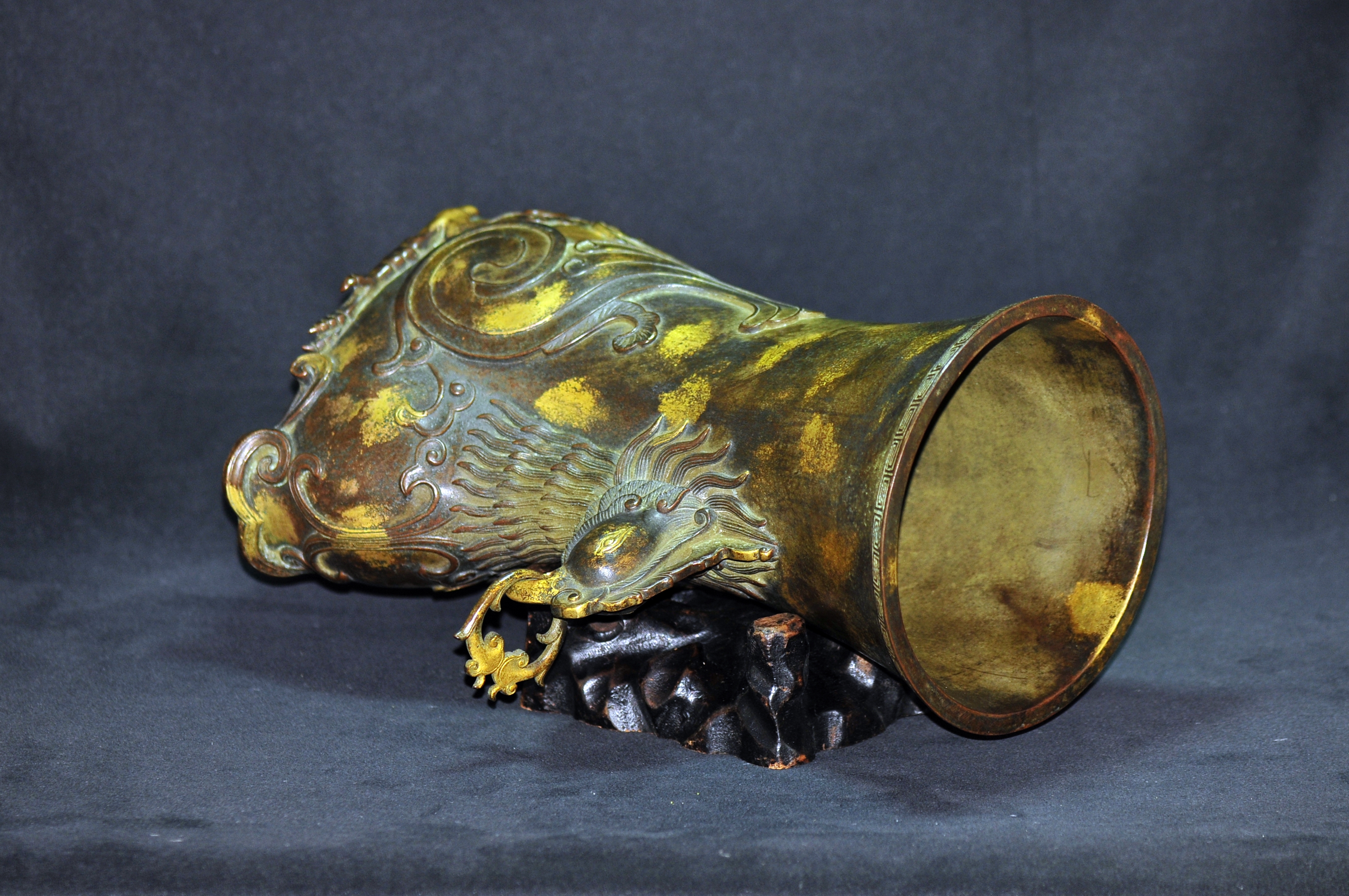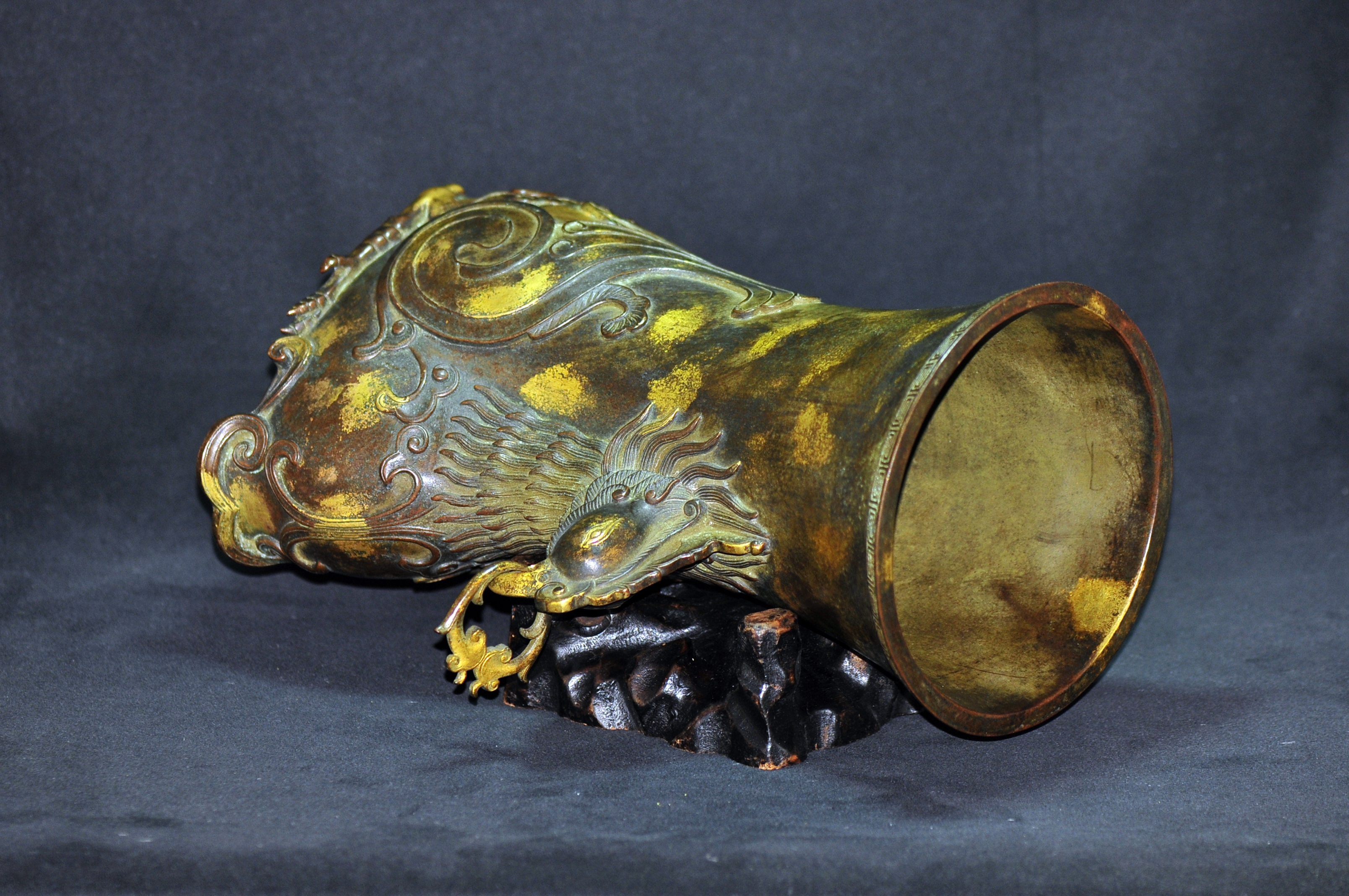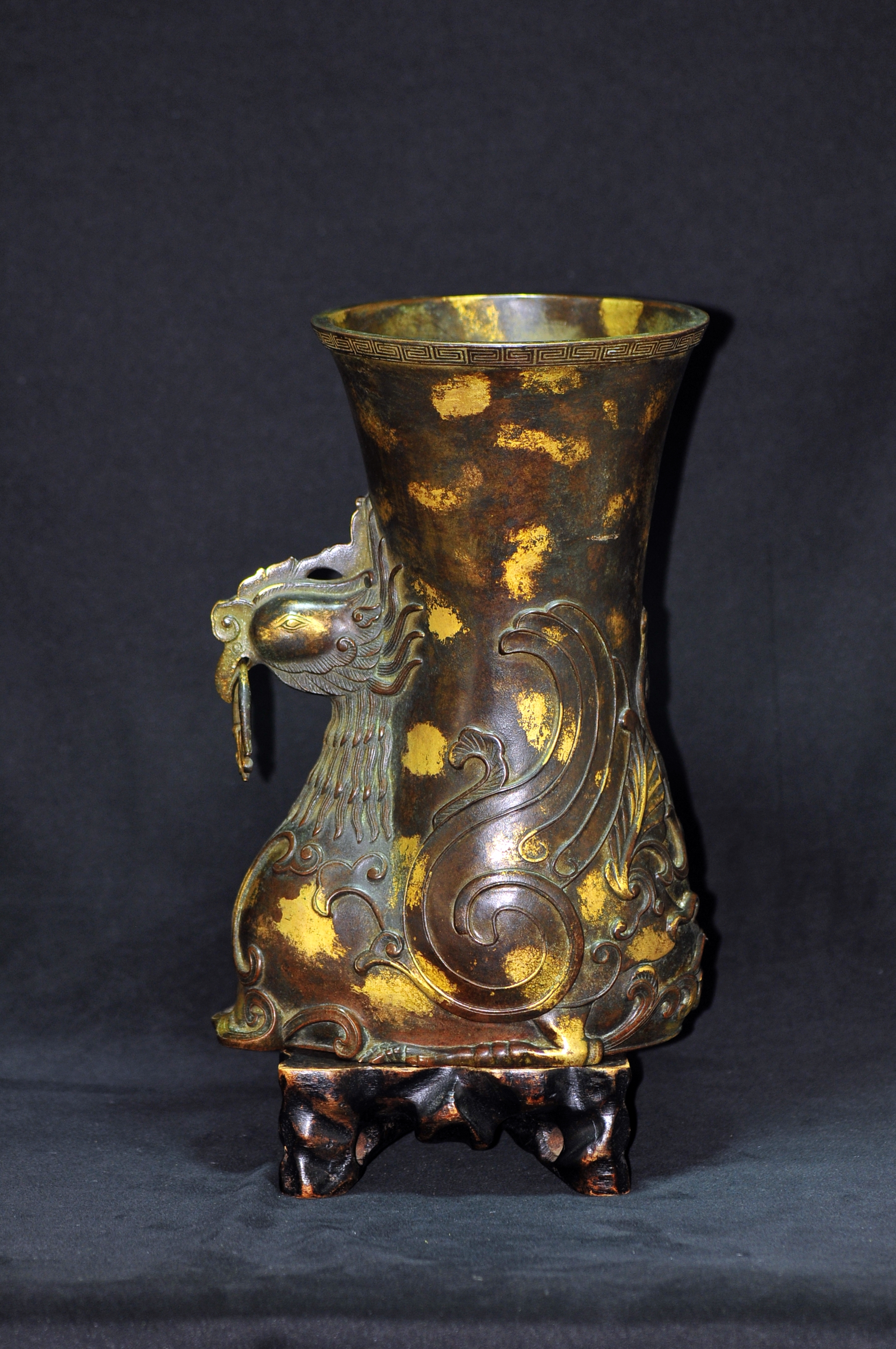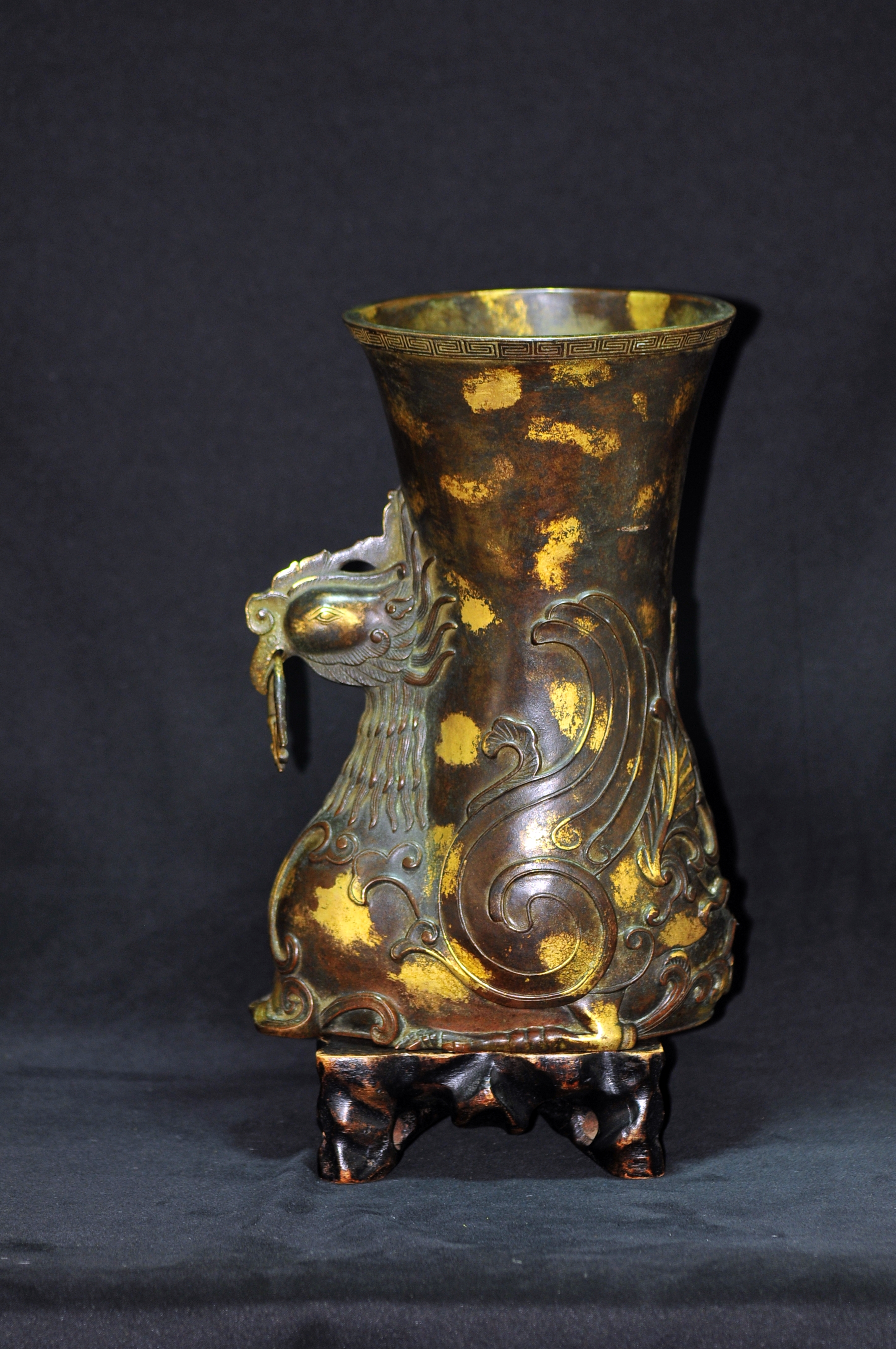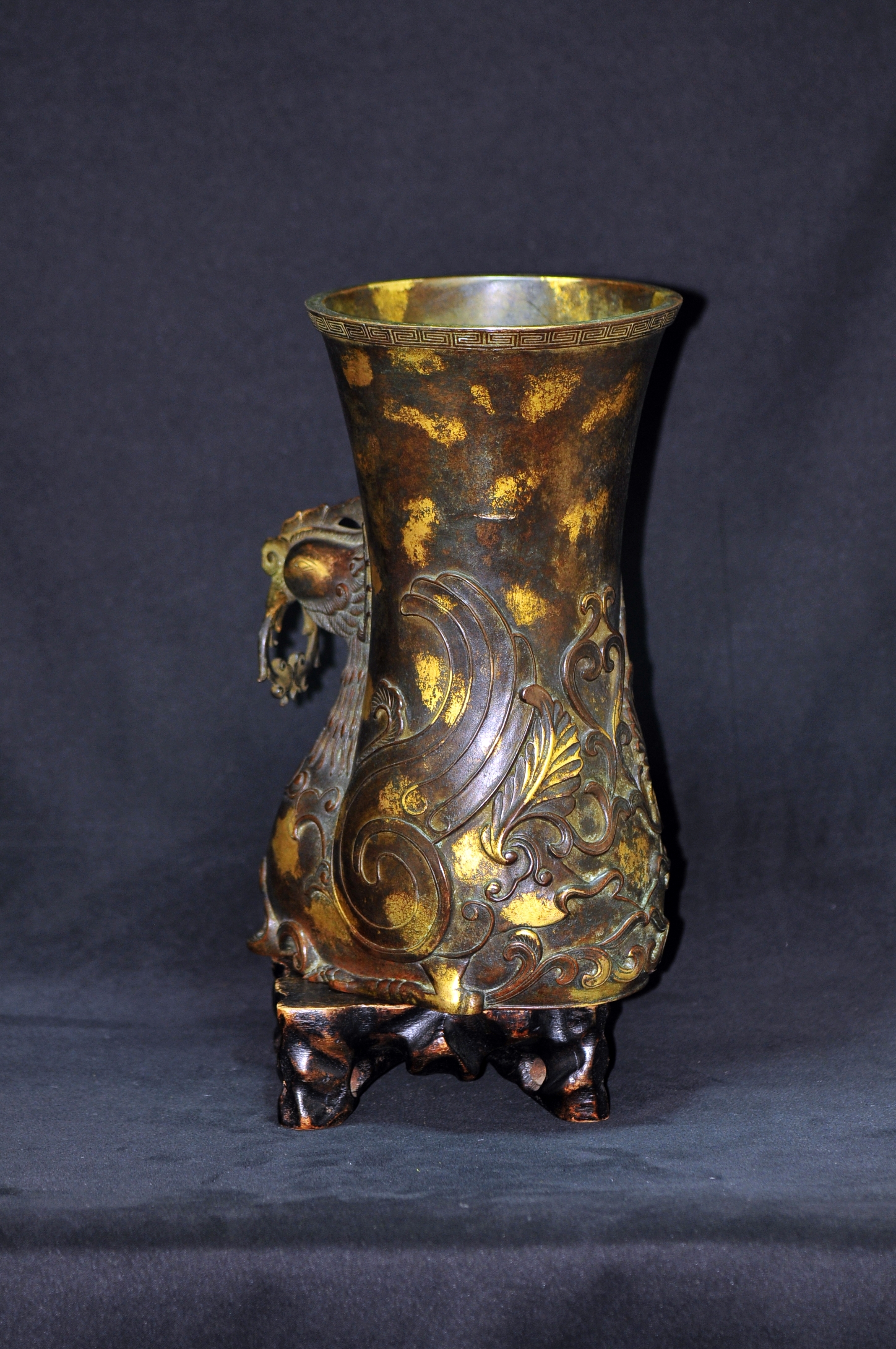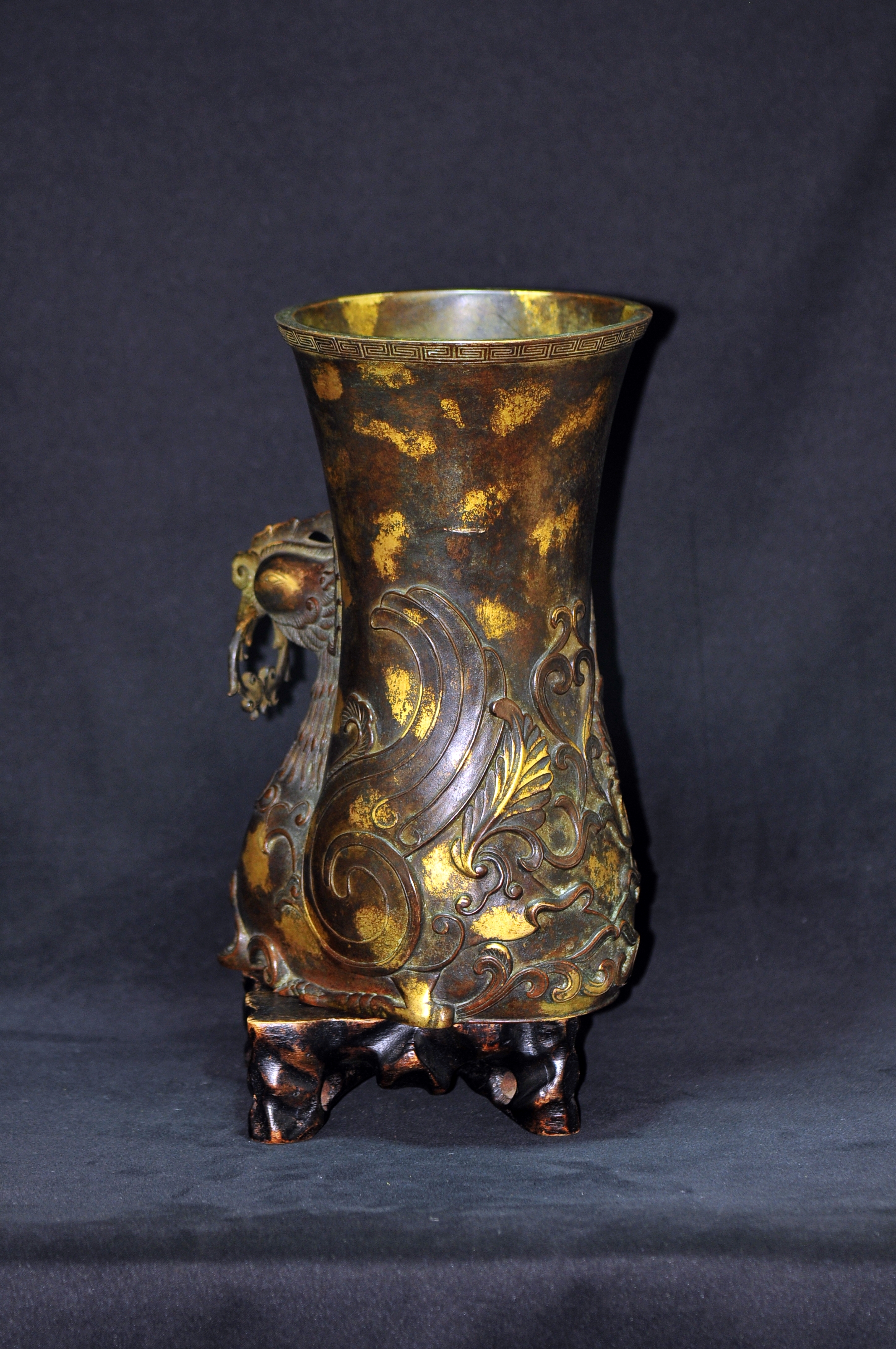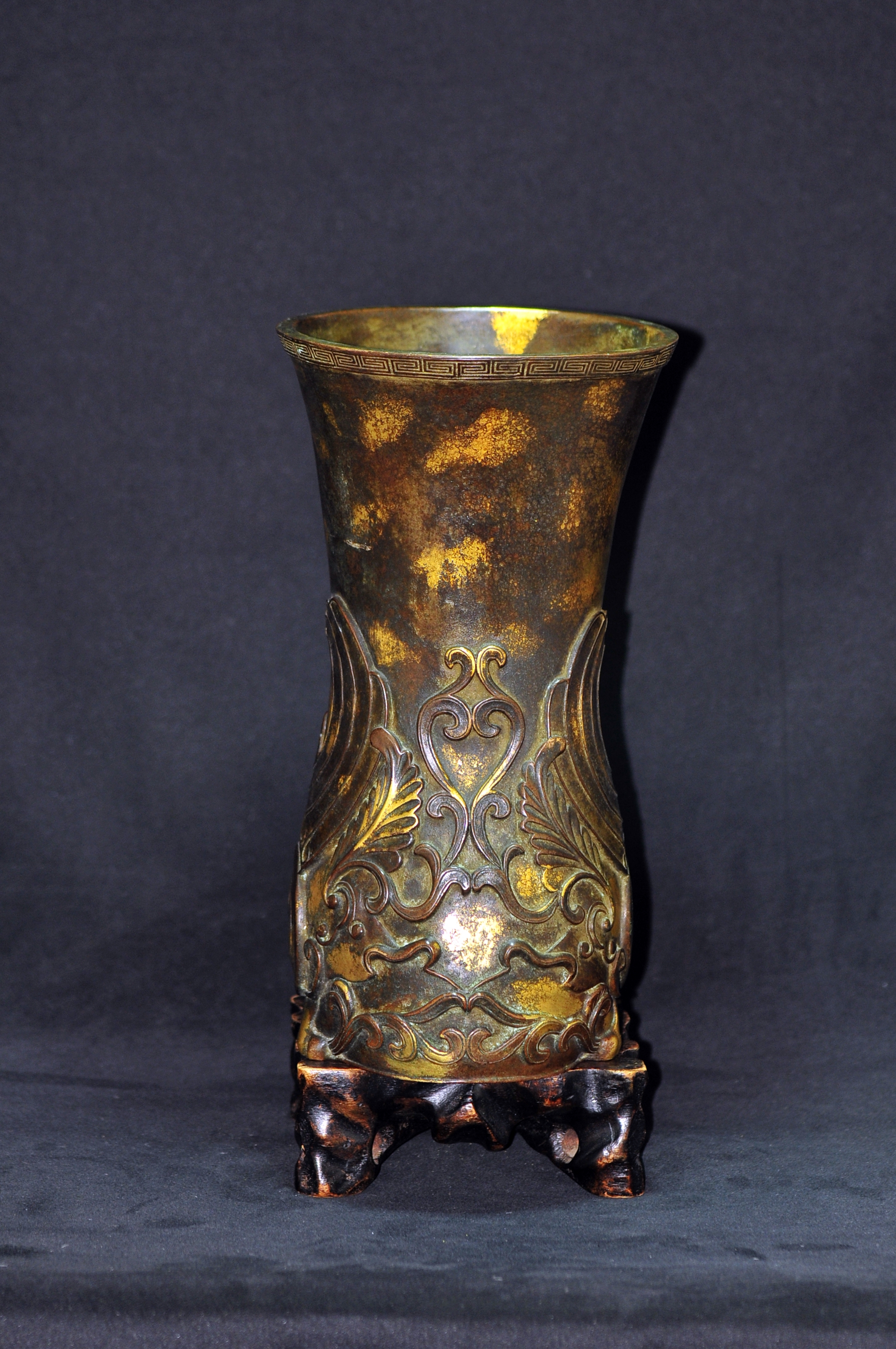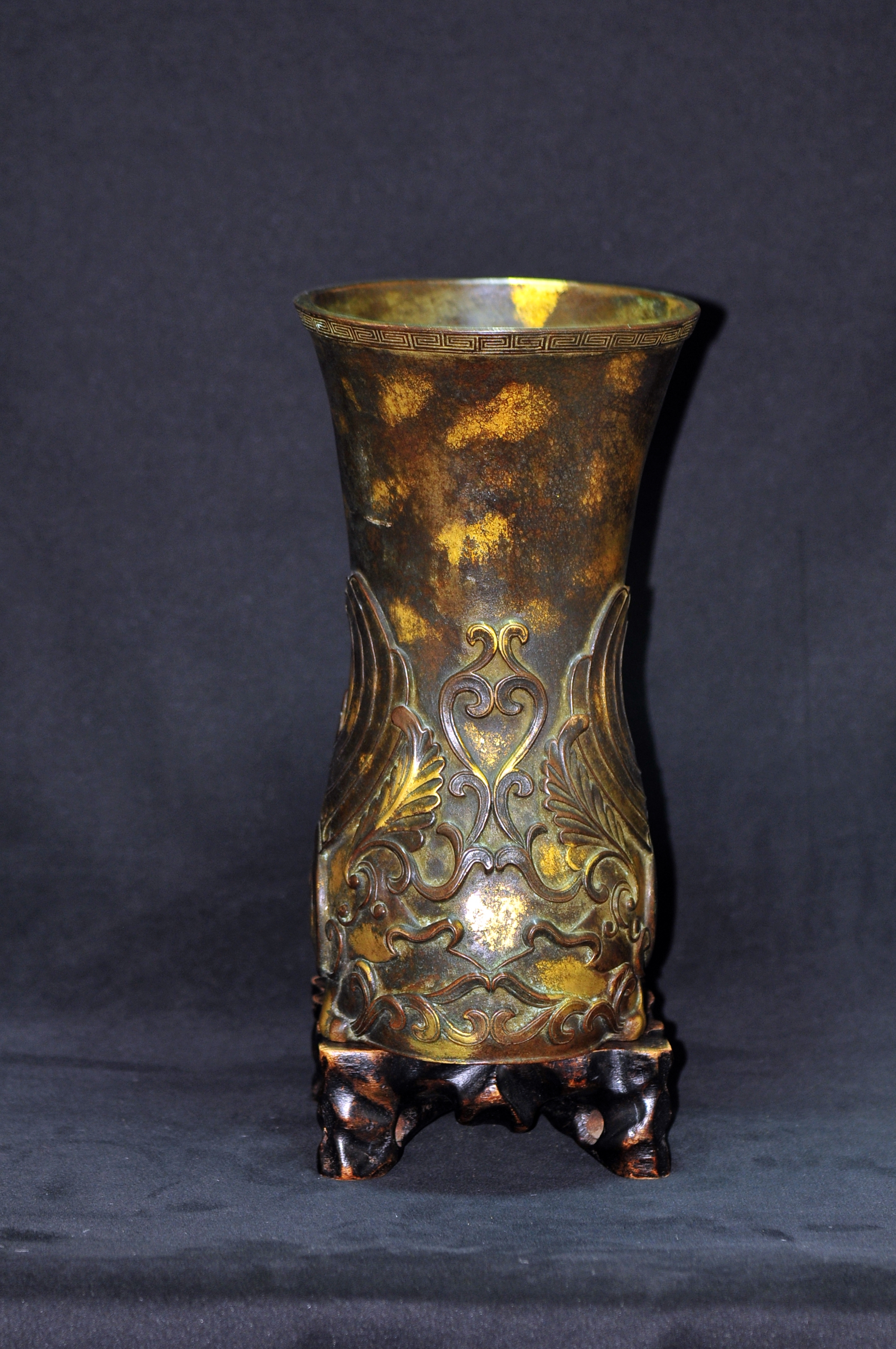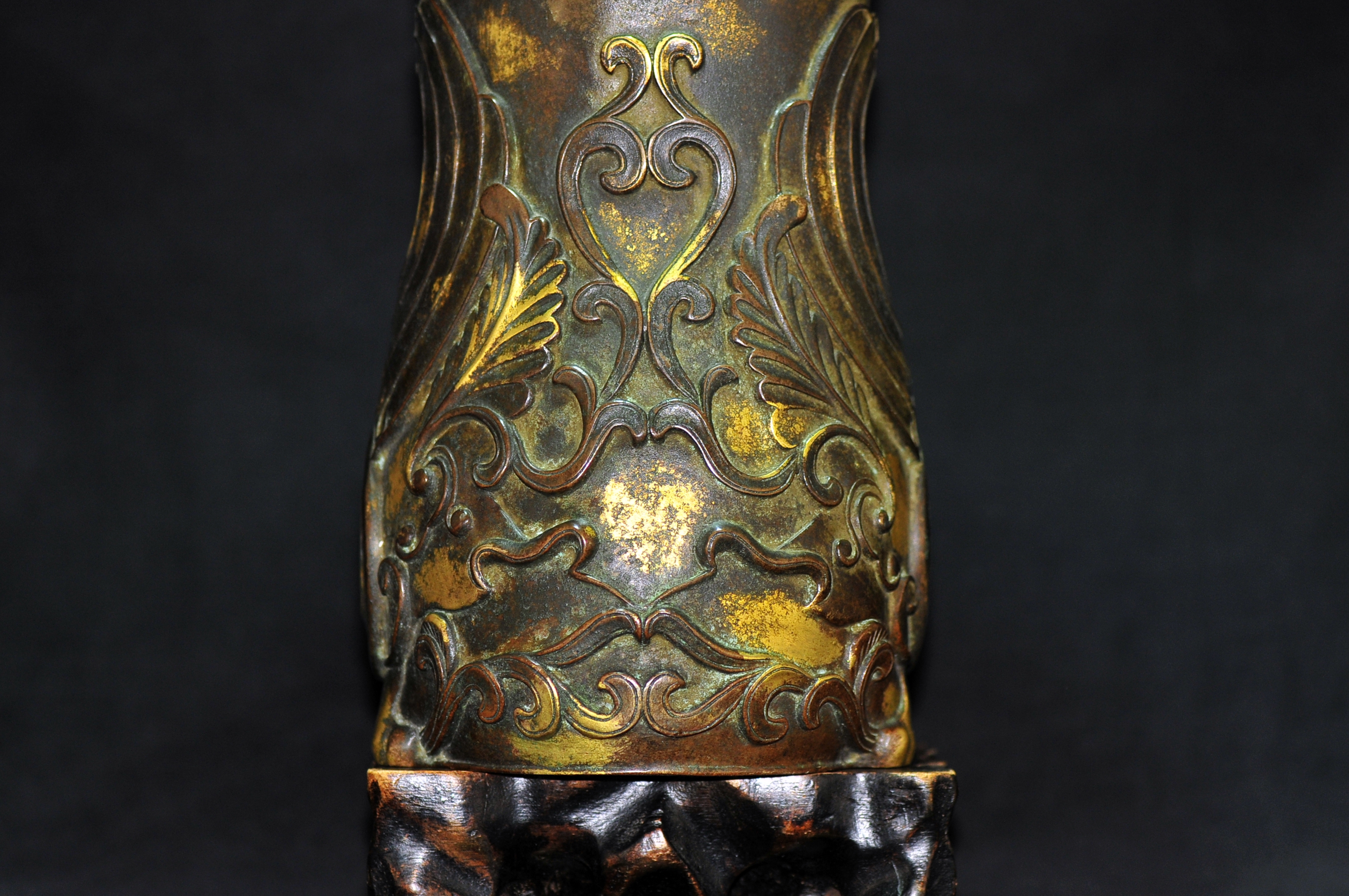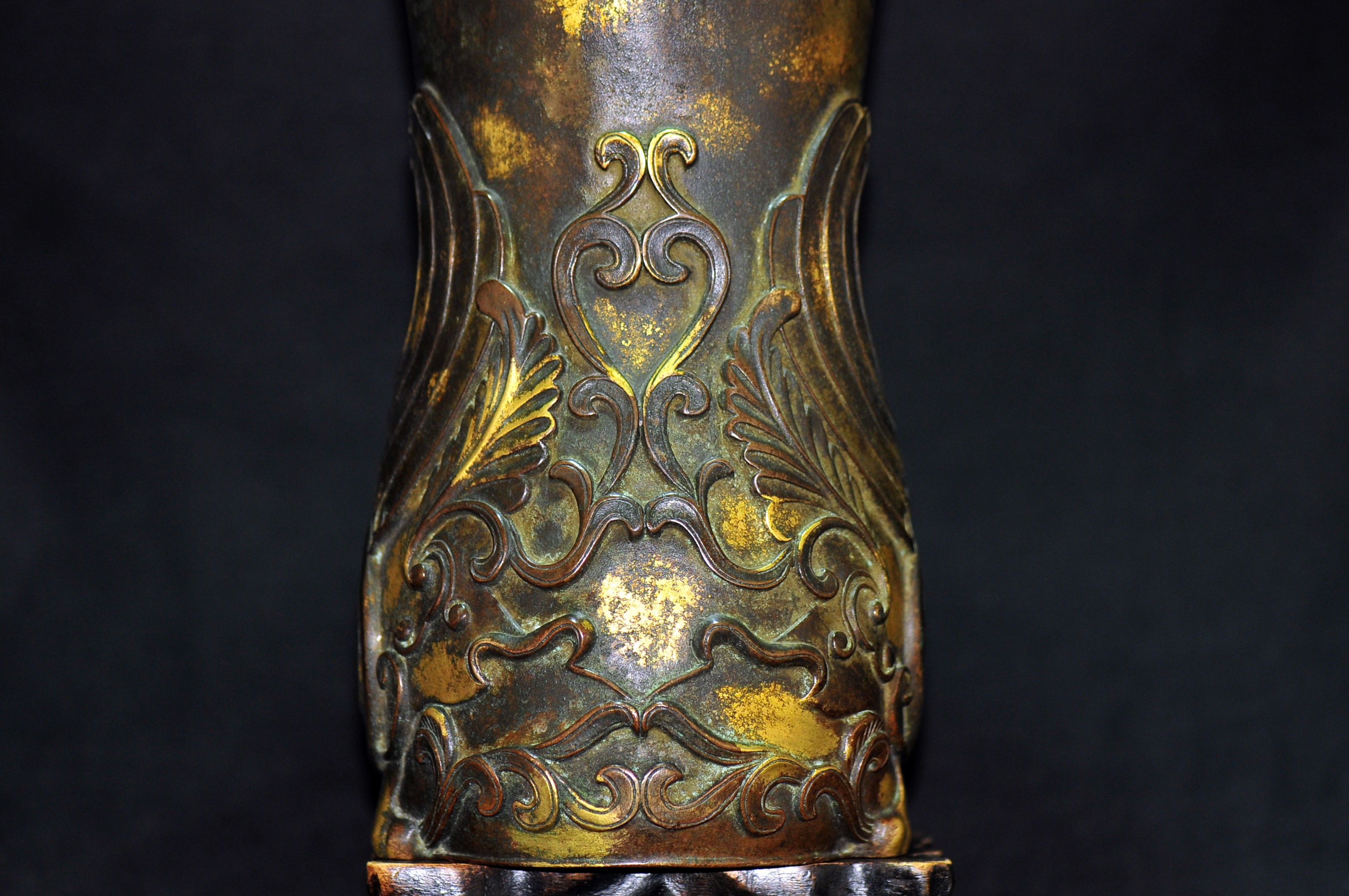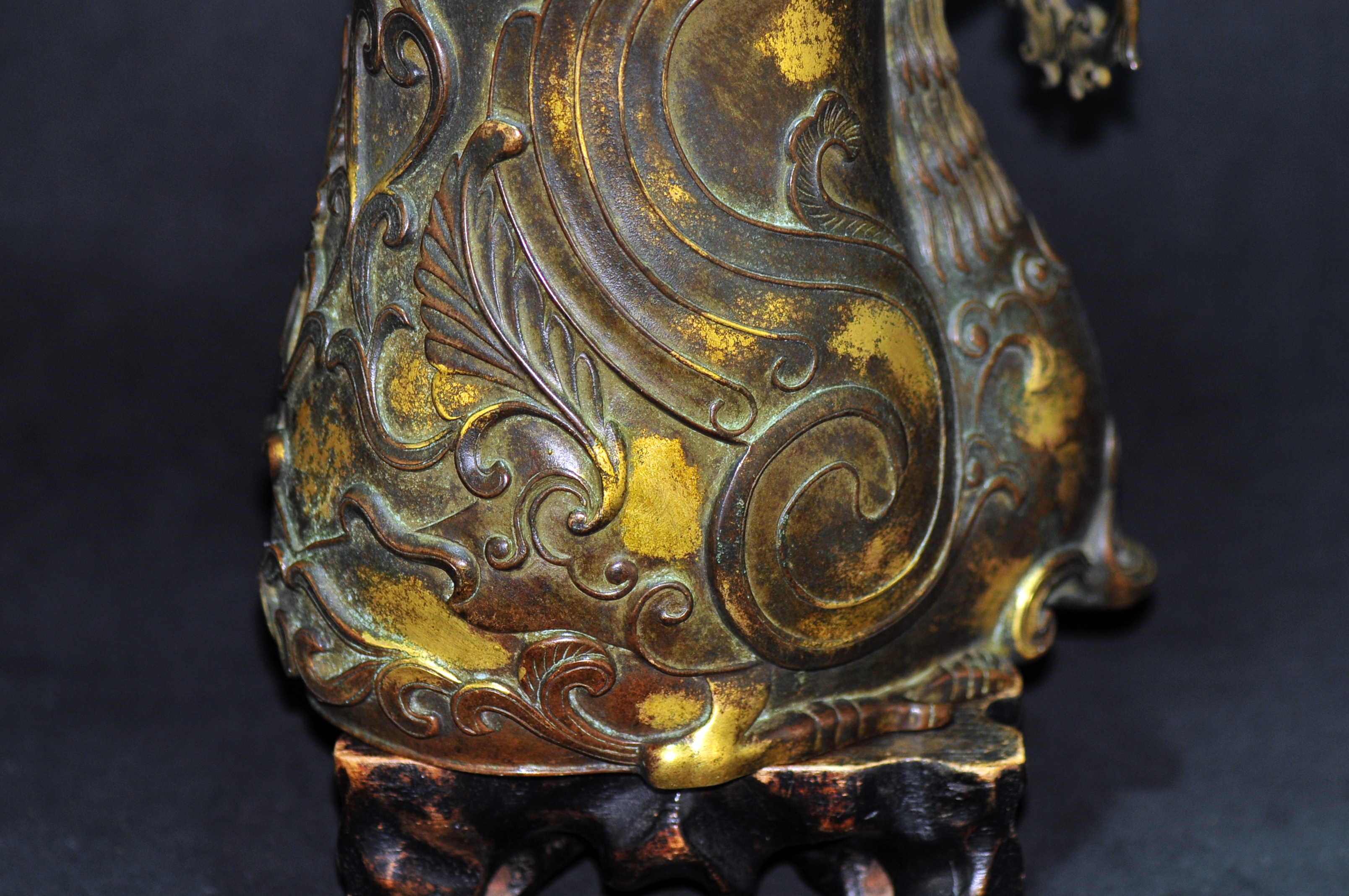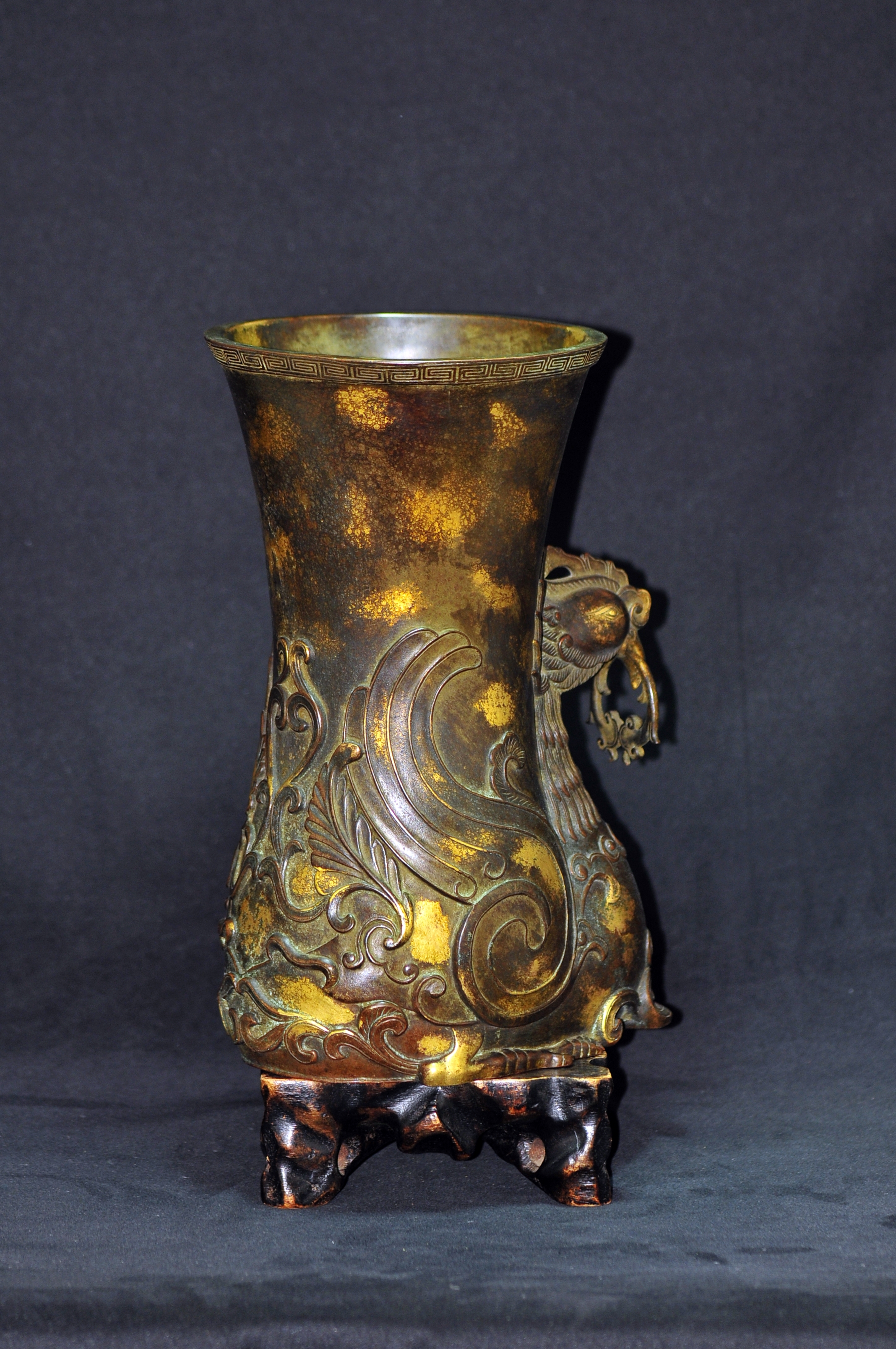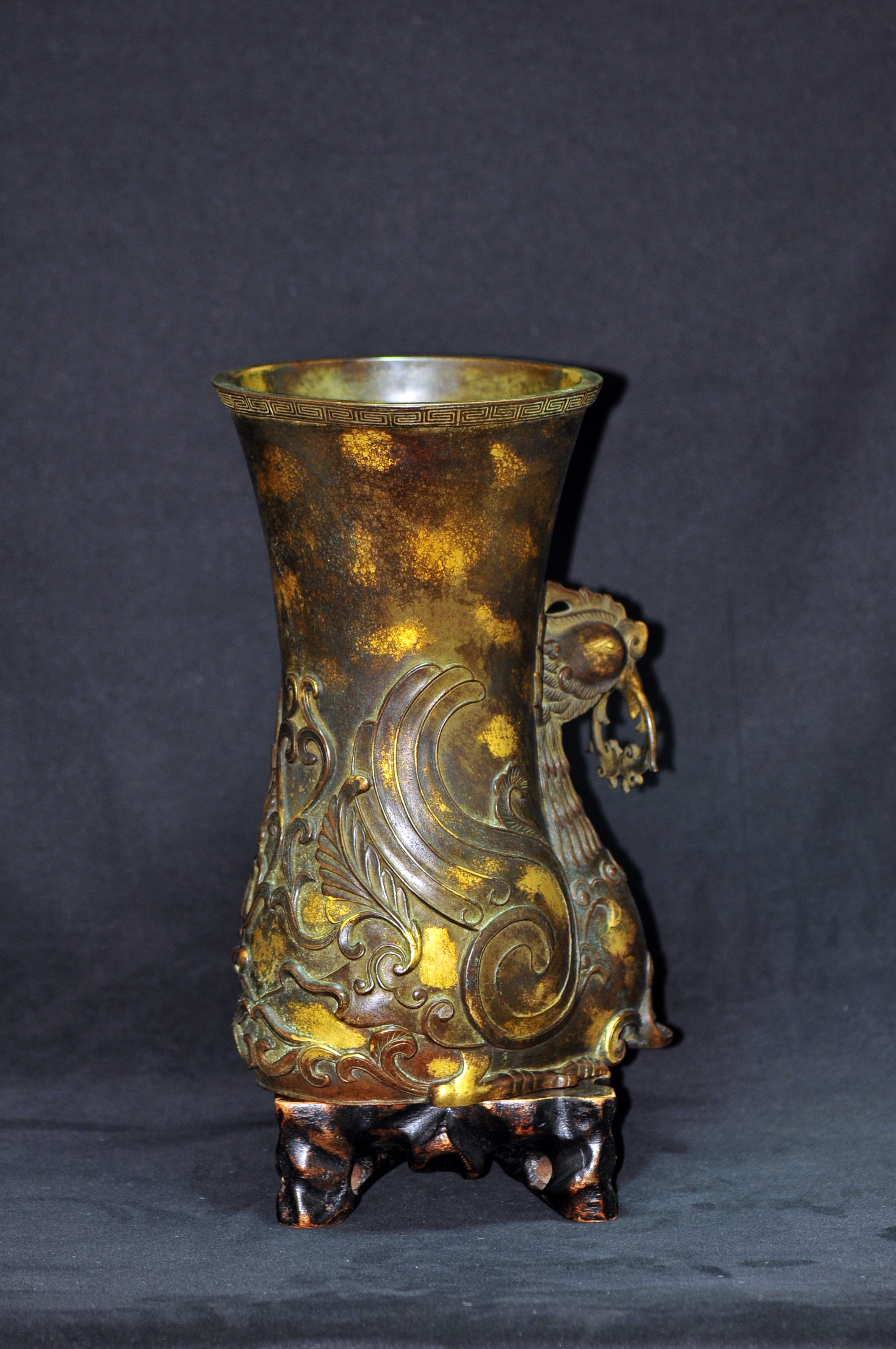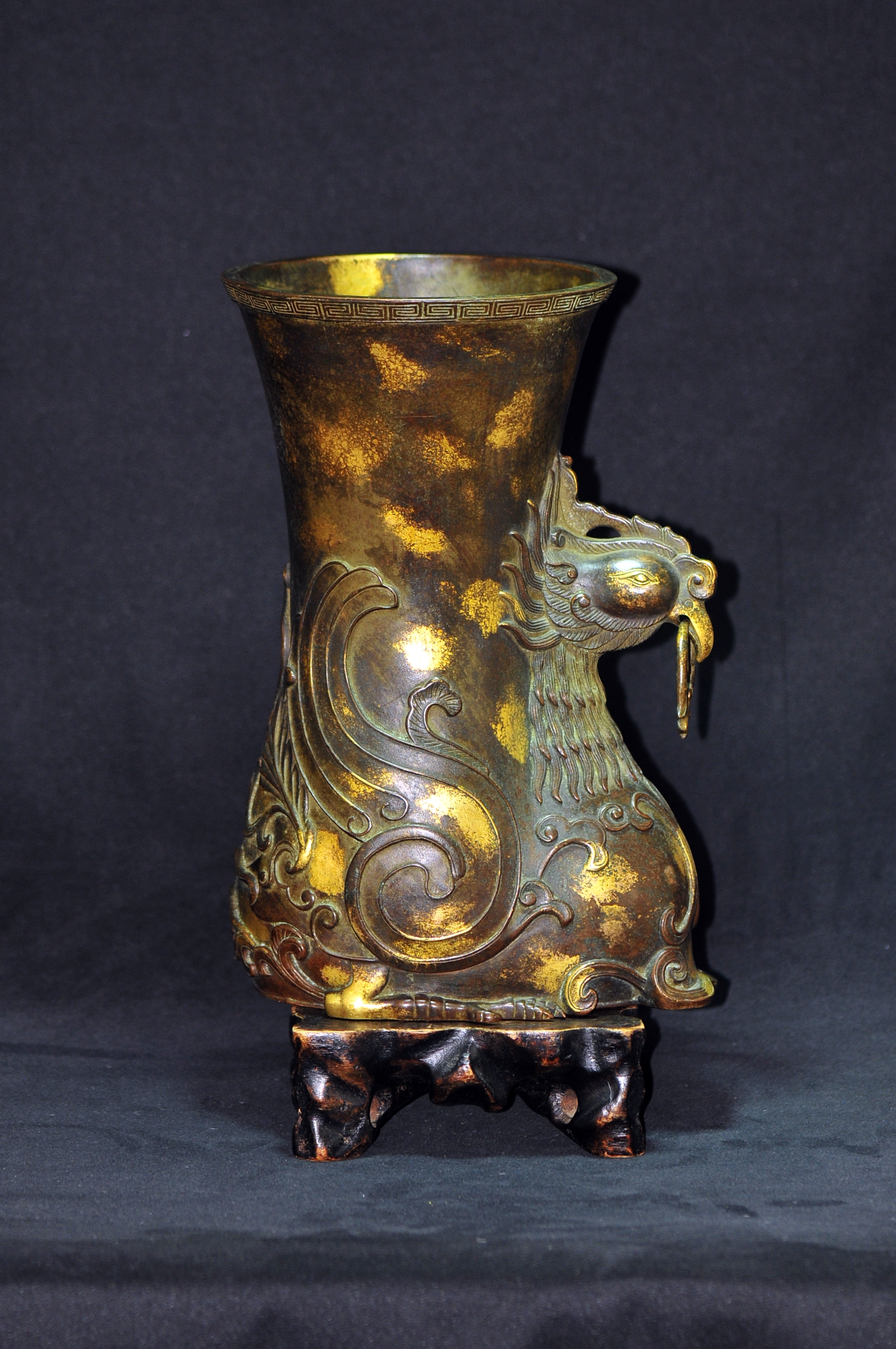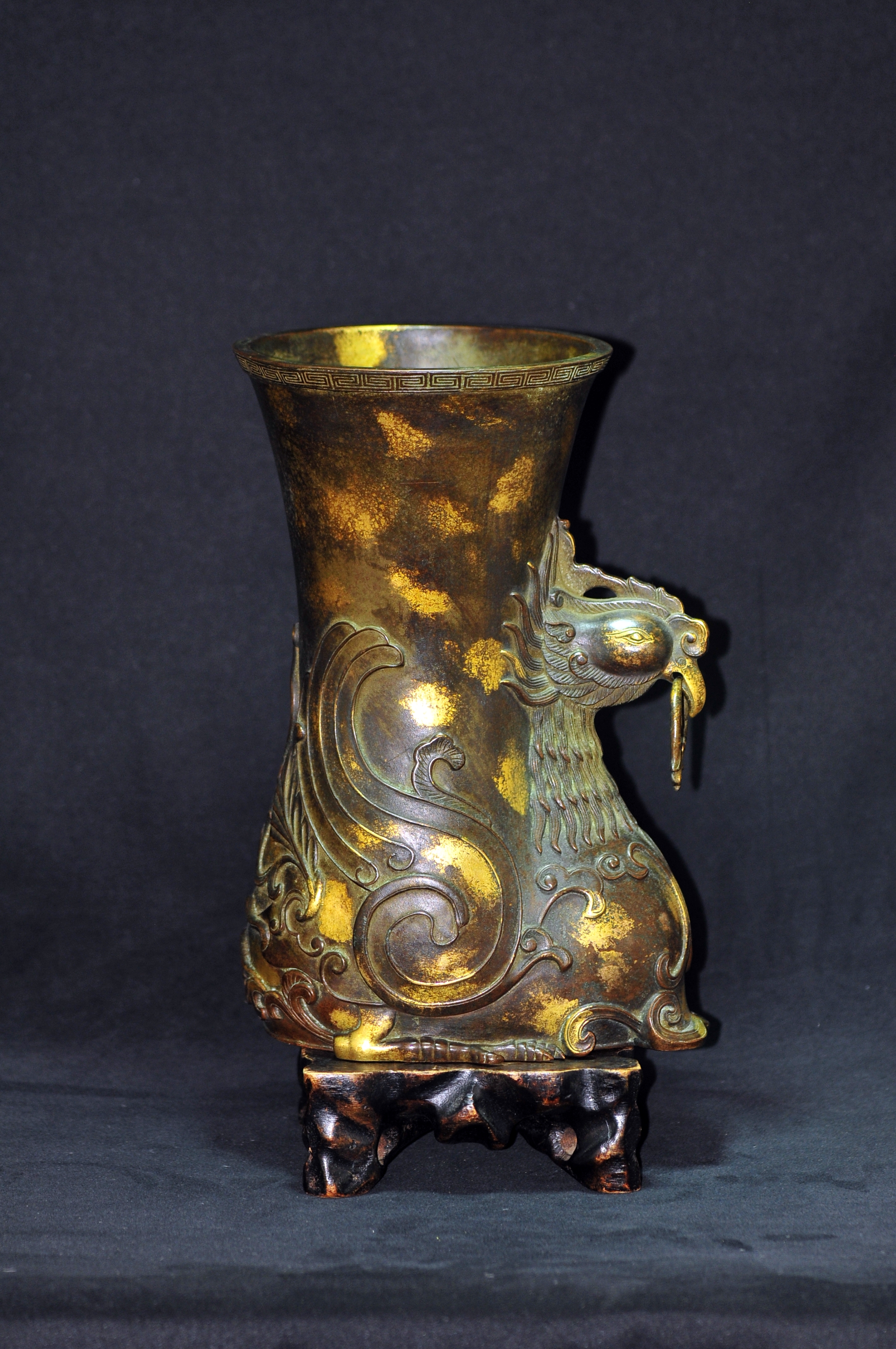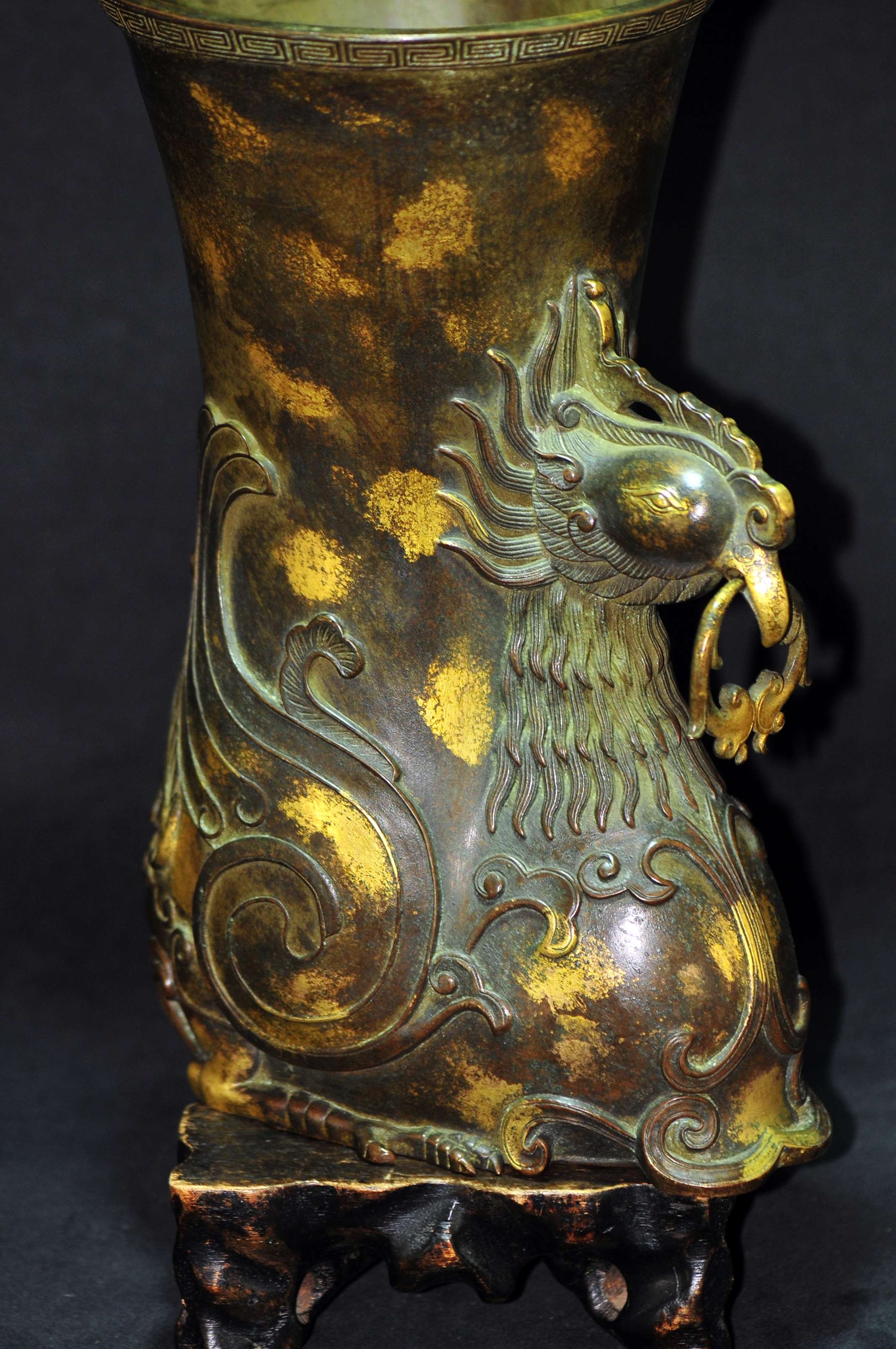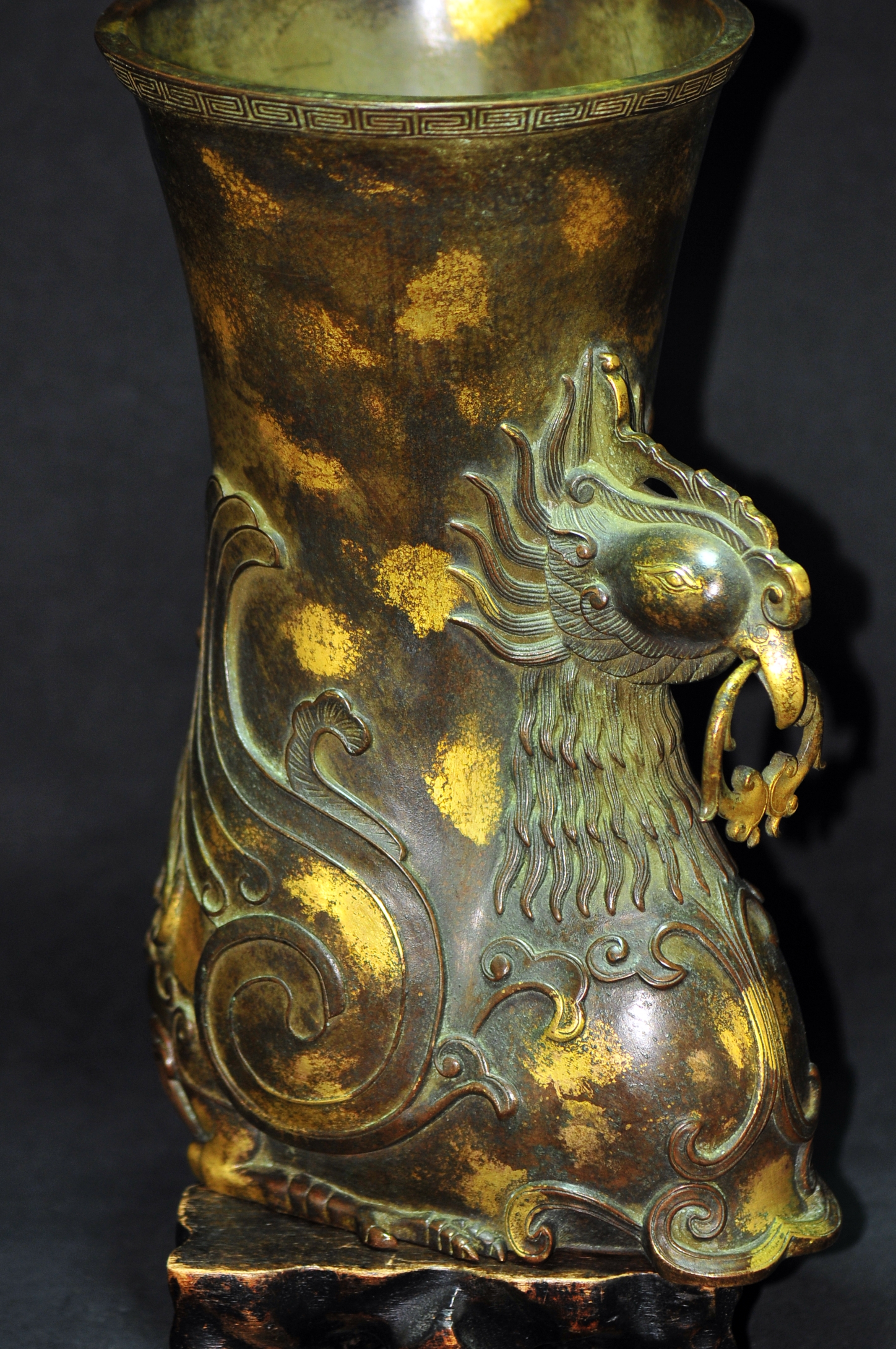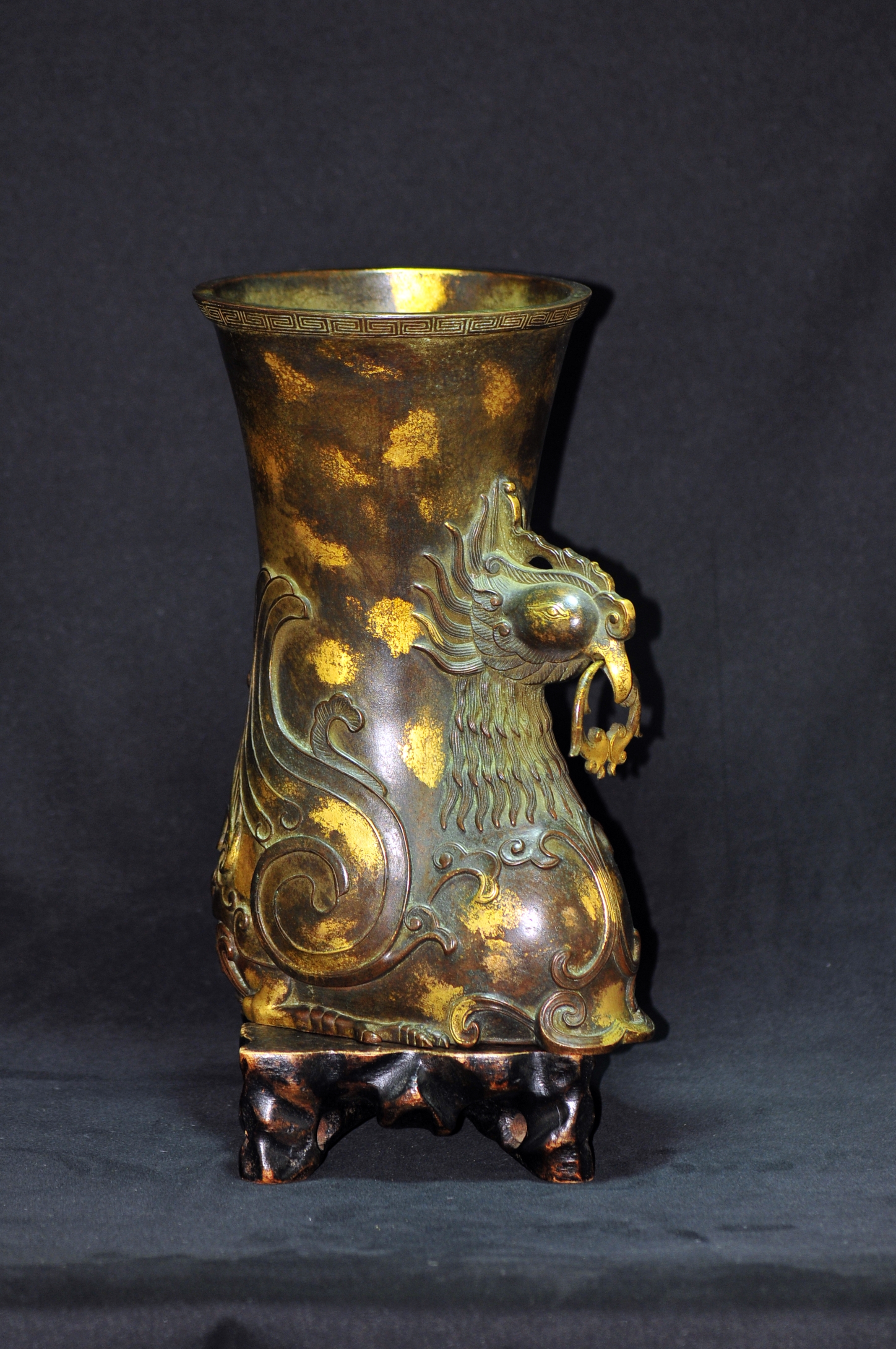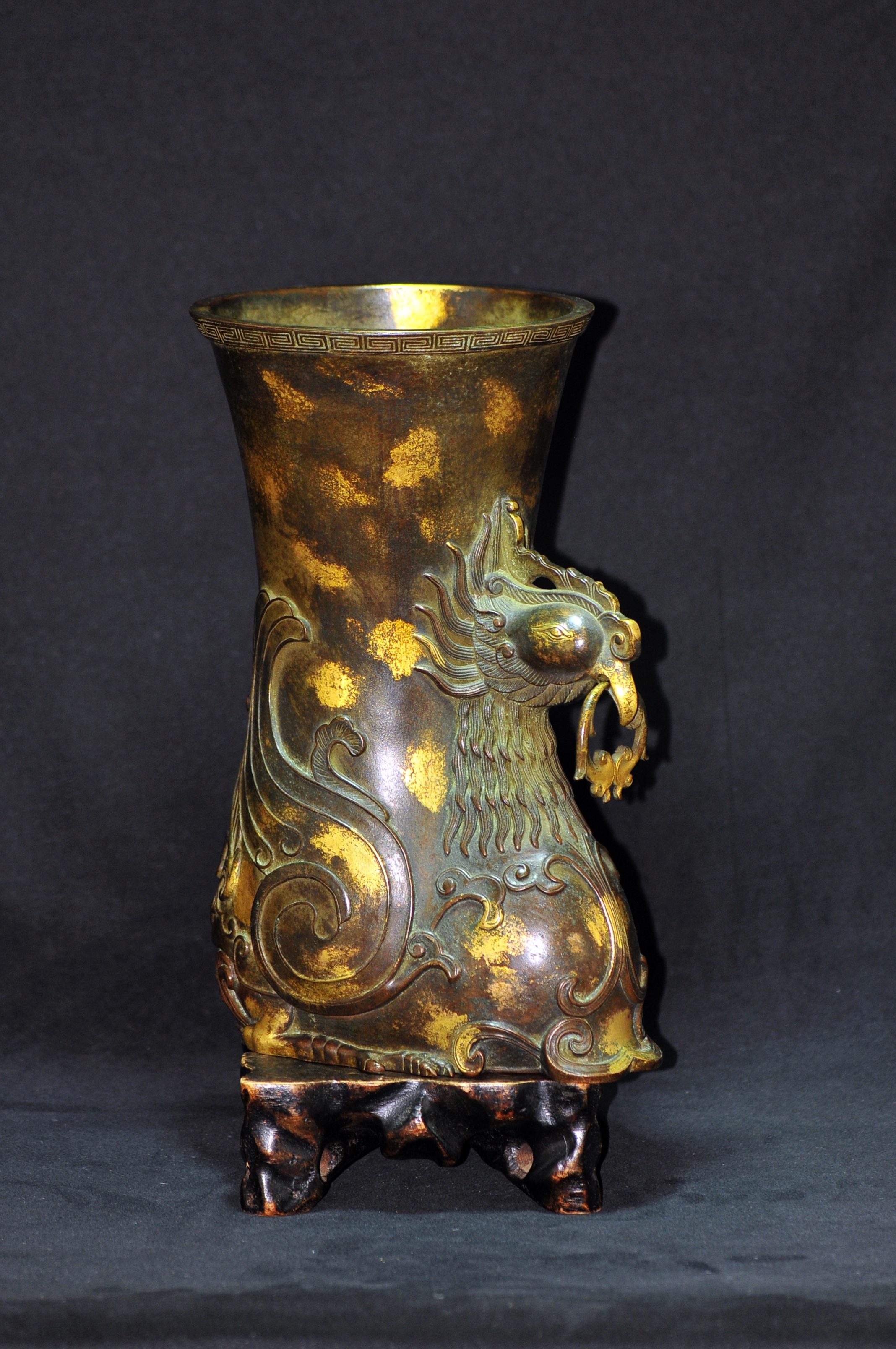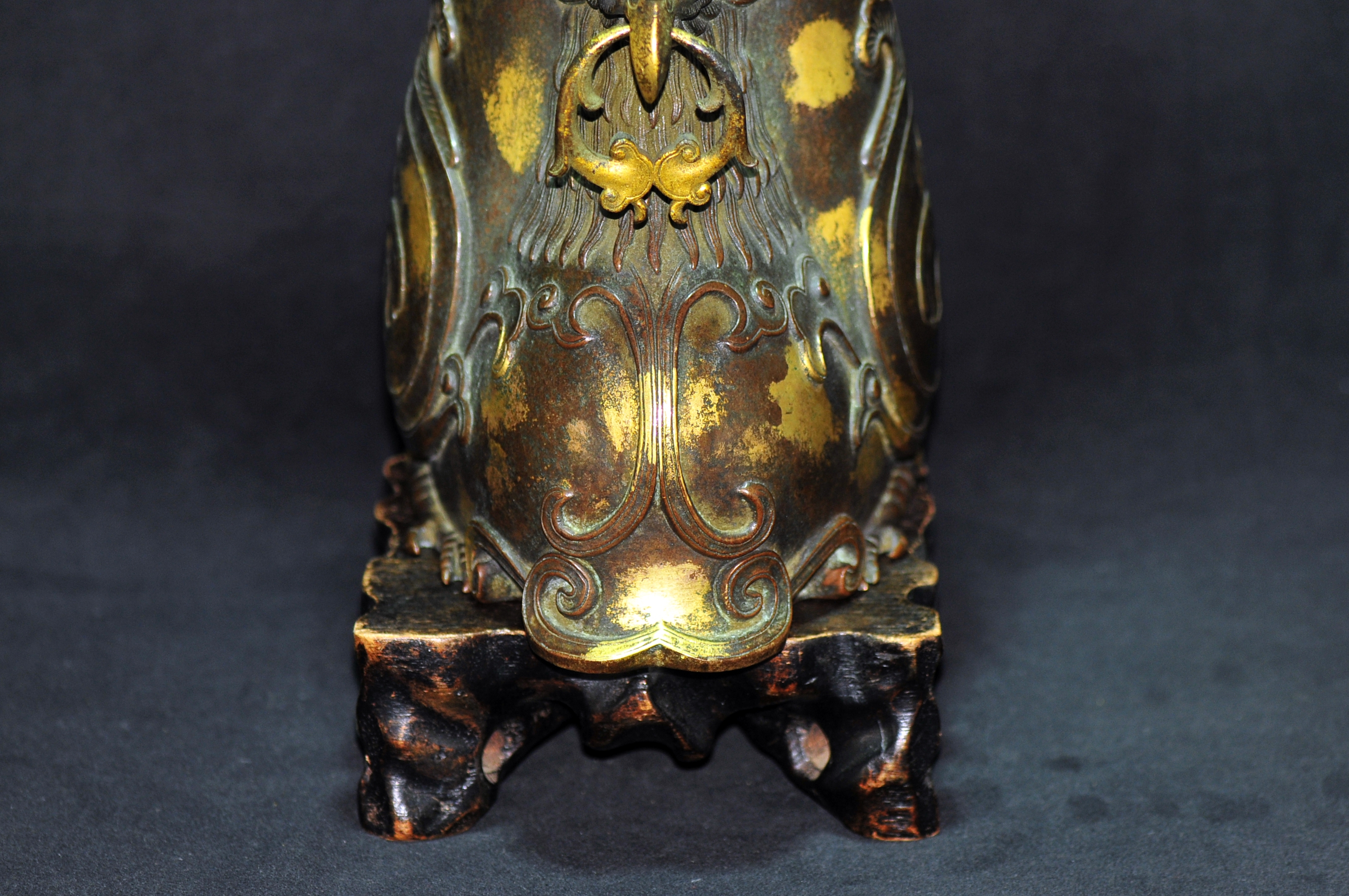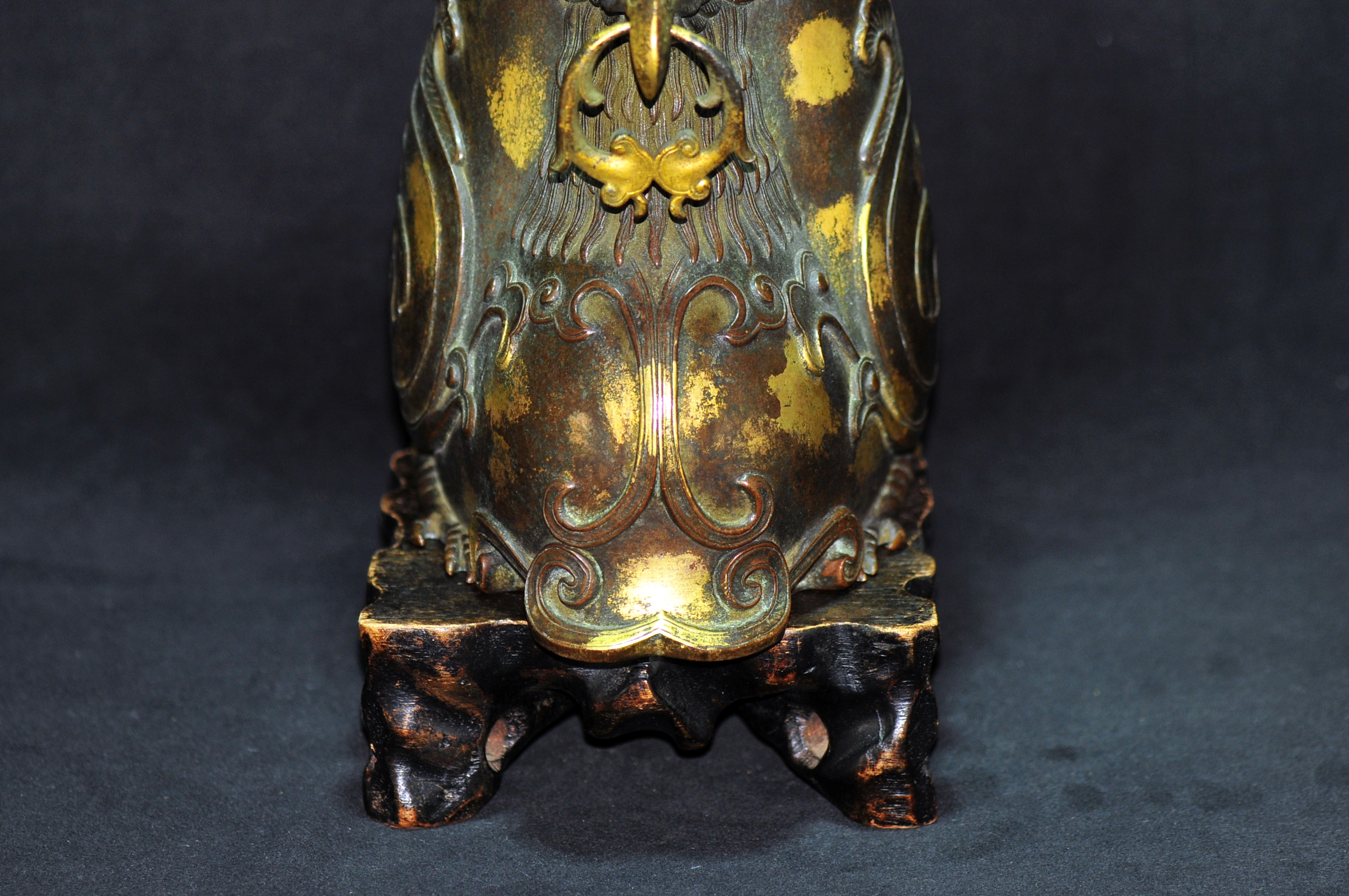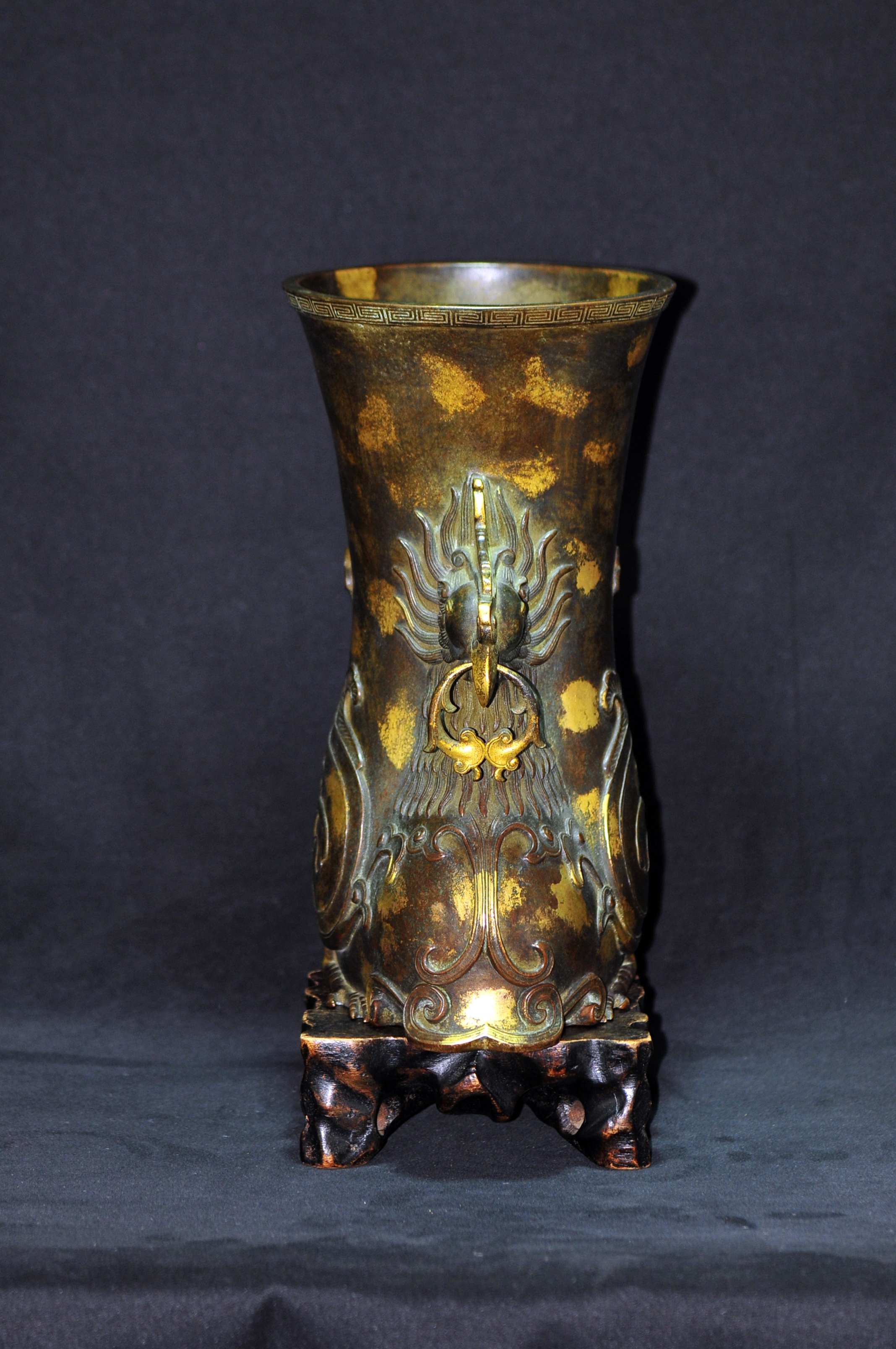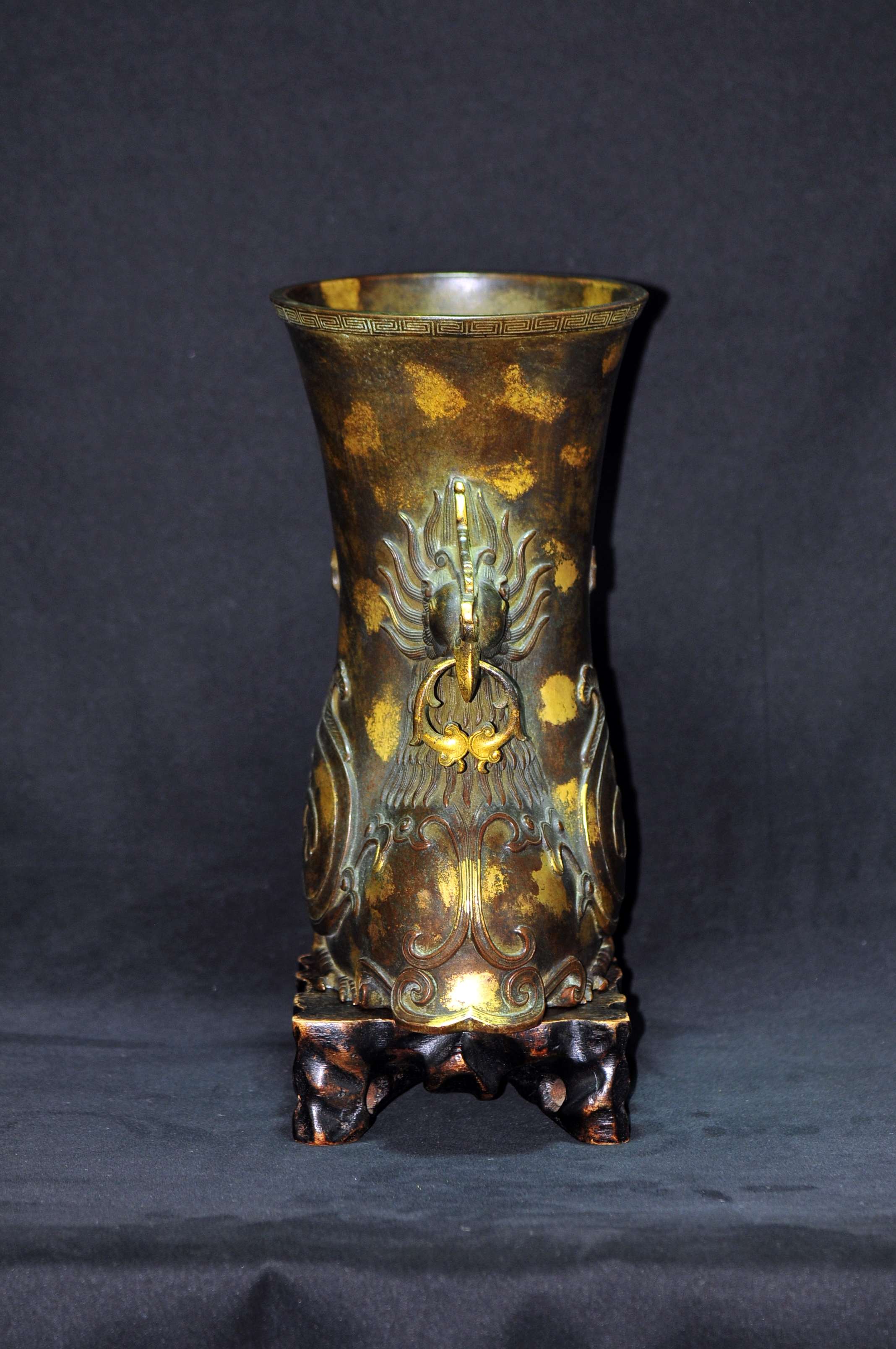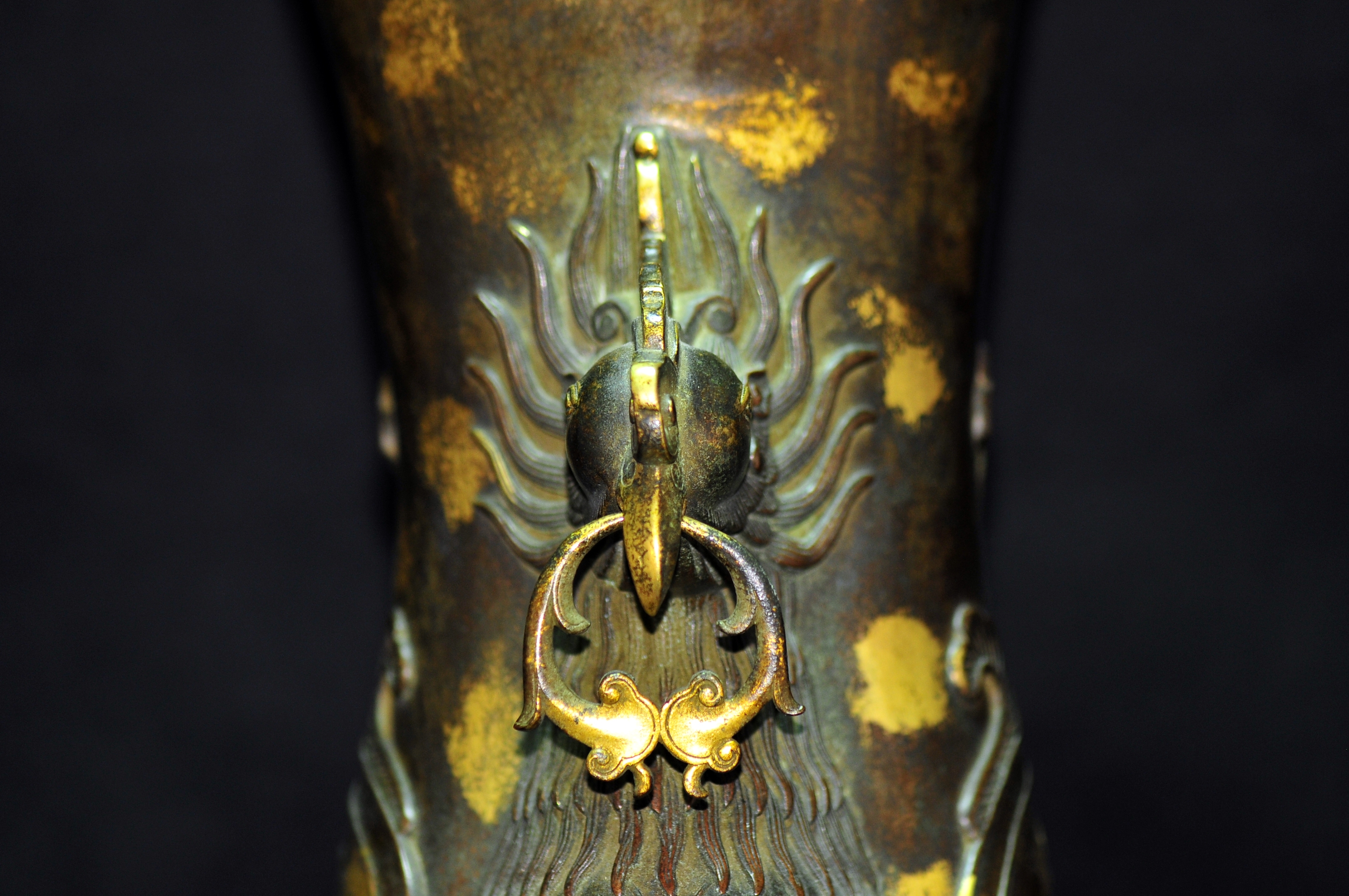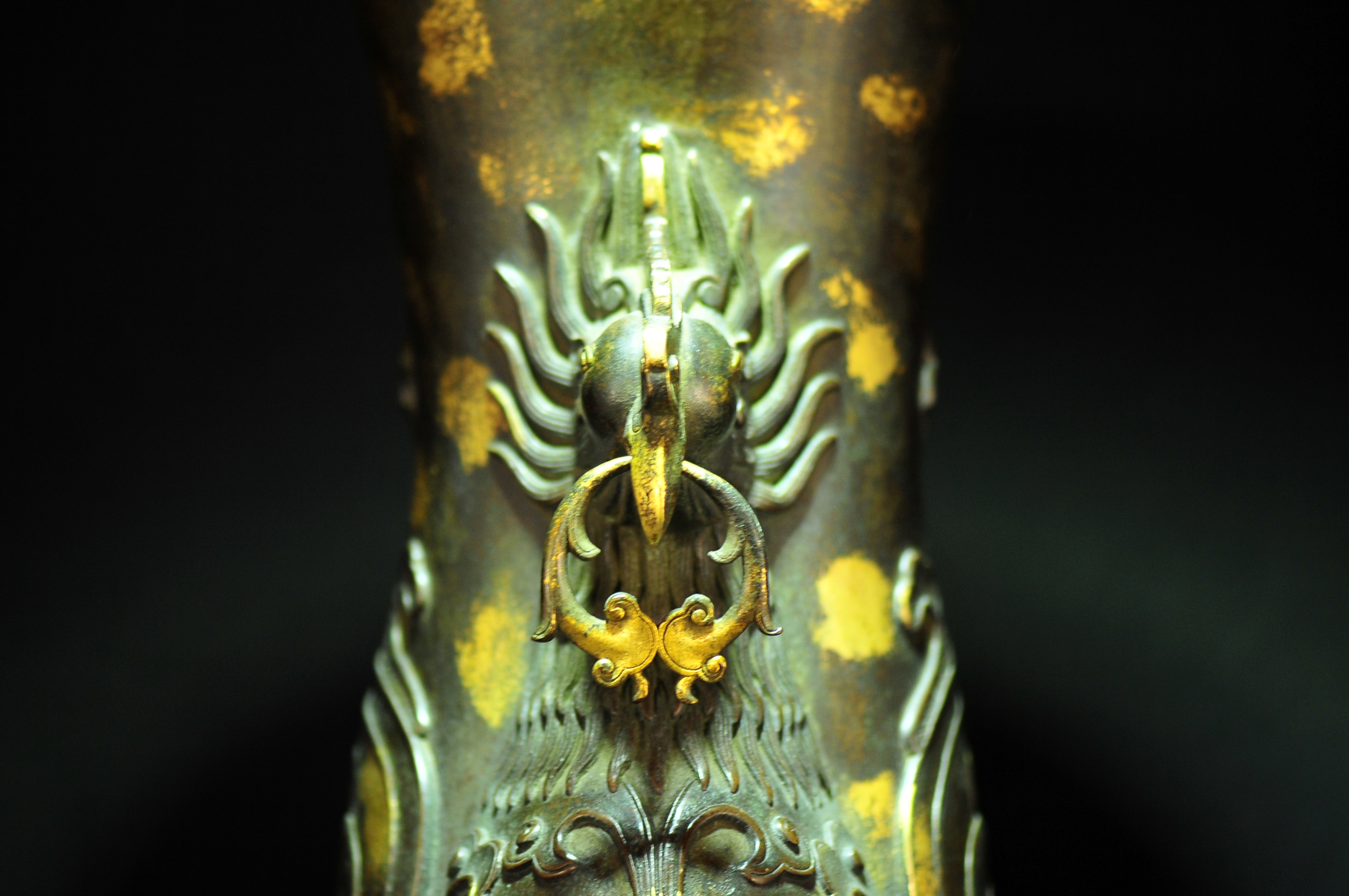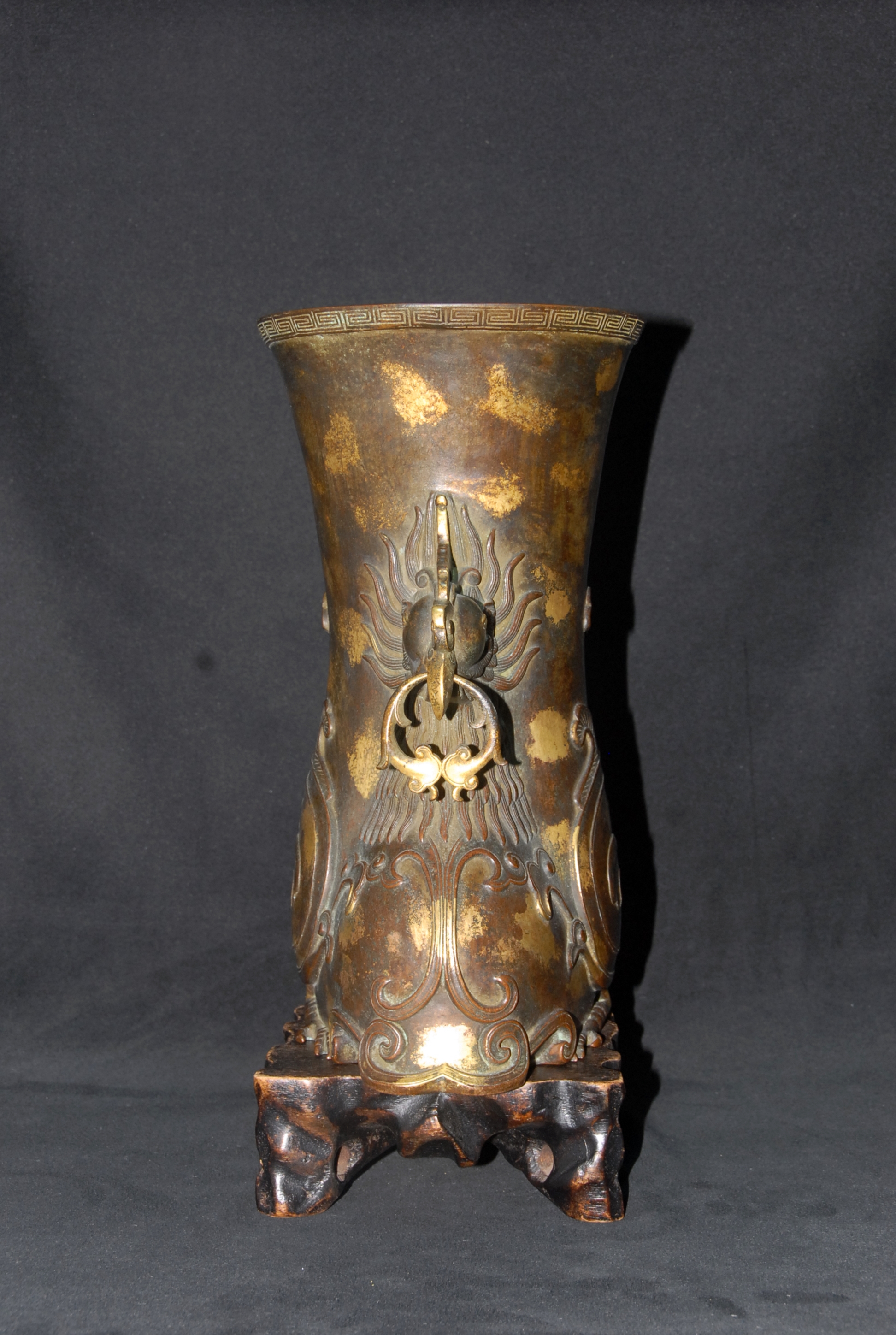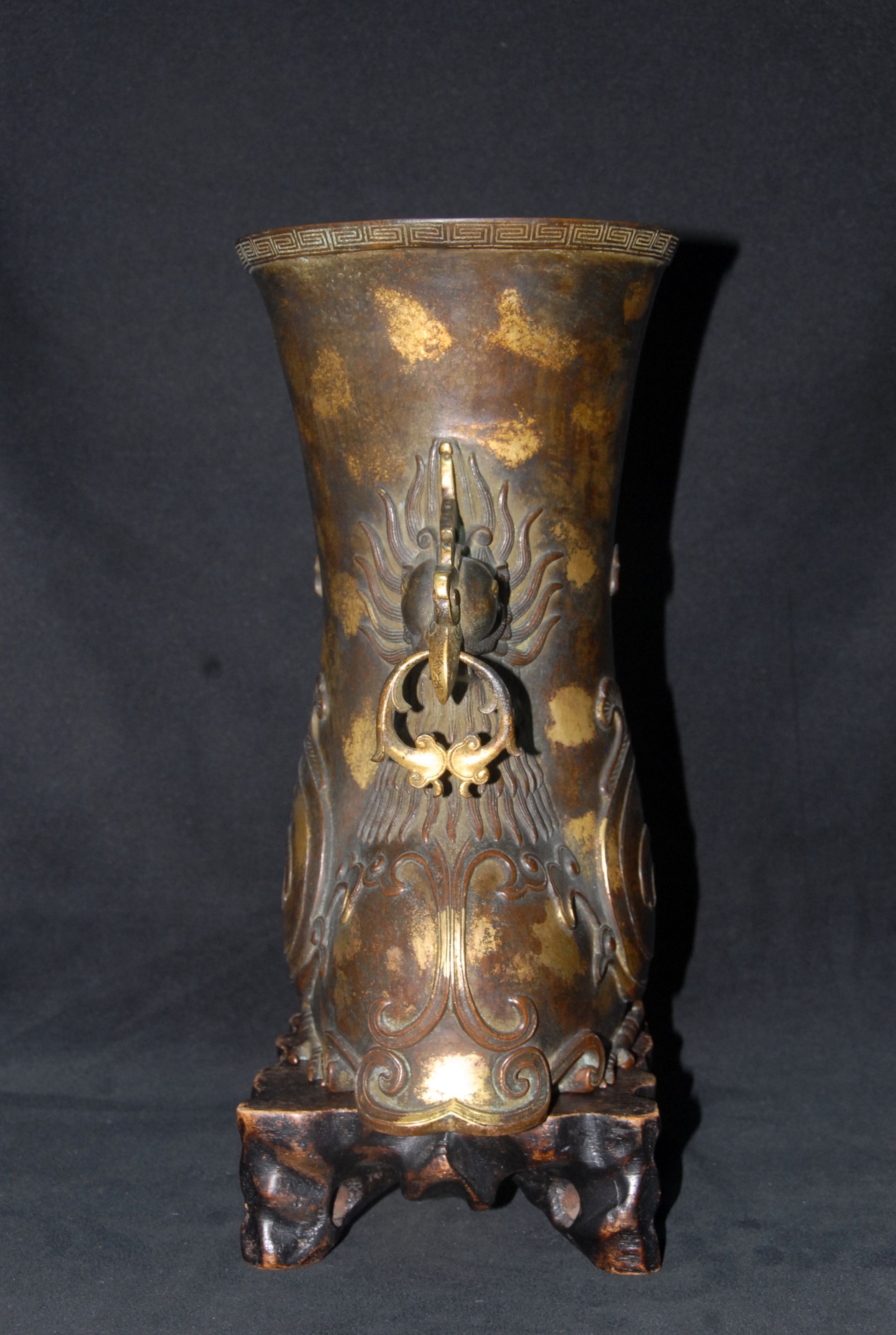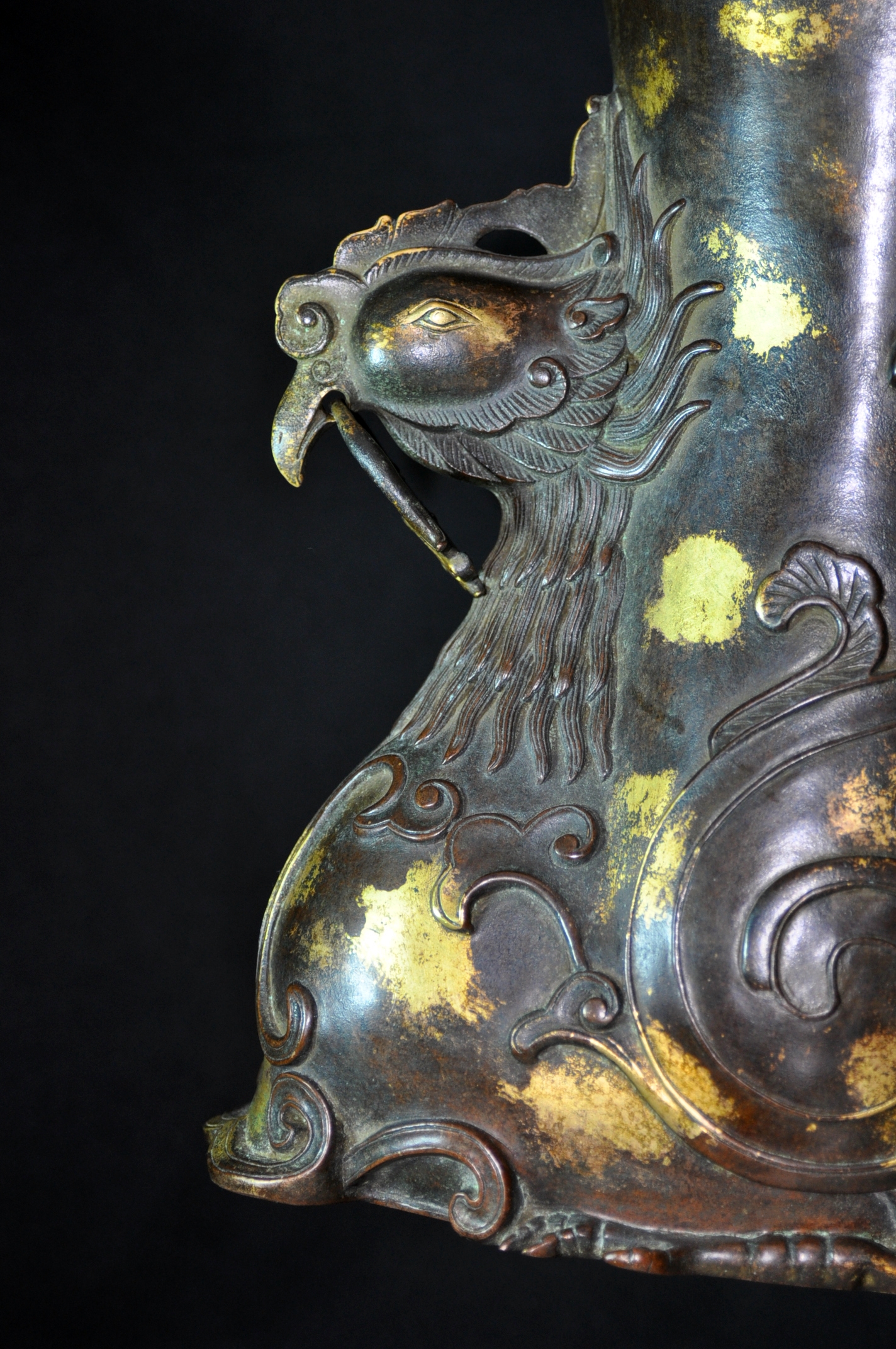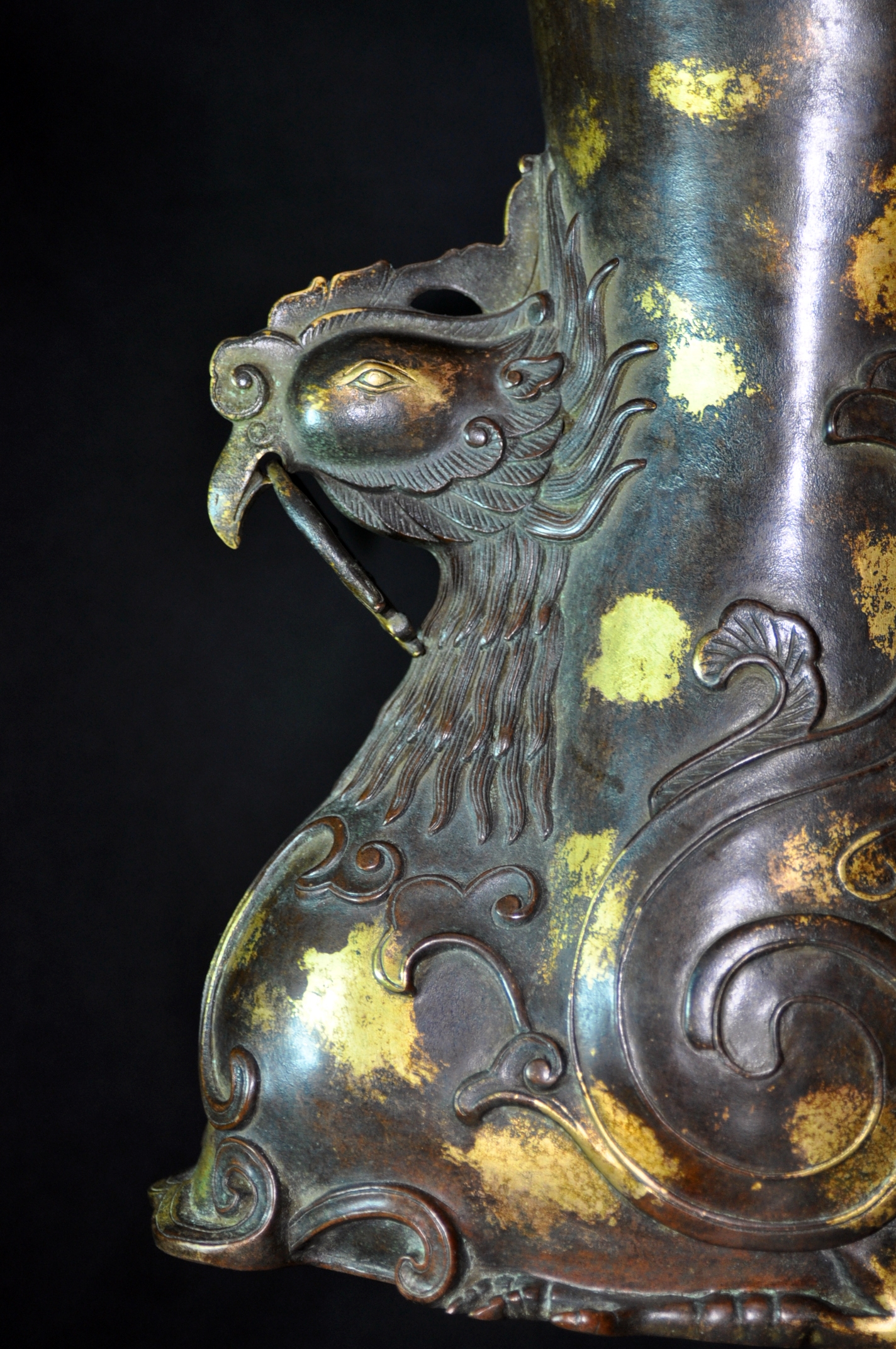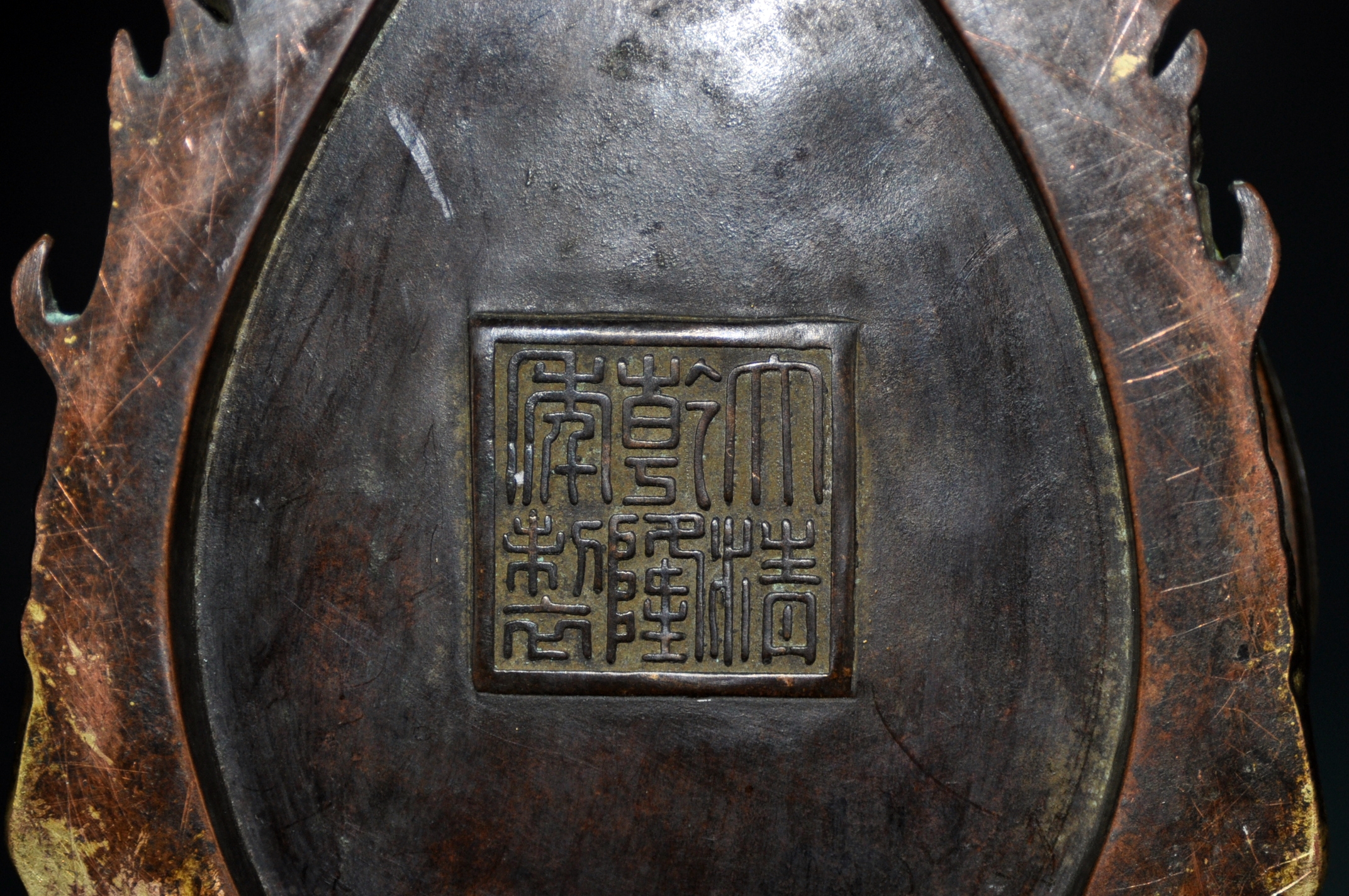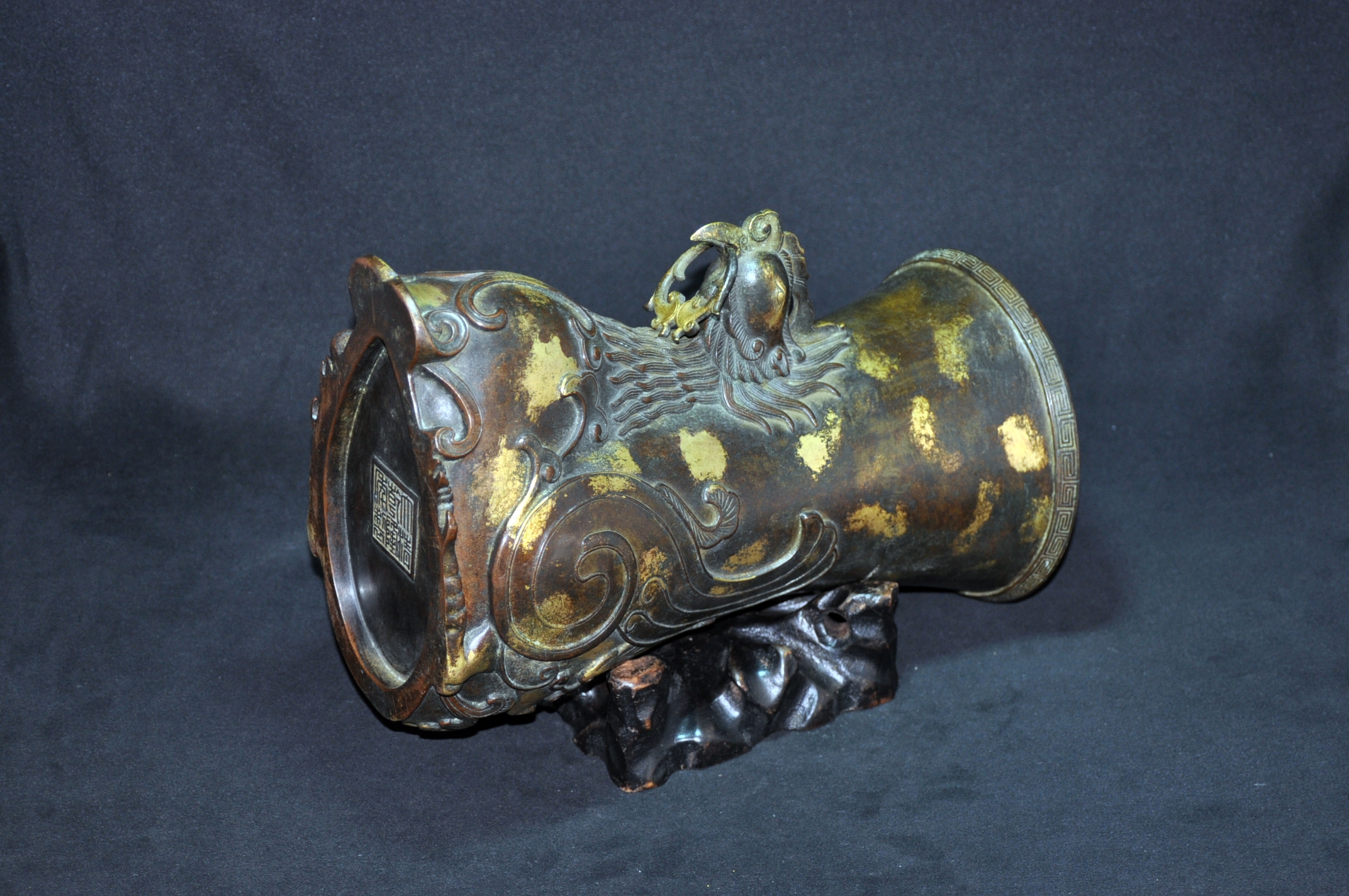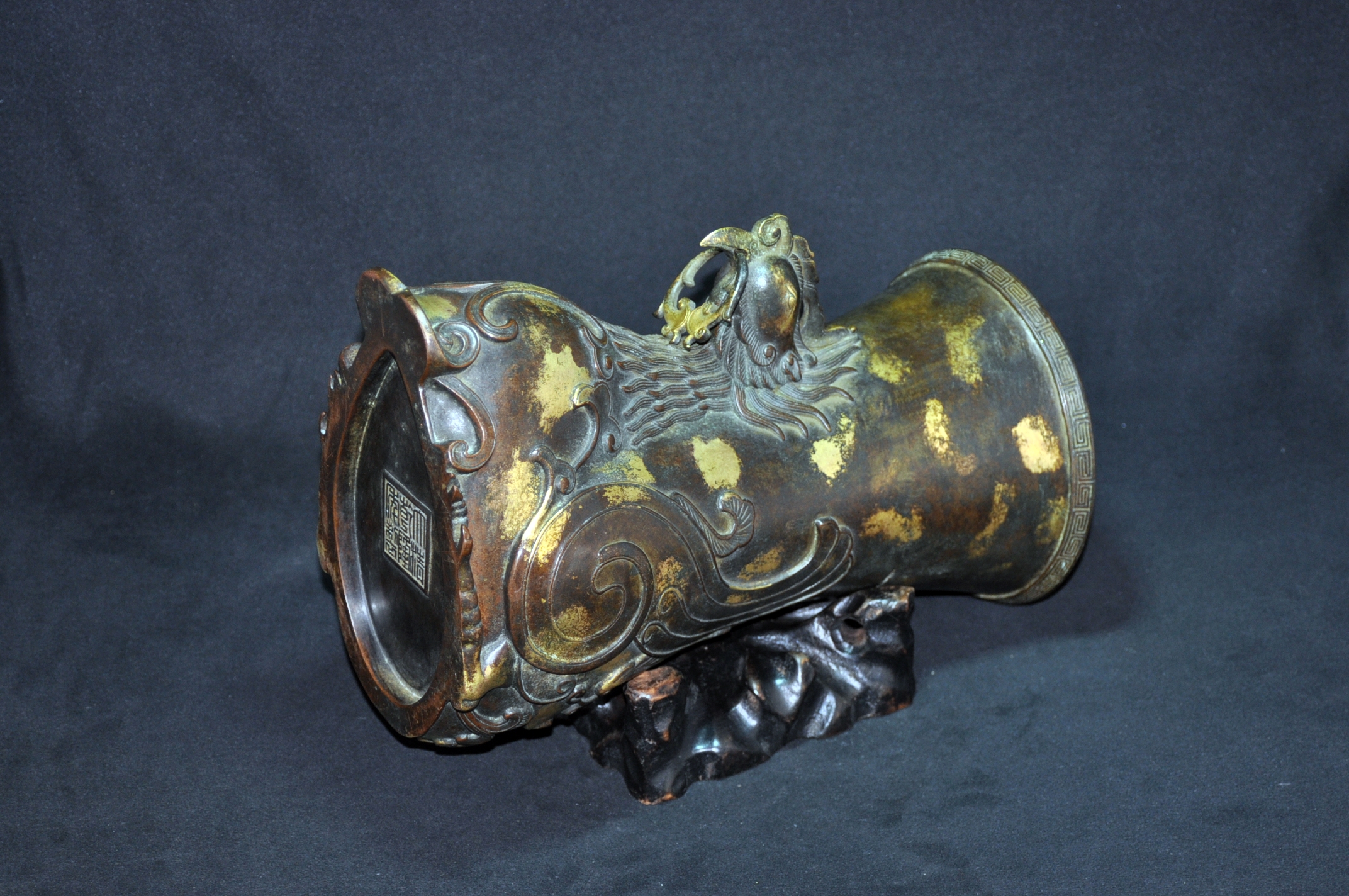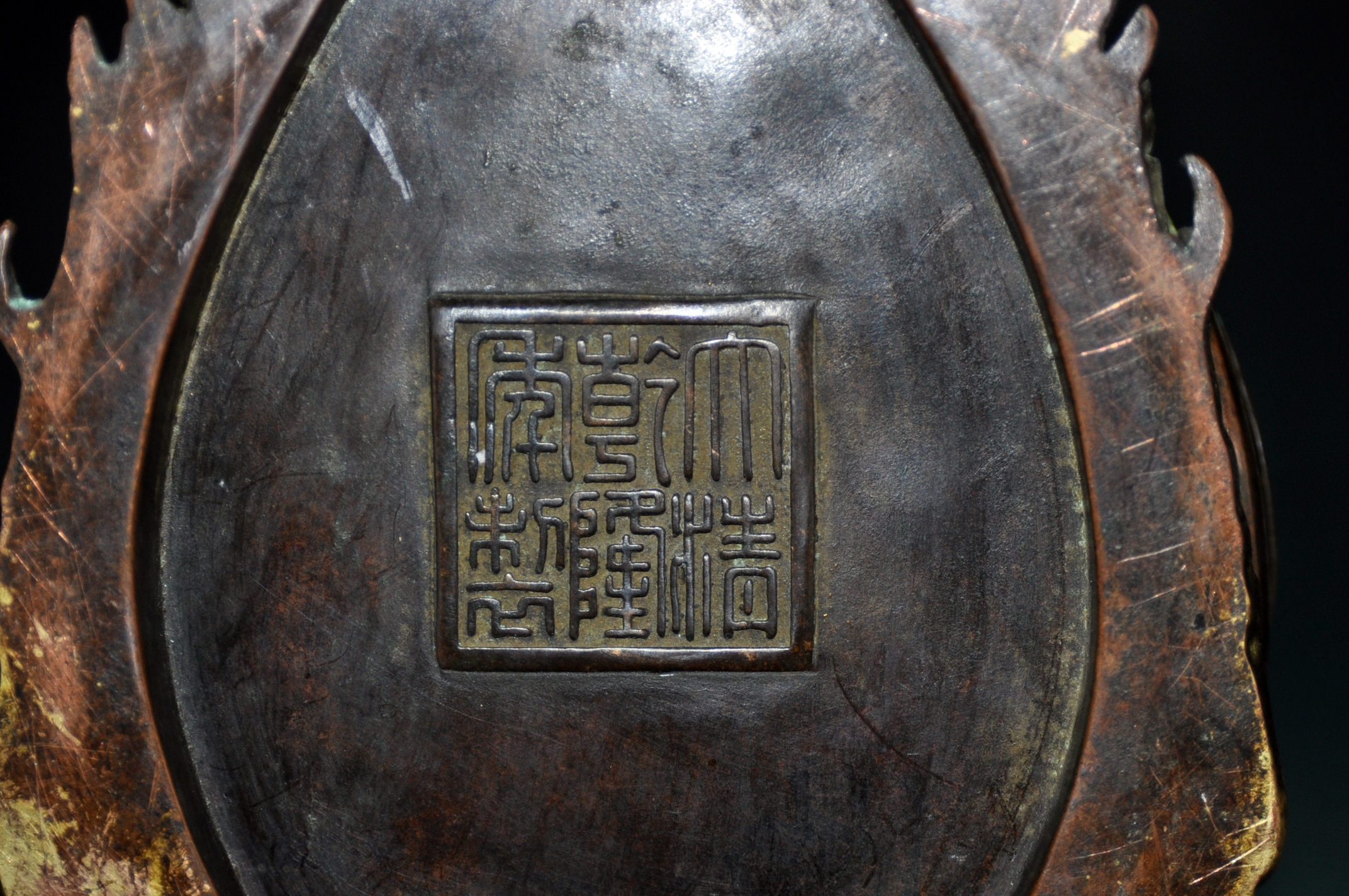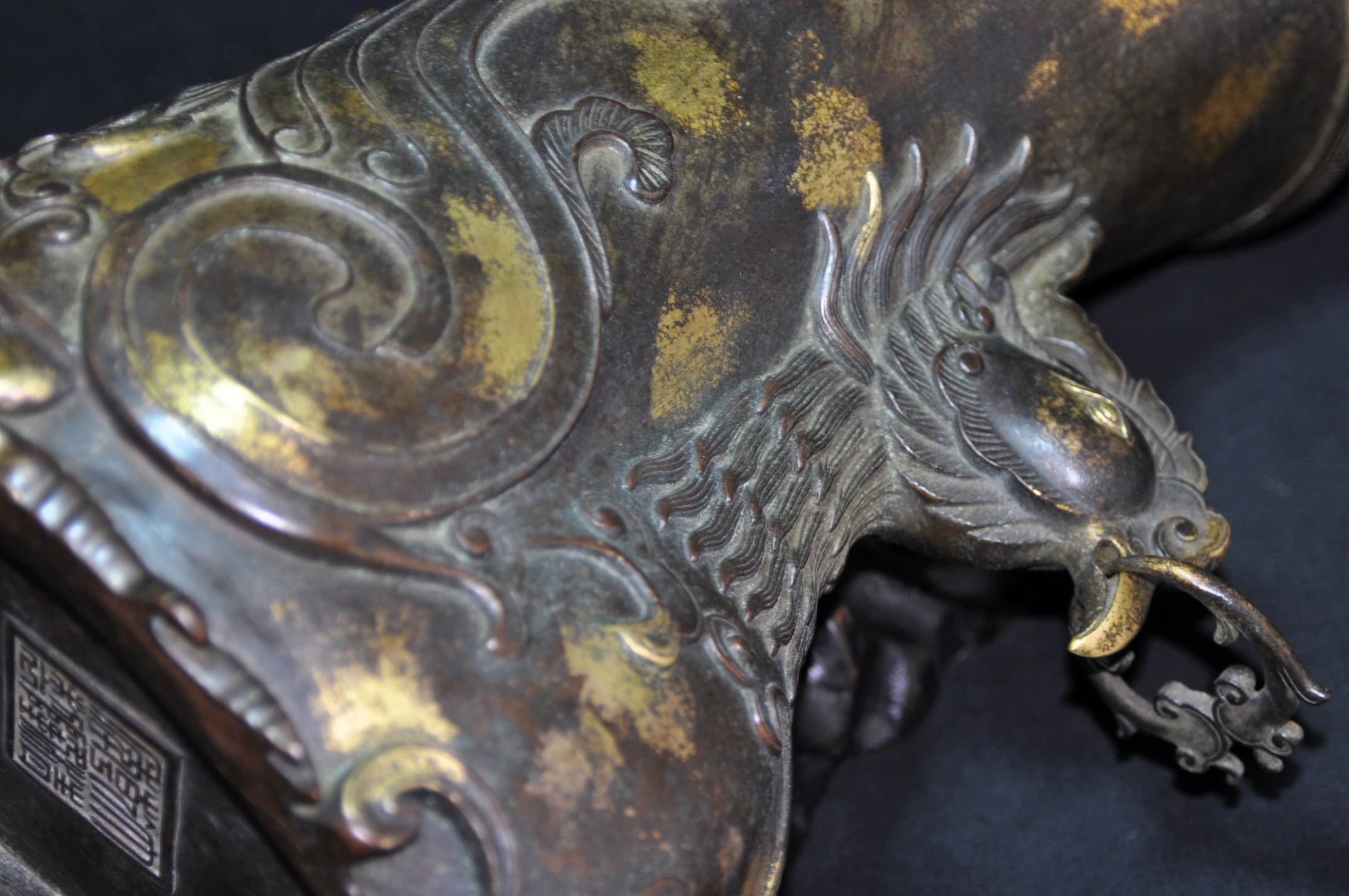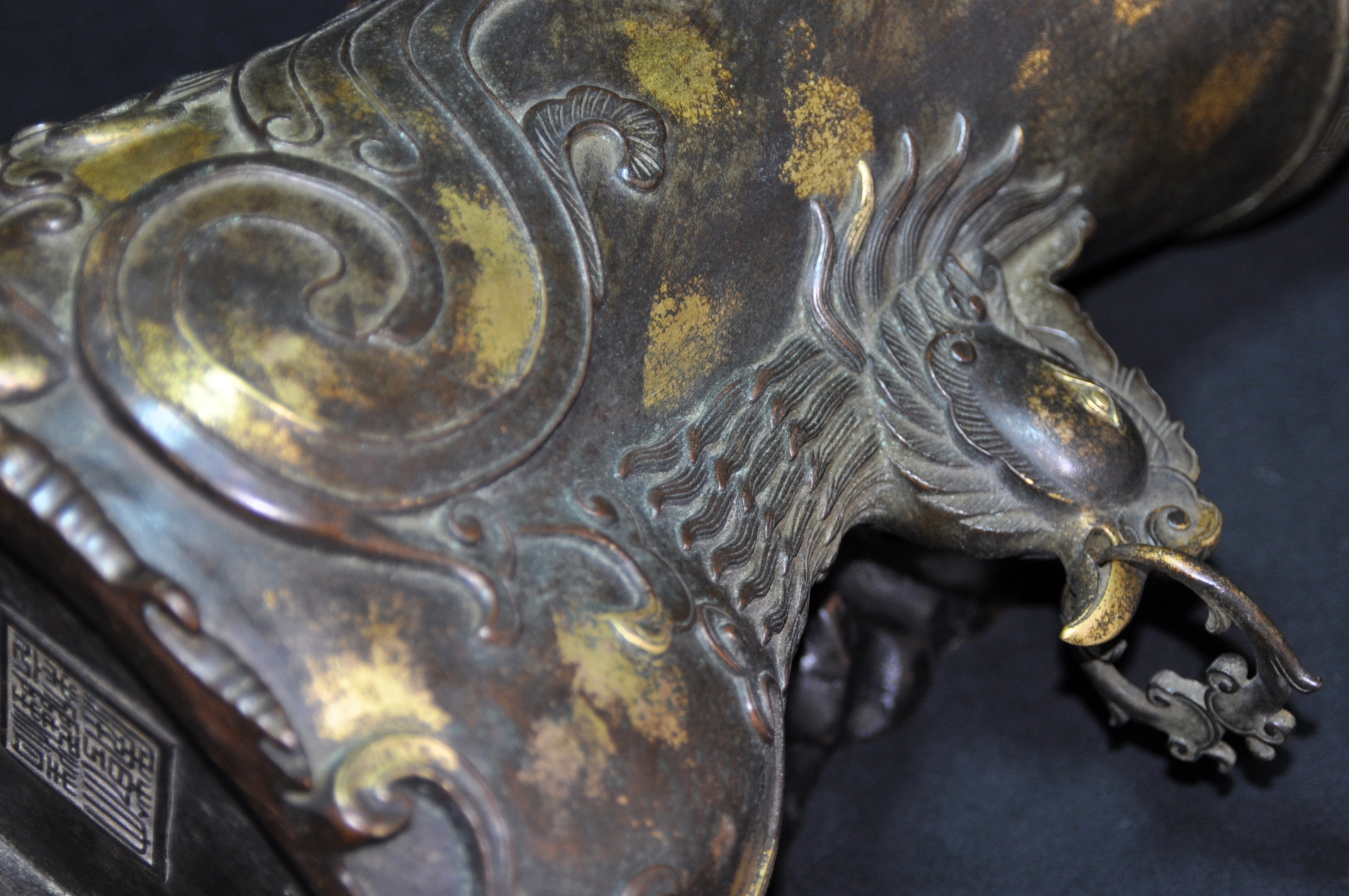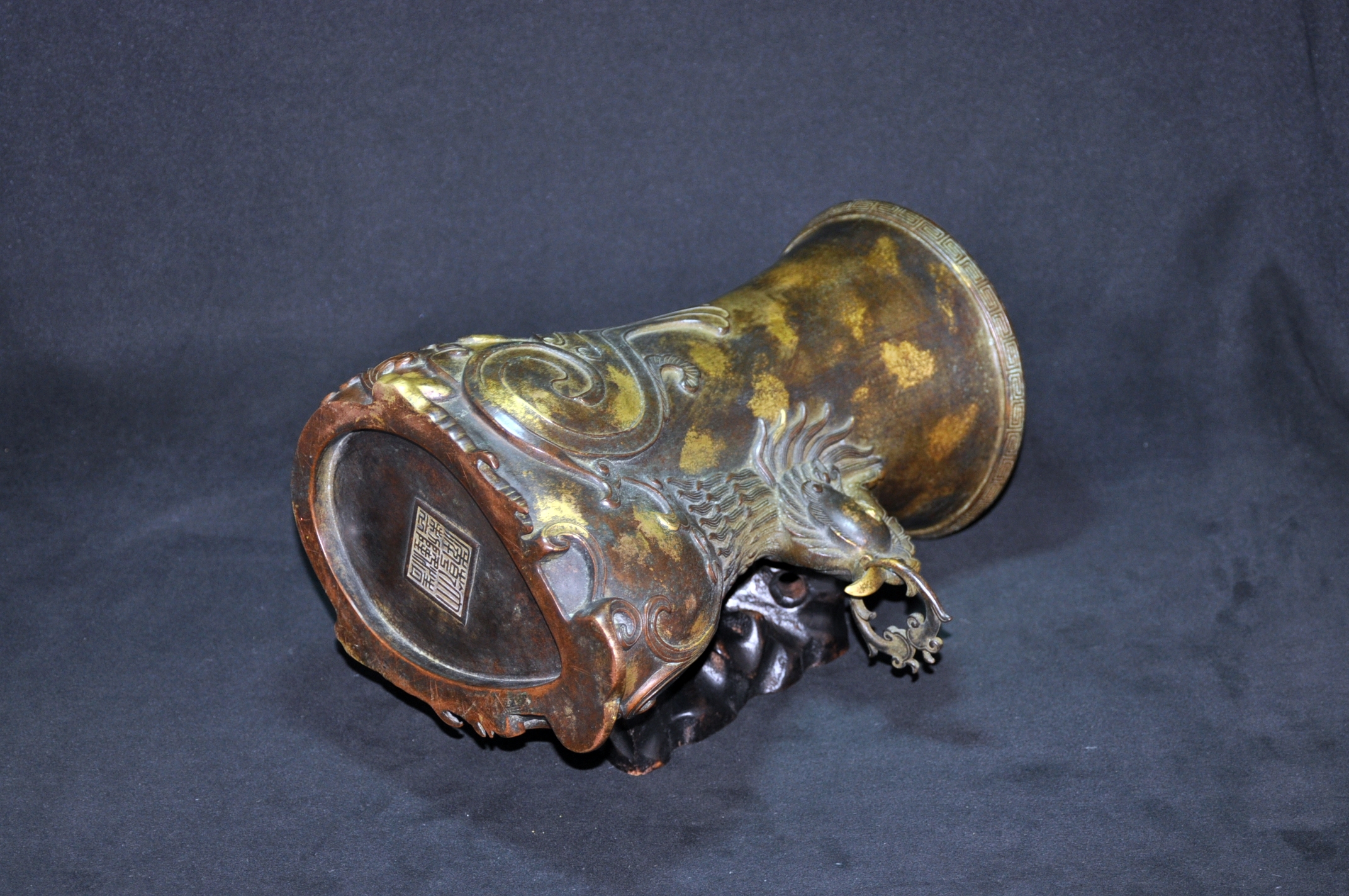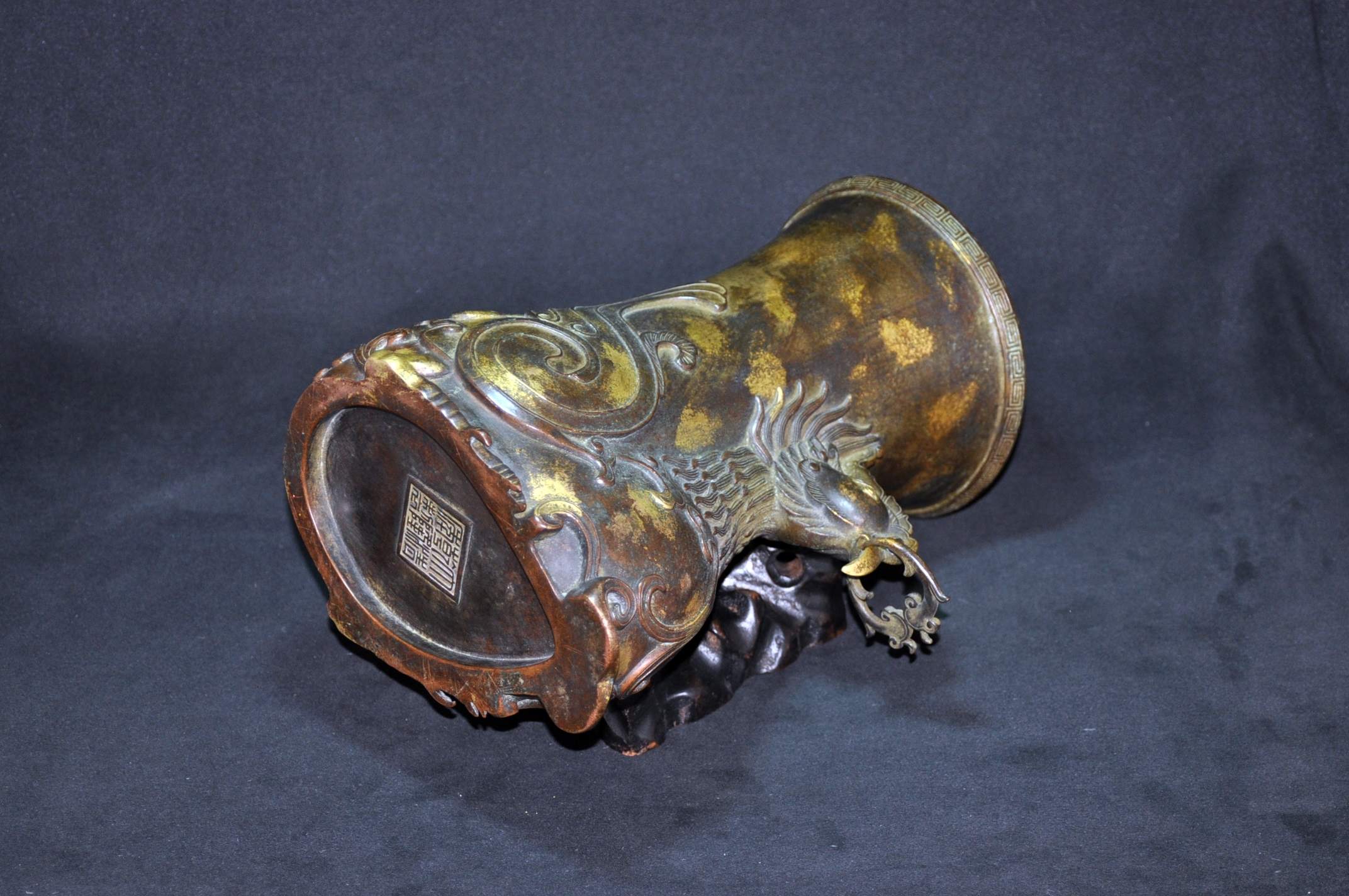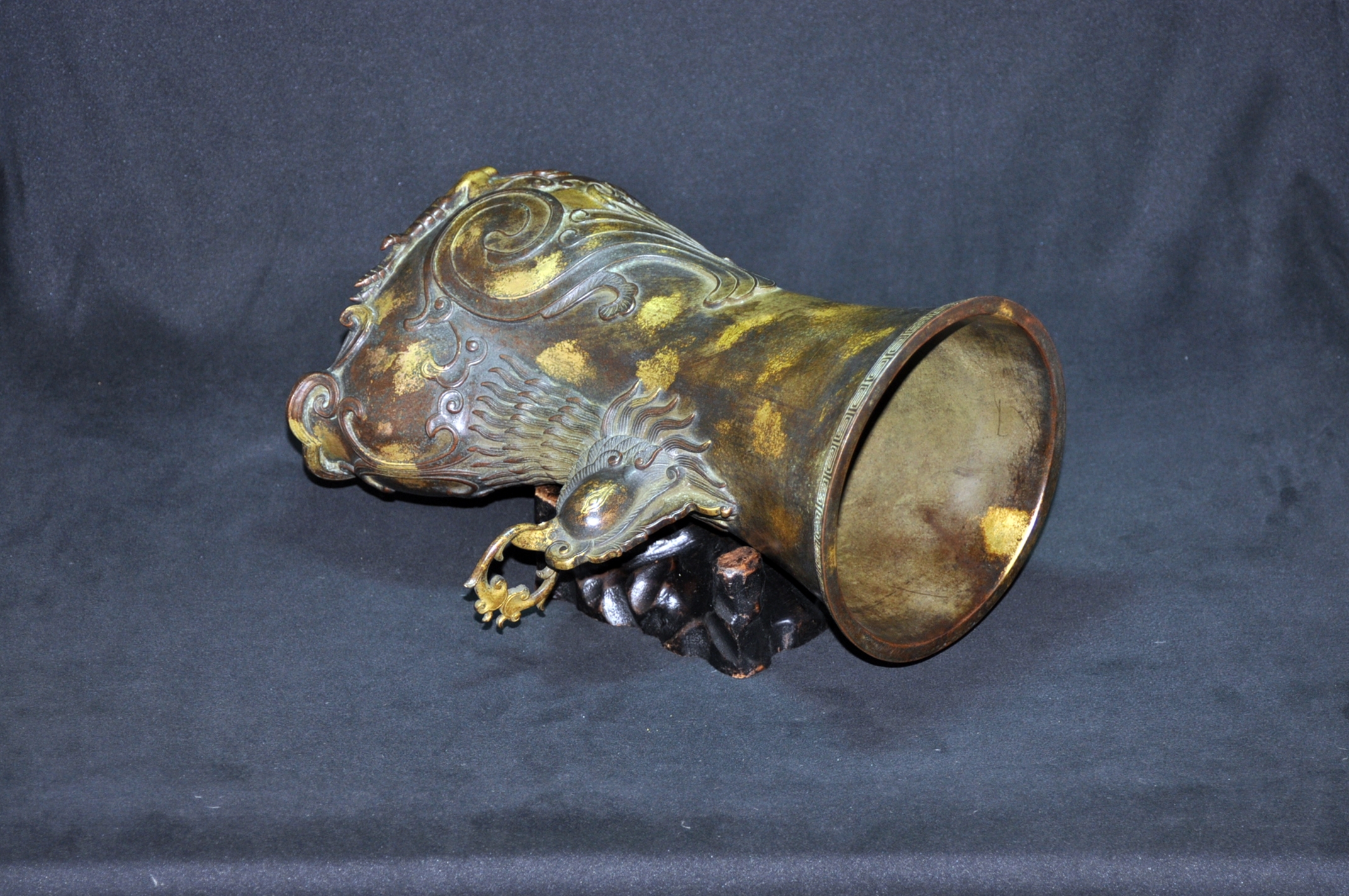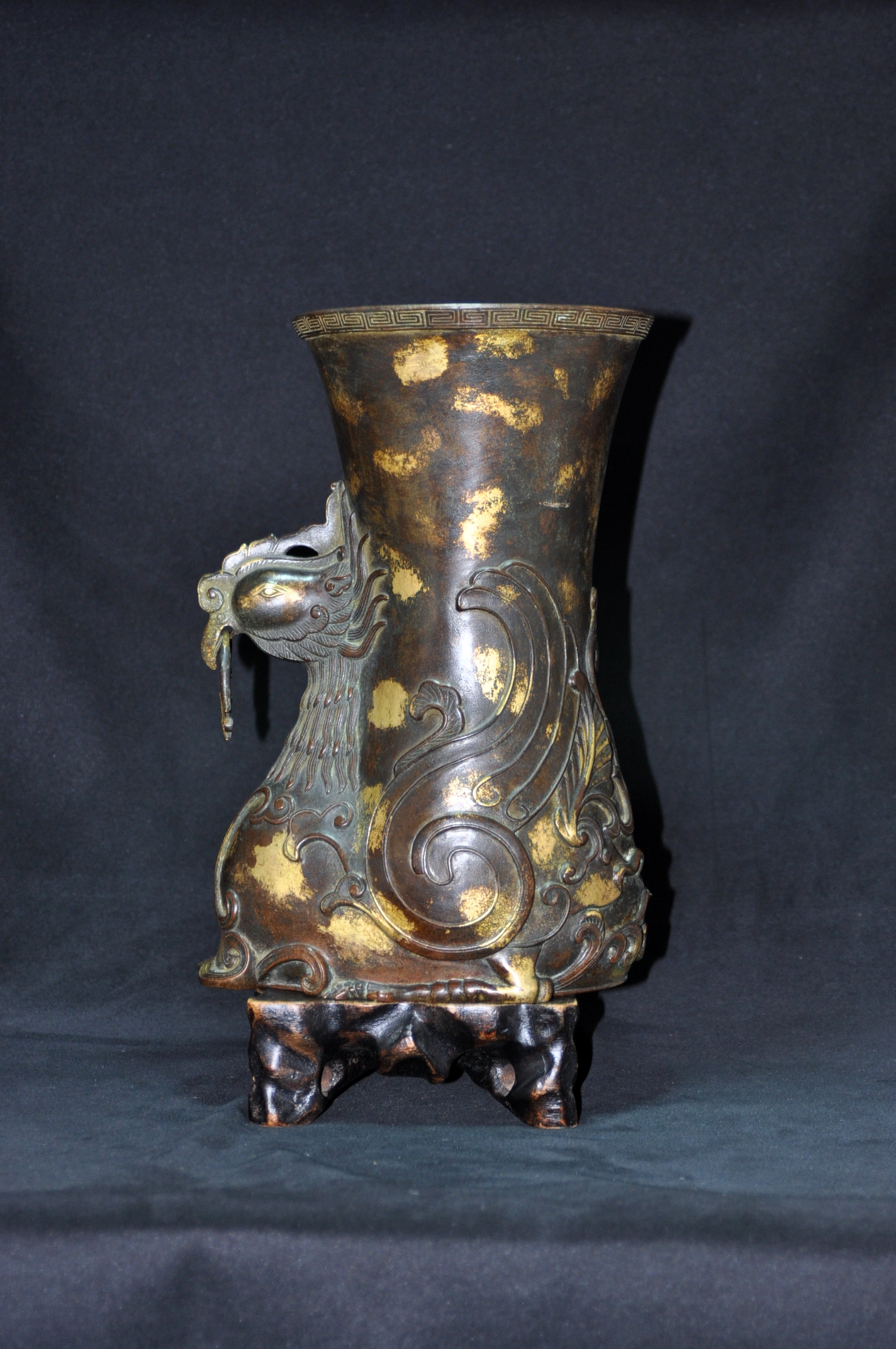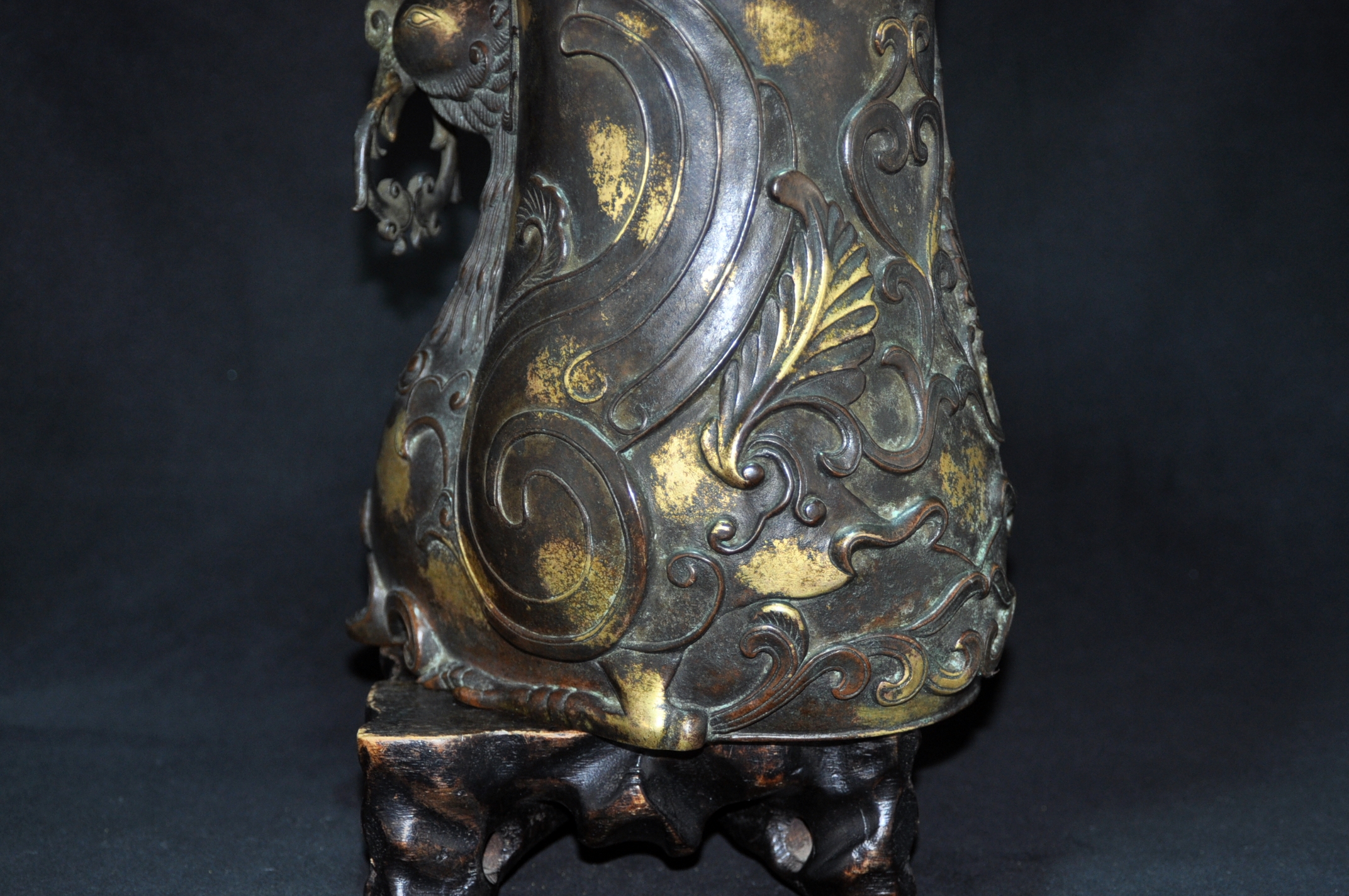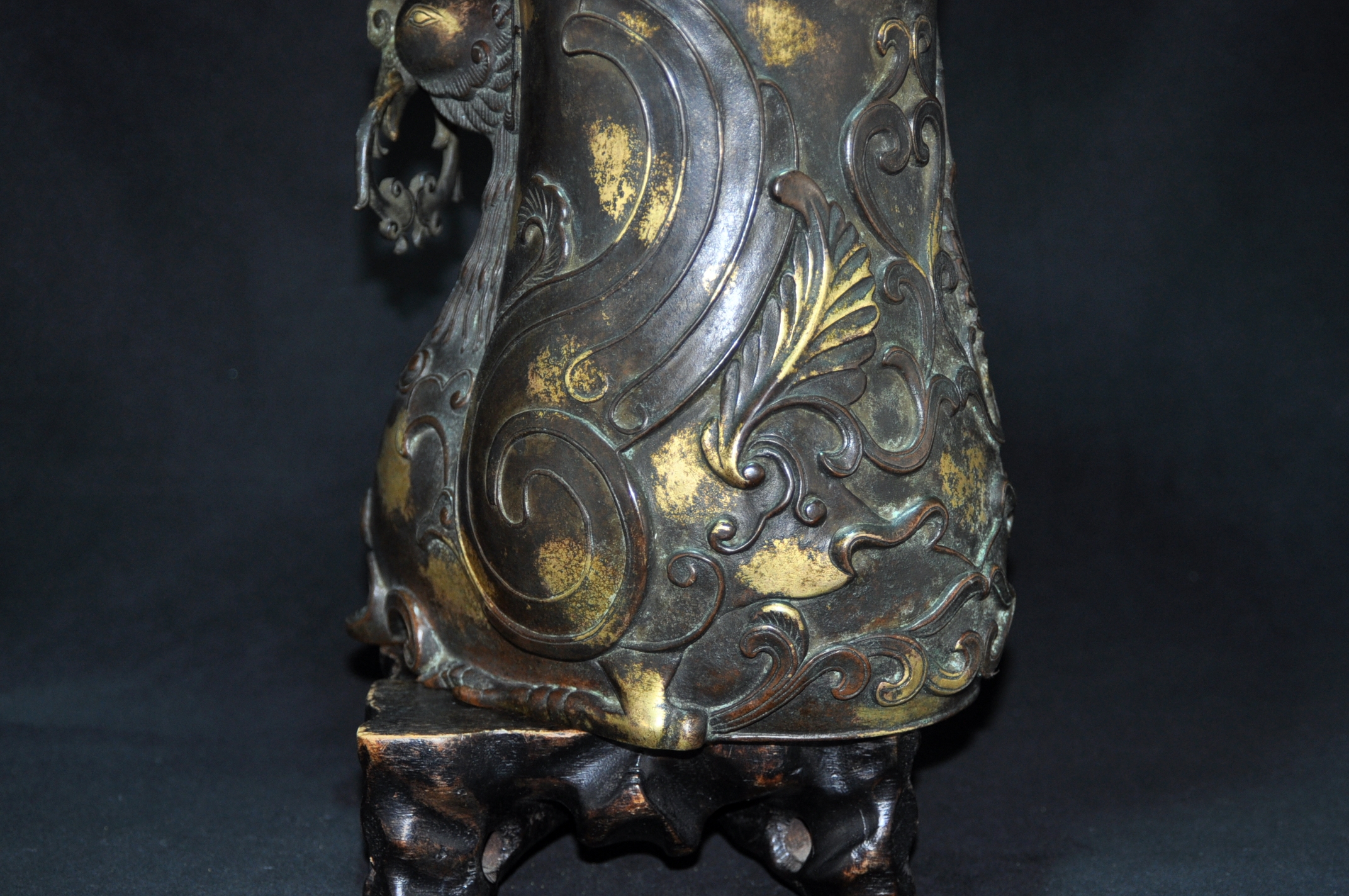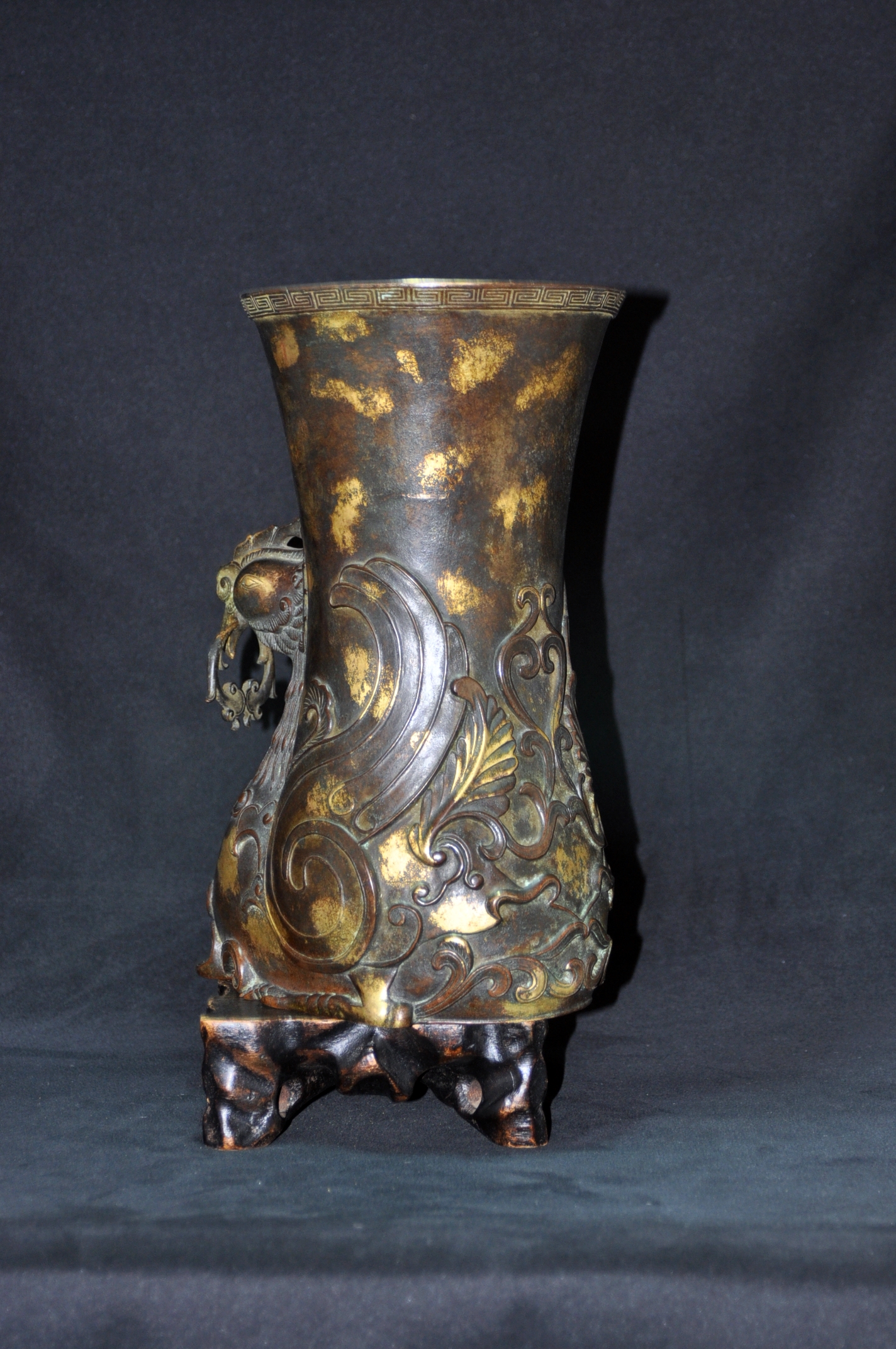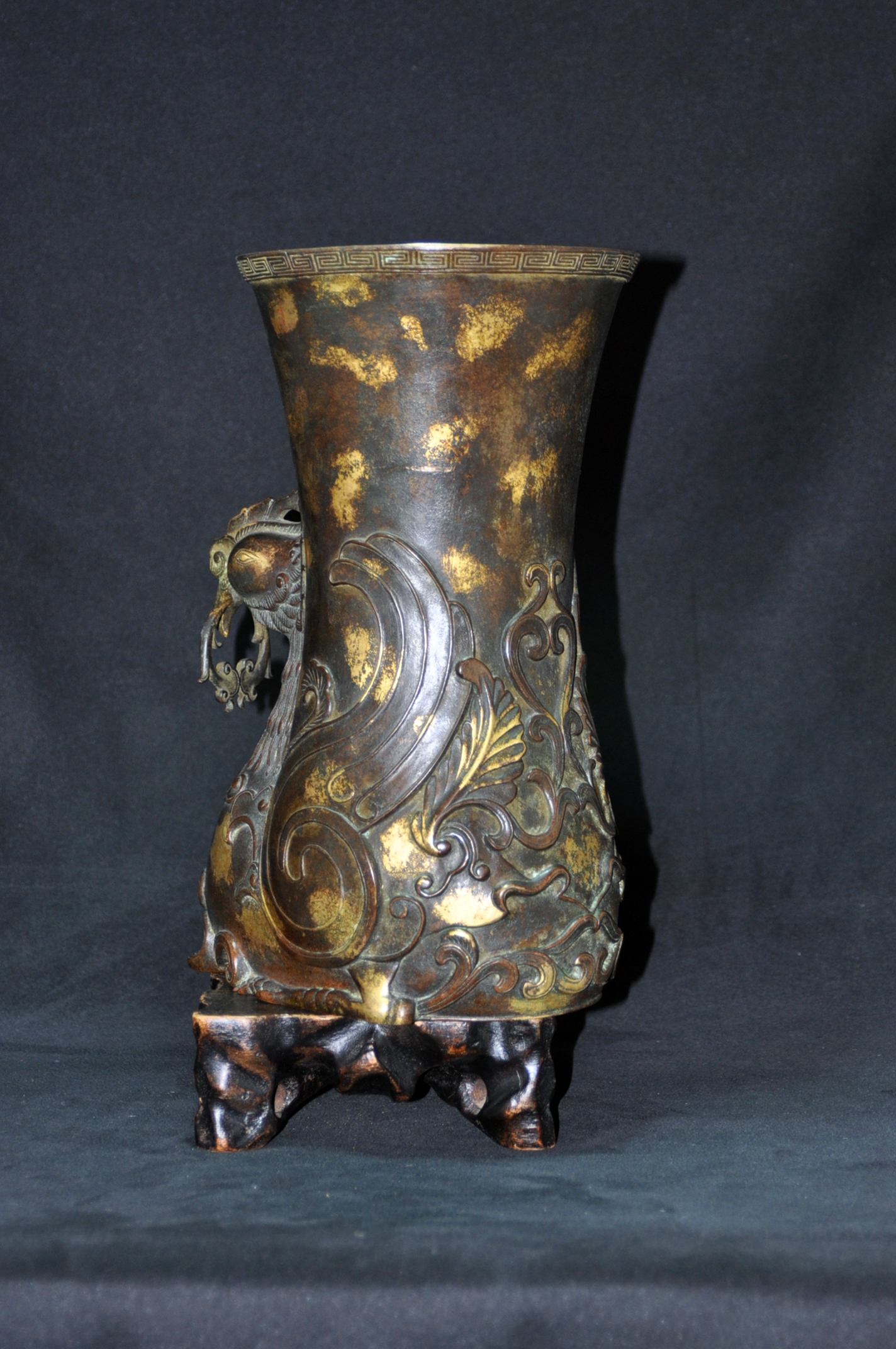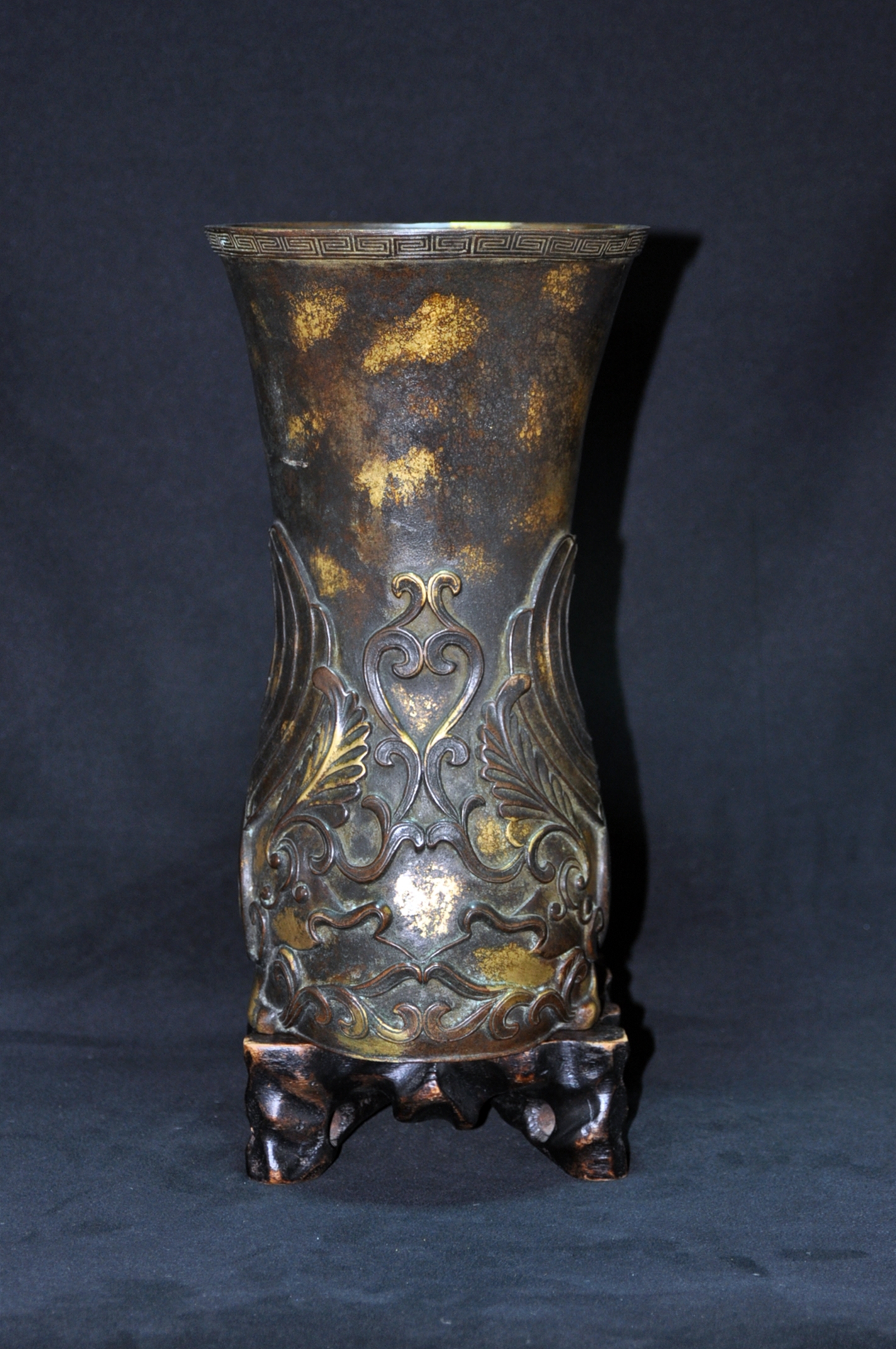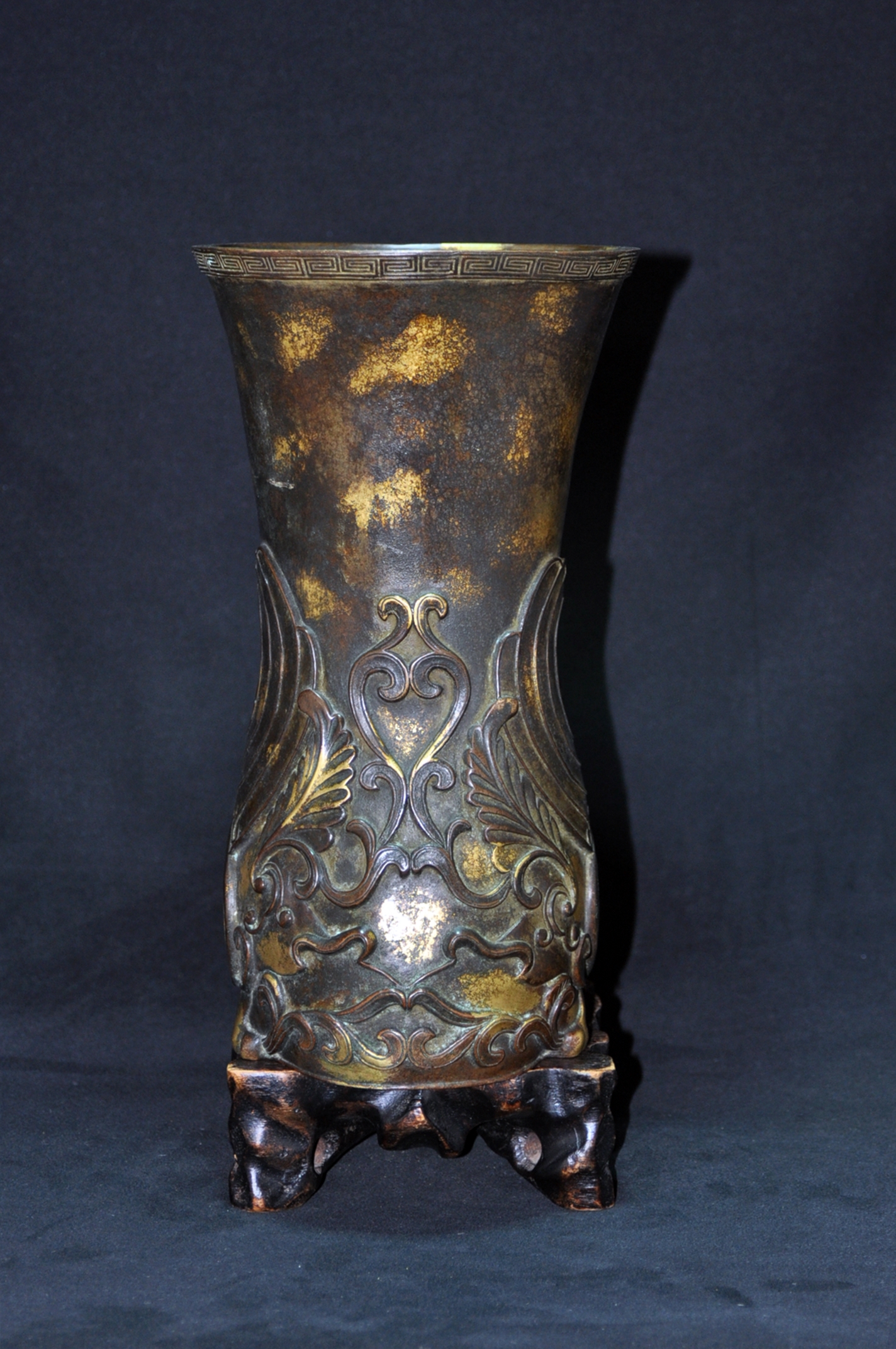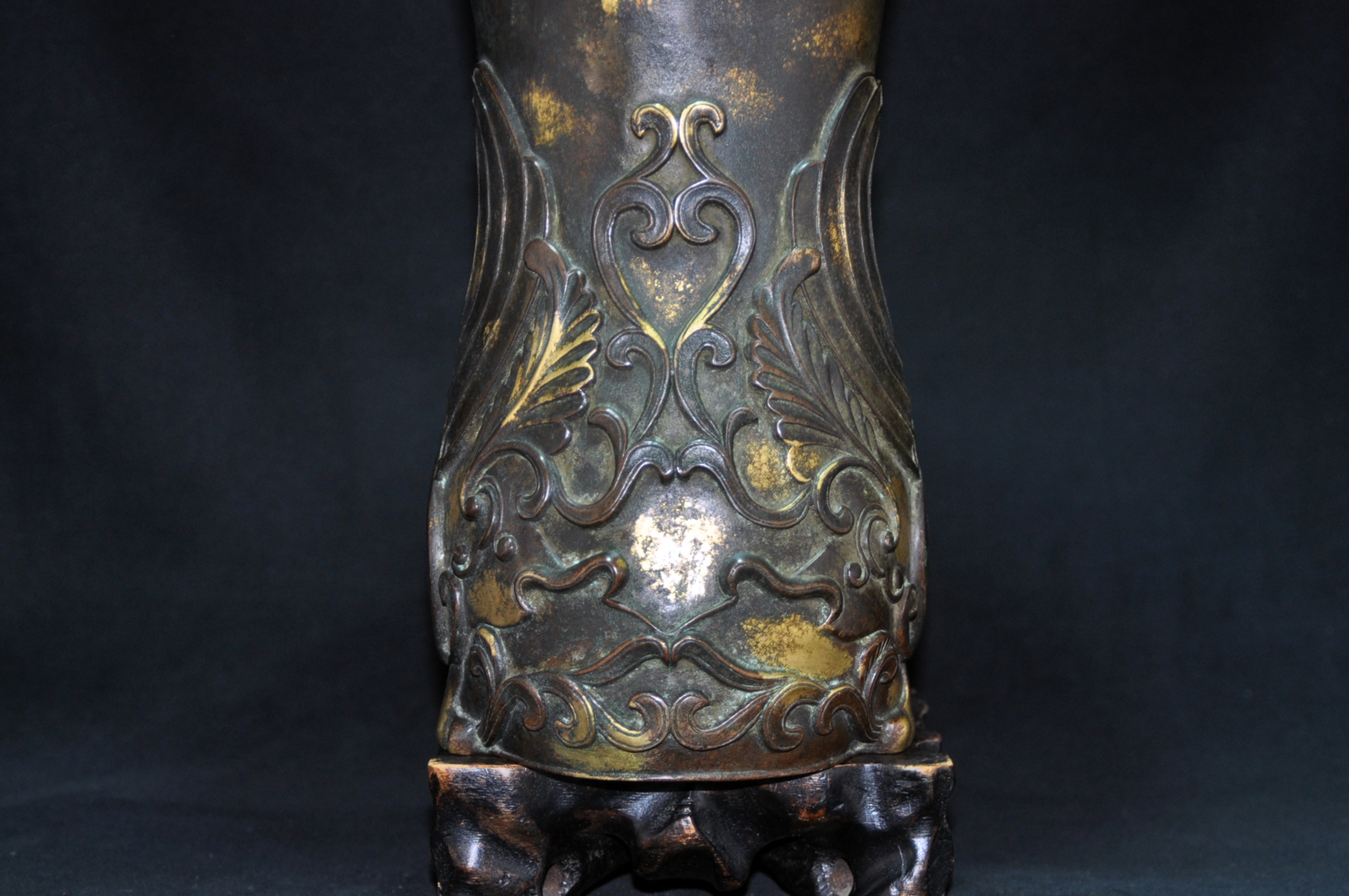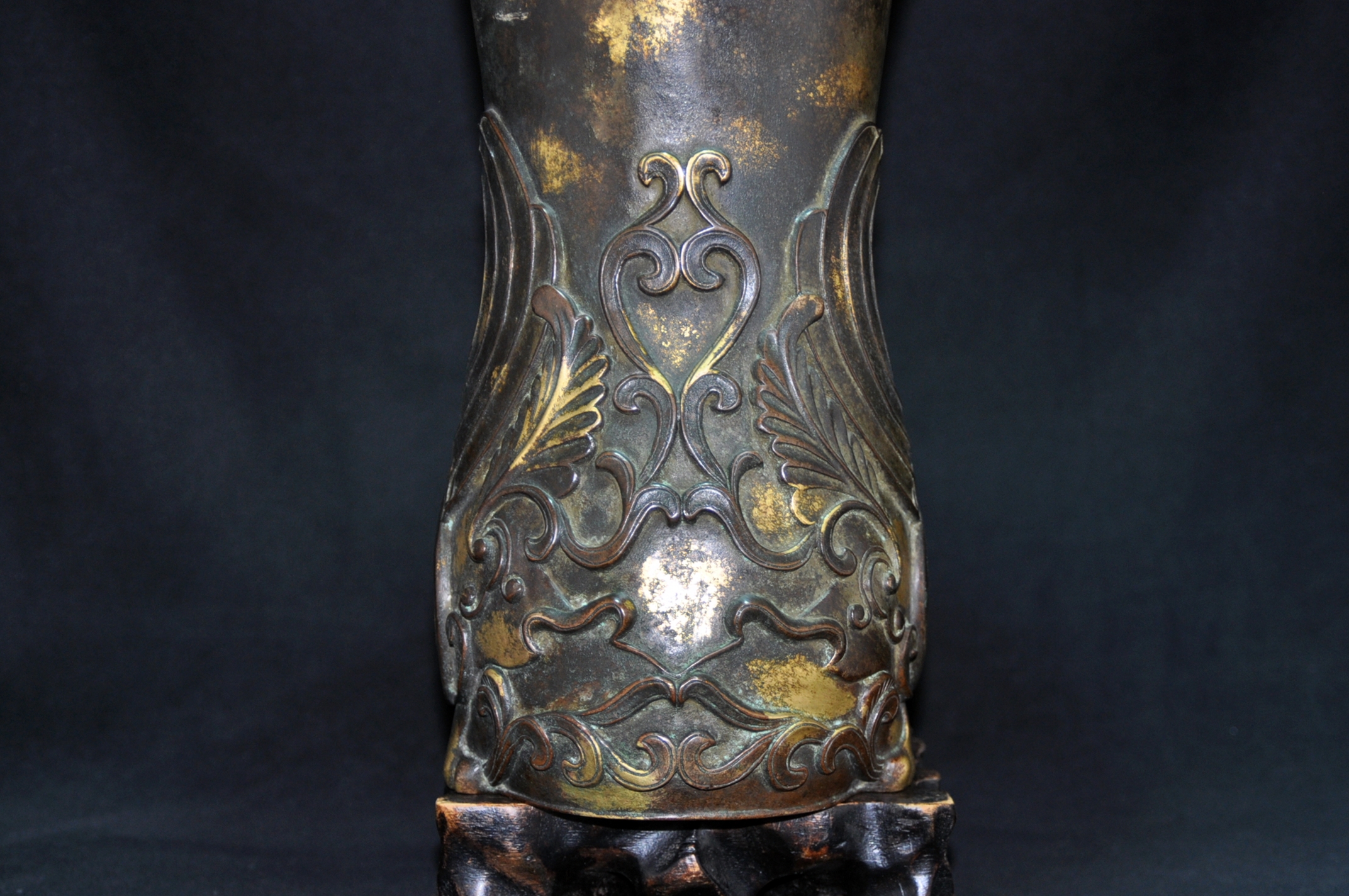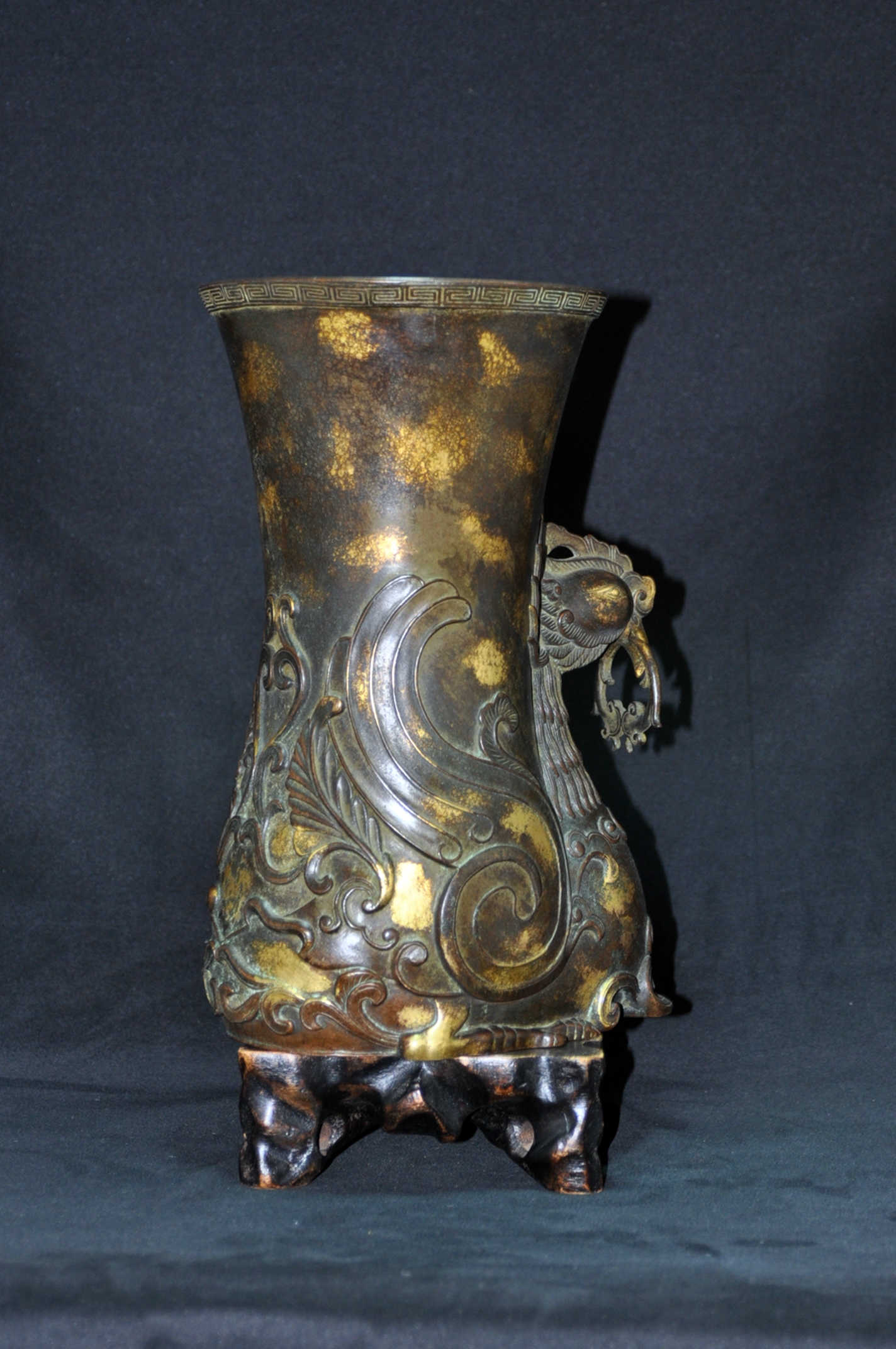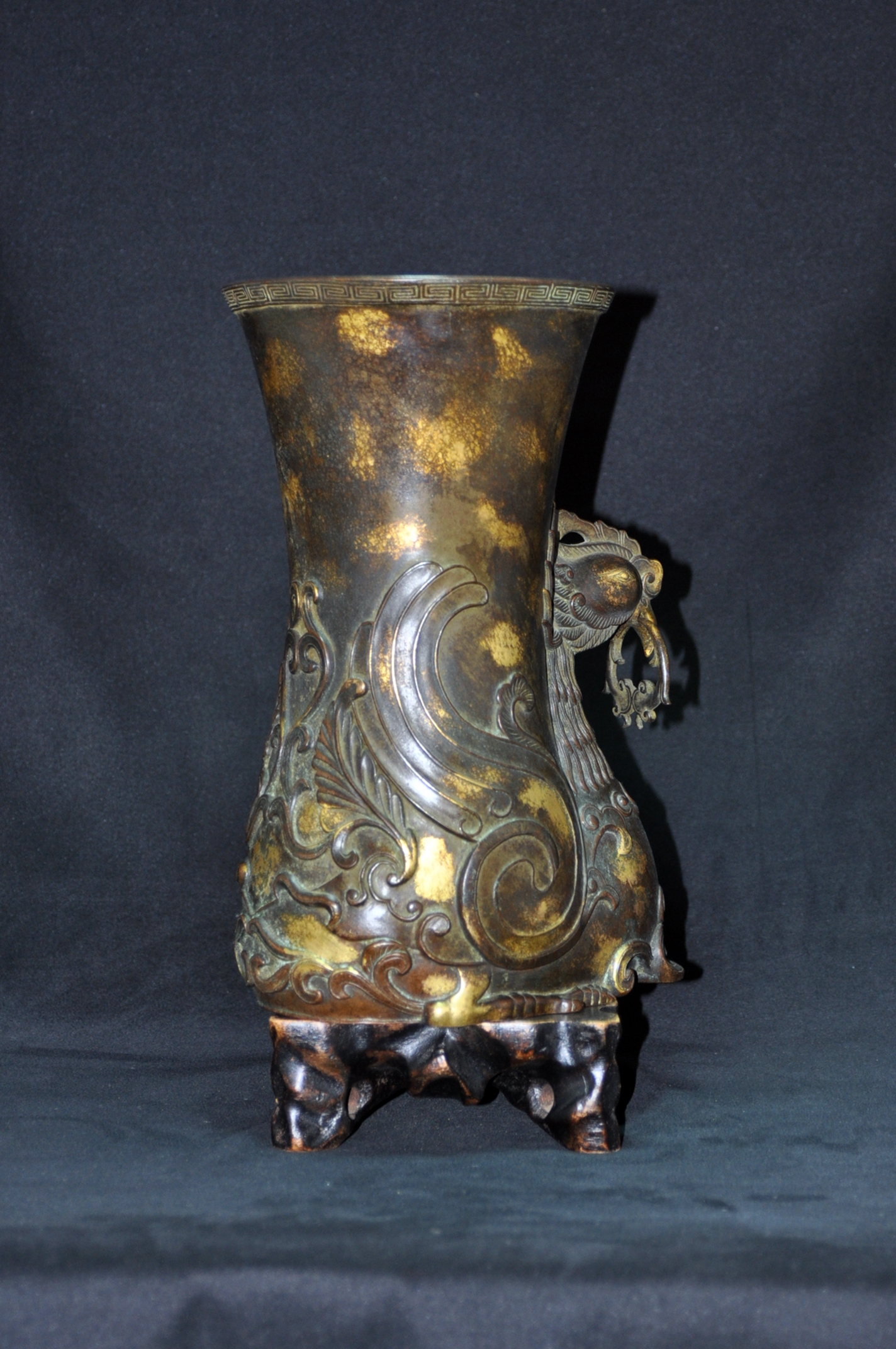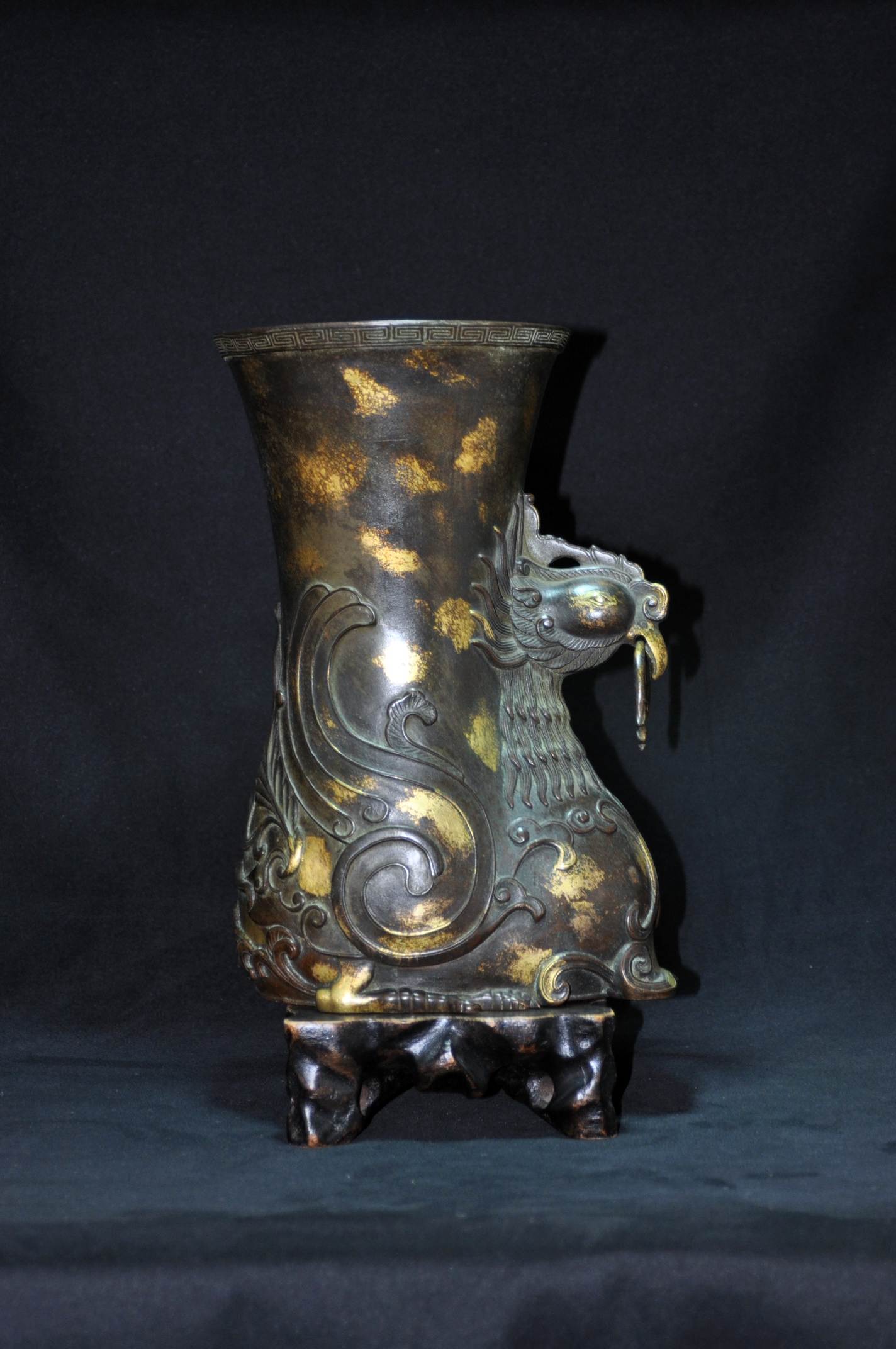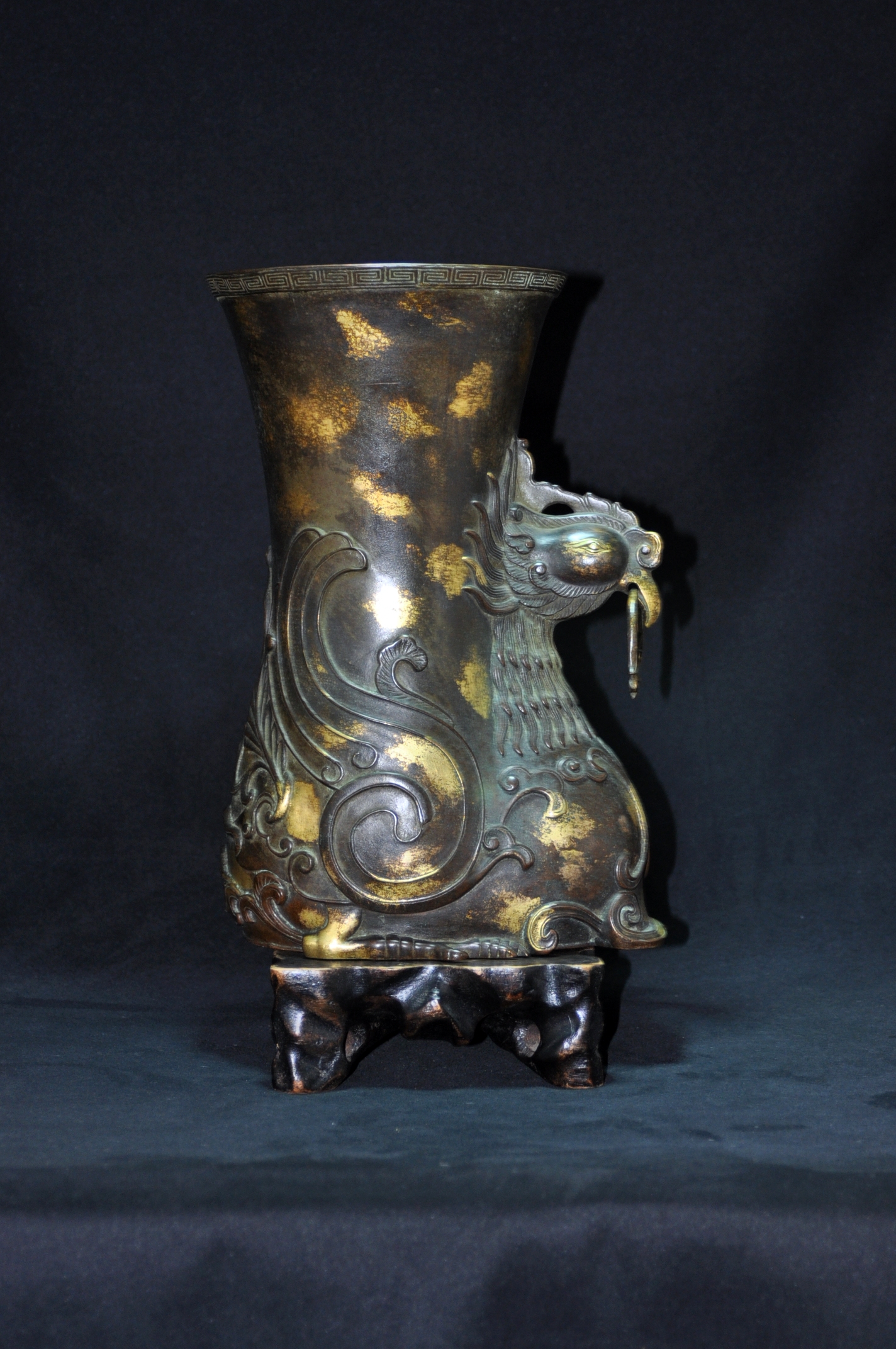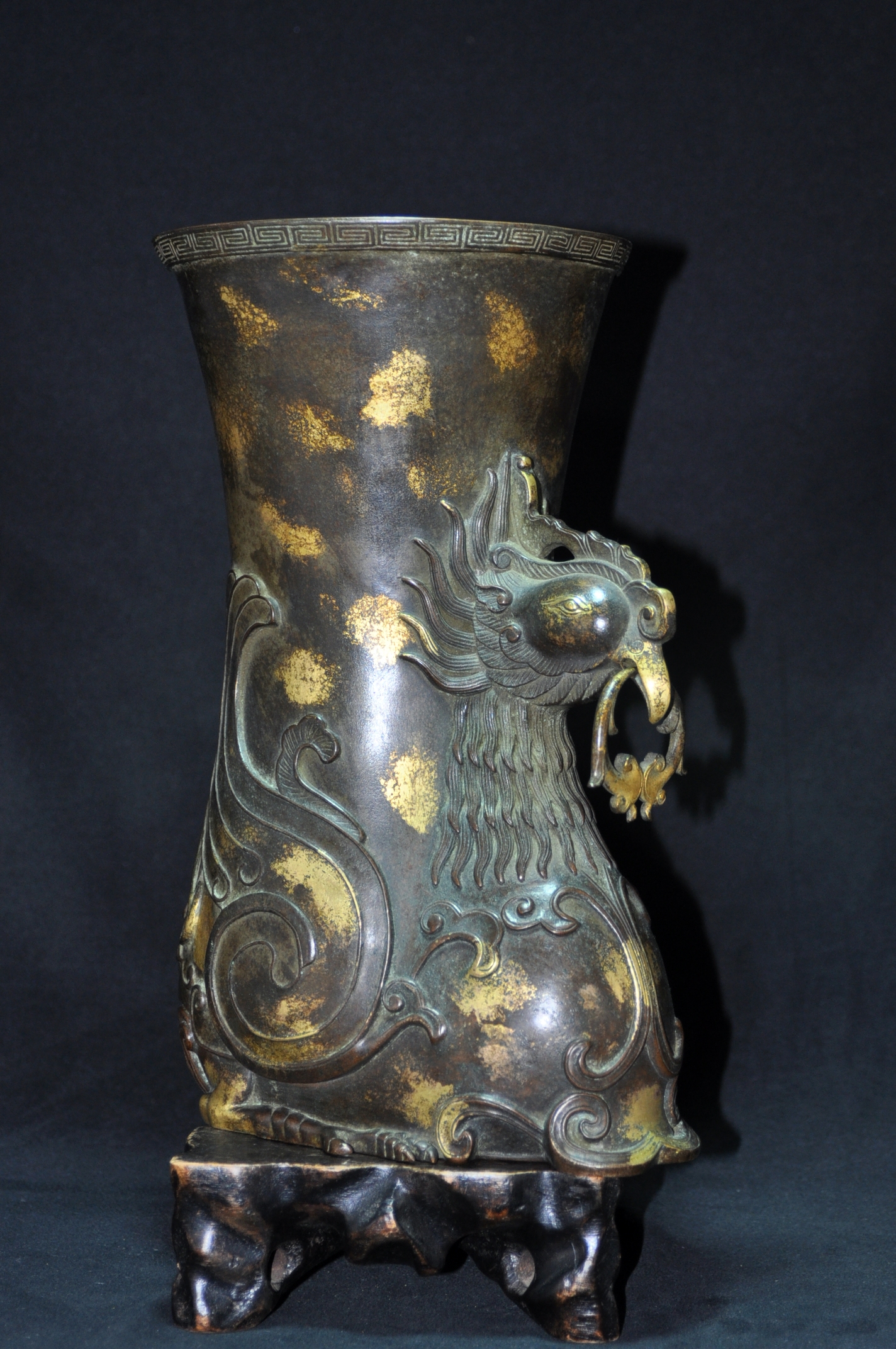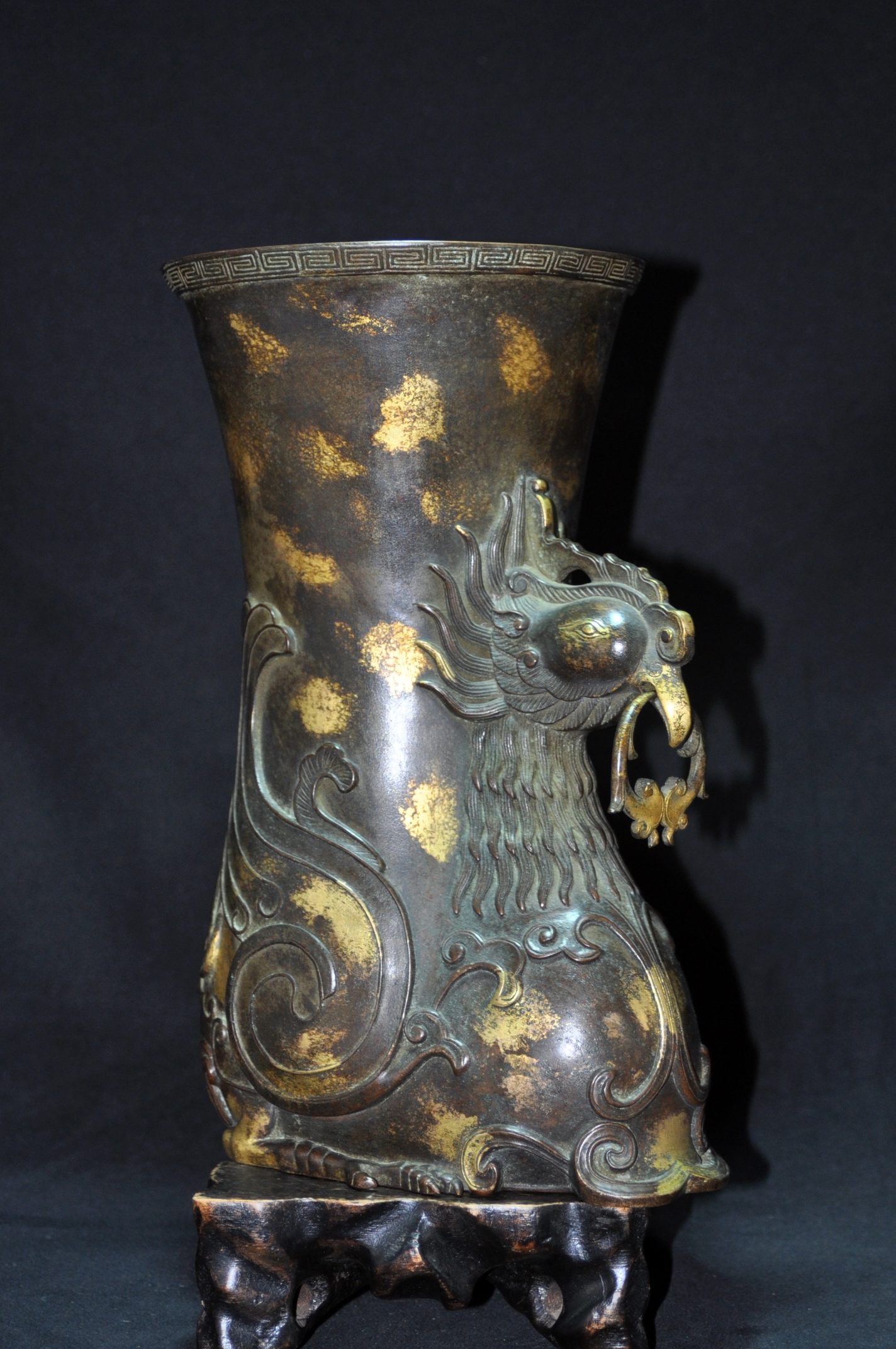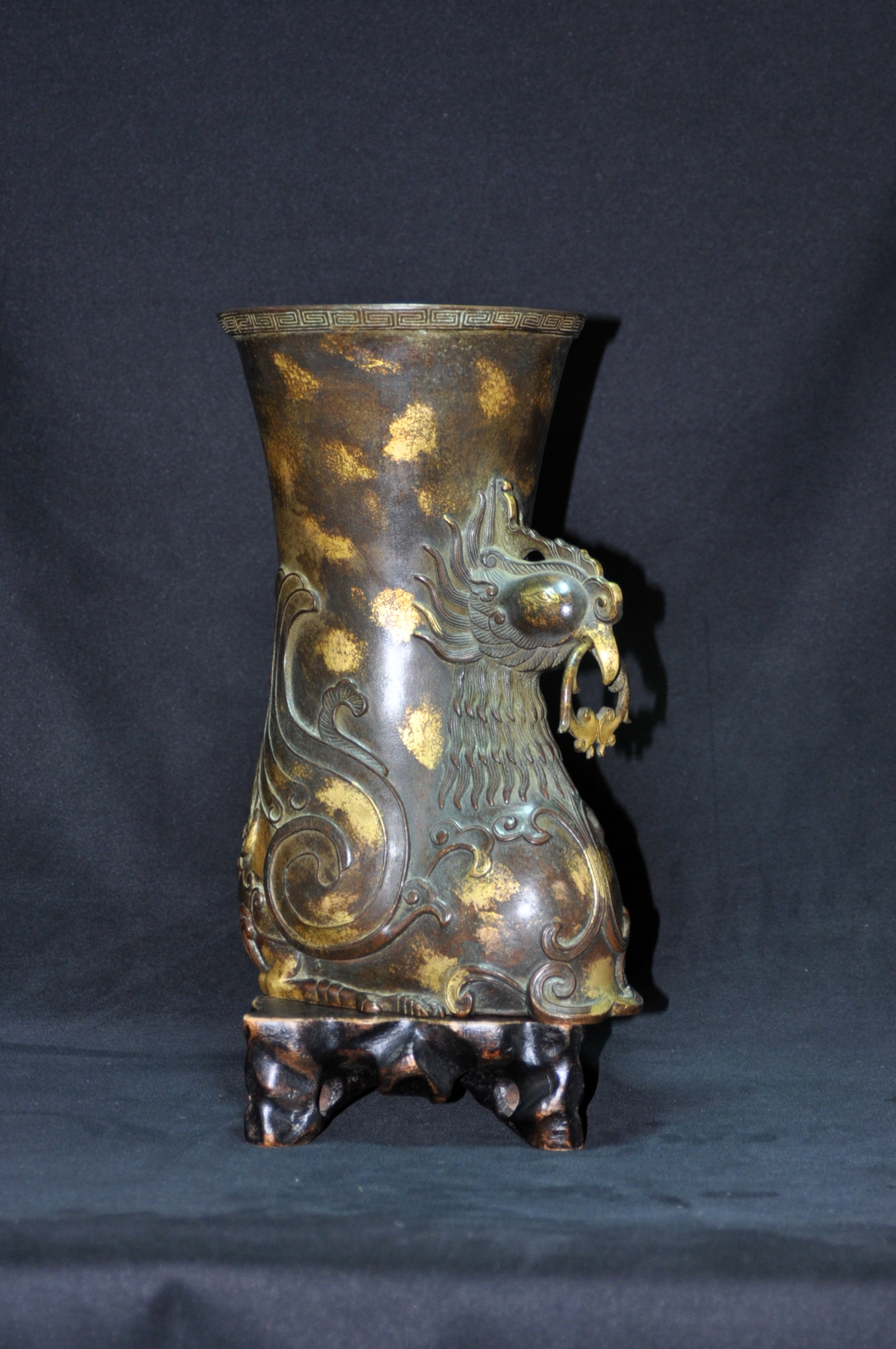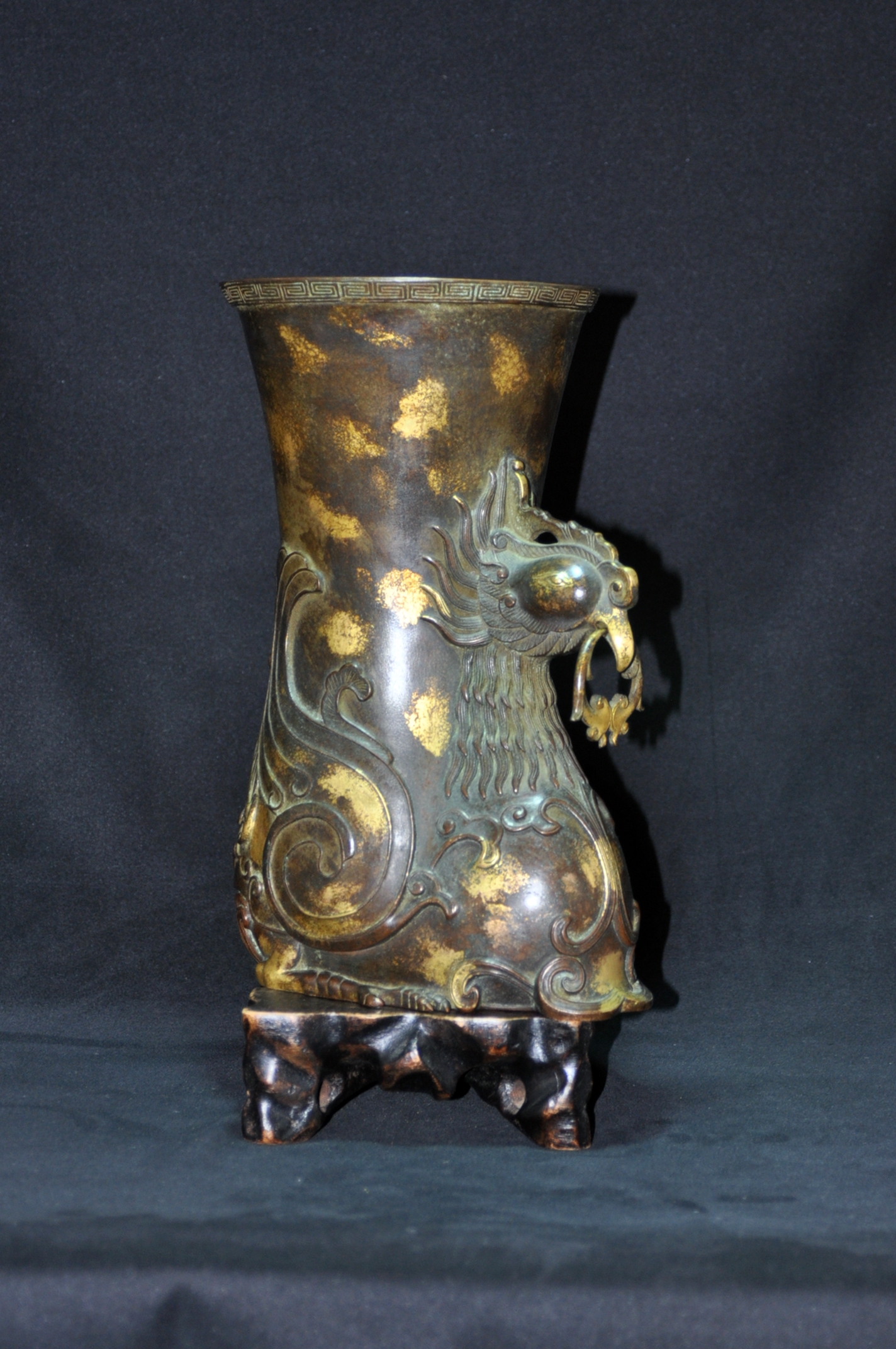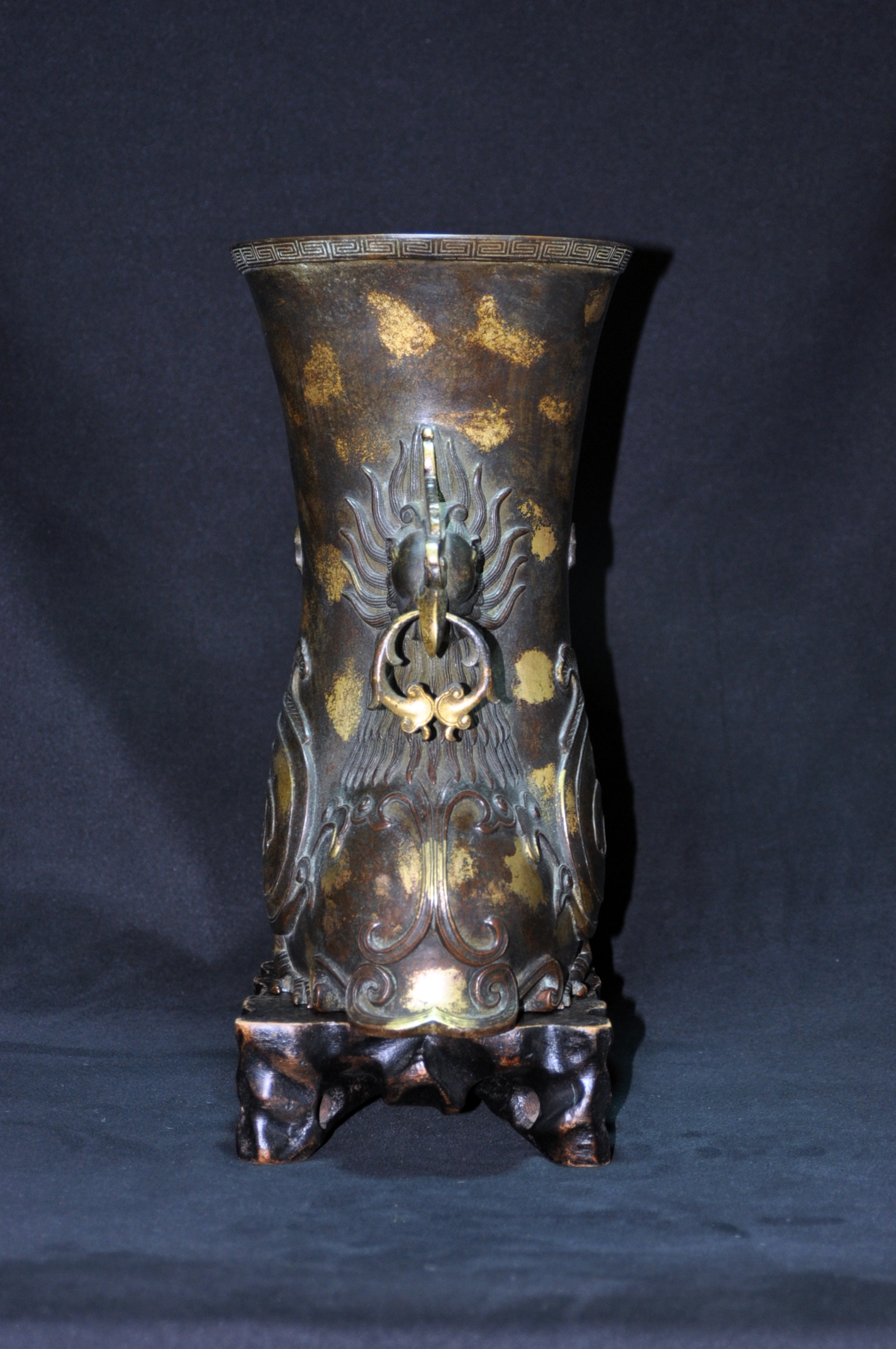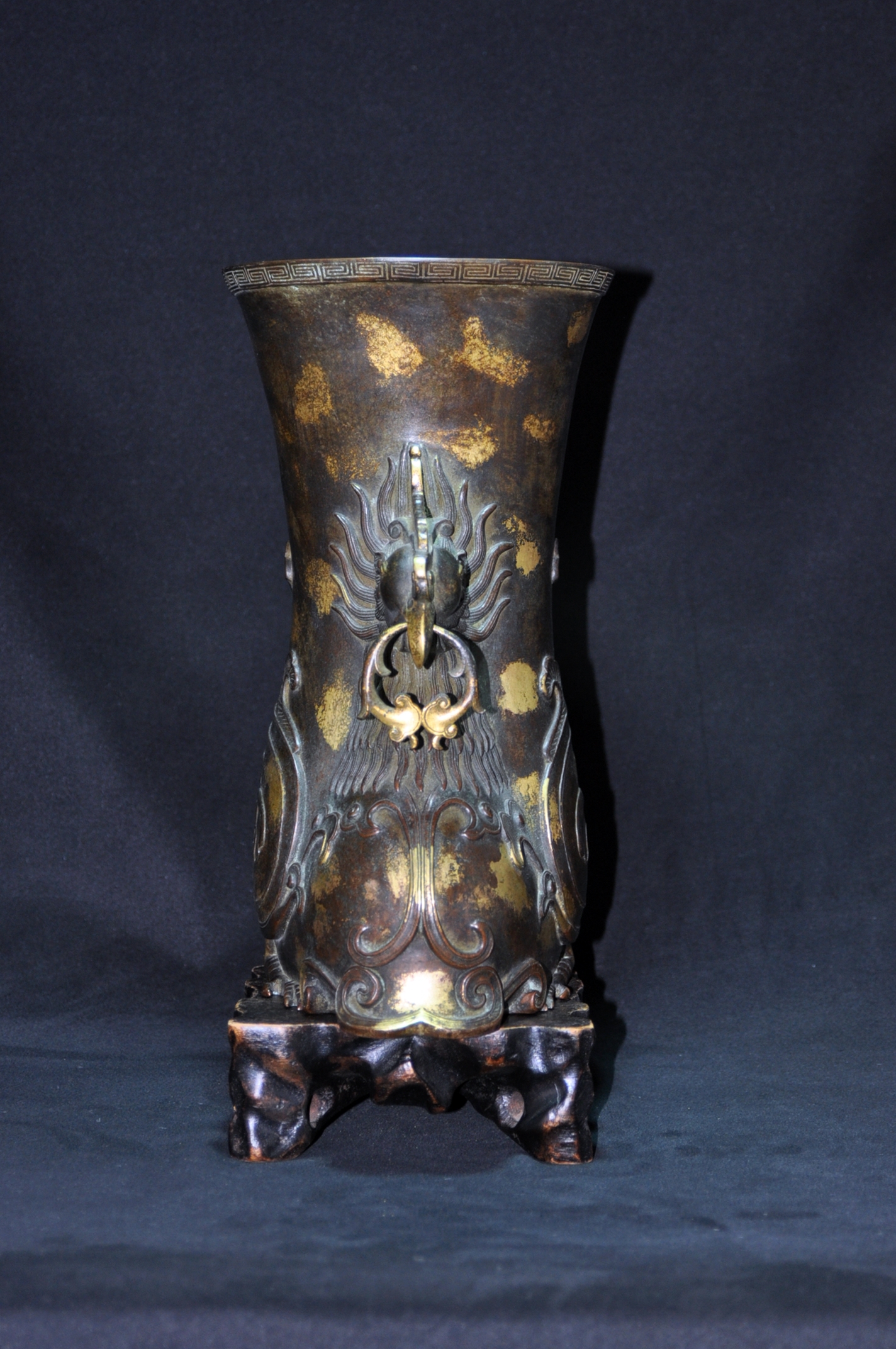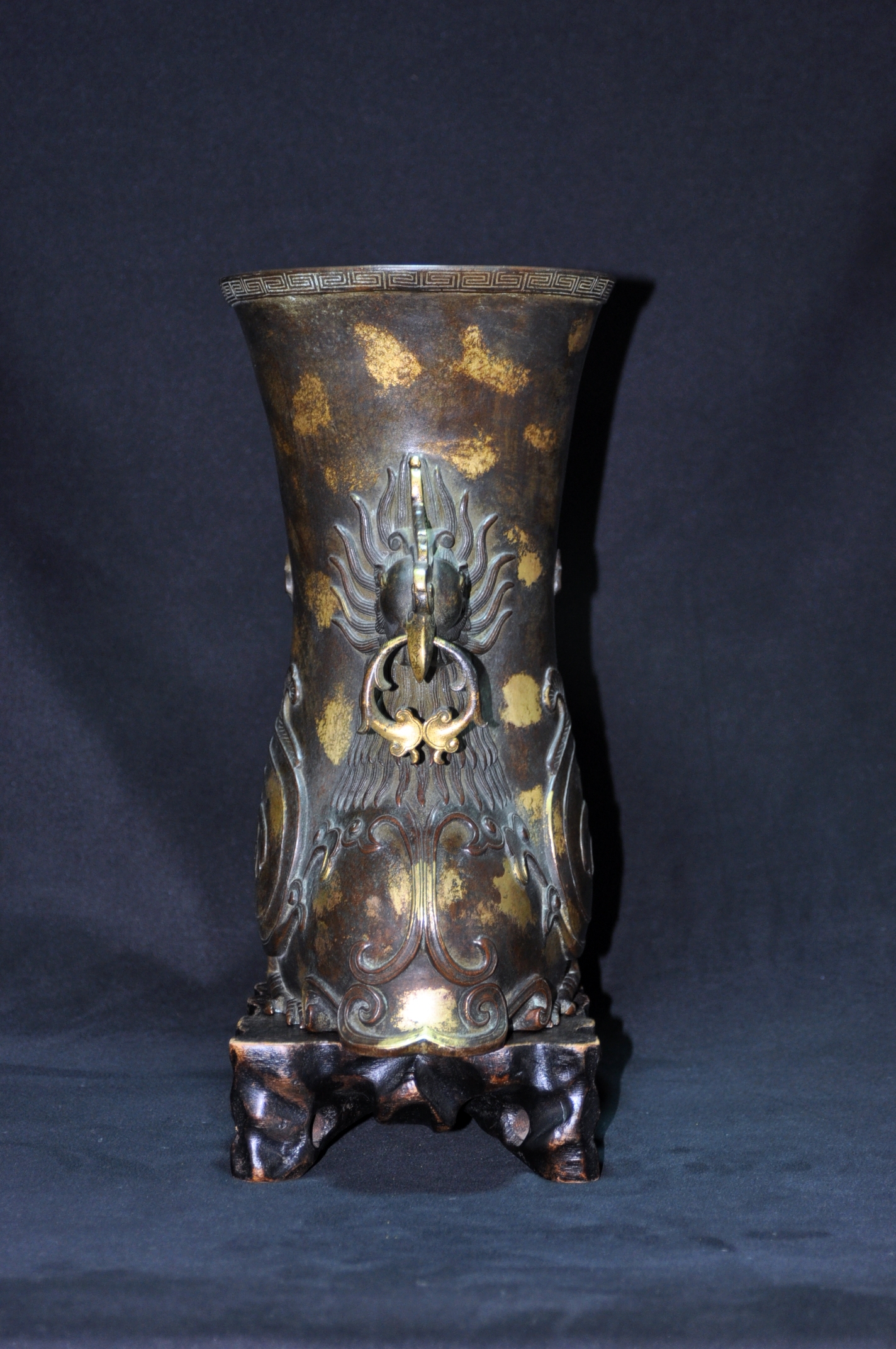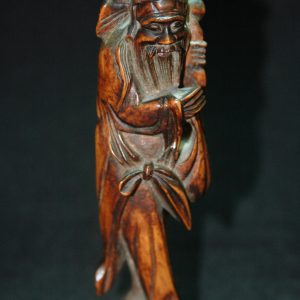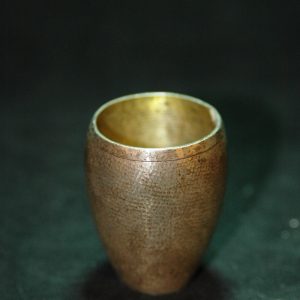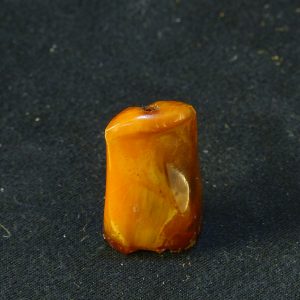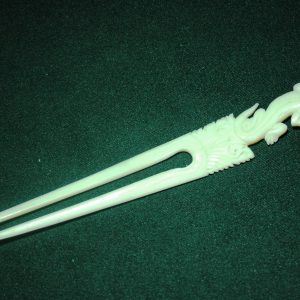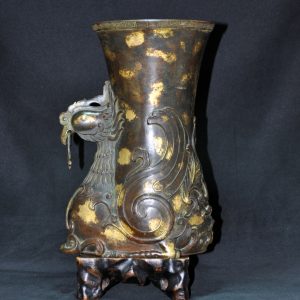Description
大清乾隆 鏨刻口銜如意環鳳凰點金青銅尊
振翅一飛三千年| 青銅鳥尊大賞- 每日頭條
参考:苏富比
中國藝術品
03 十二月 2015 • 香港
拍品 362
十七世紀 銅漆金「鳳鳥」紋燭臺
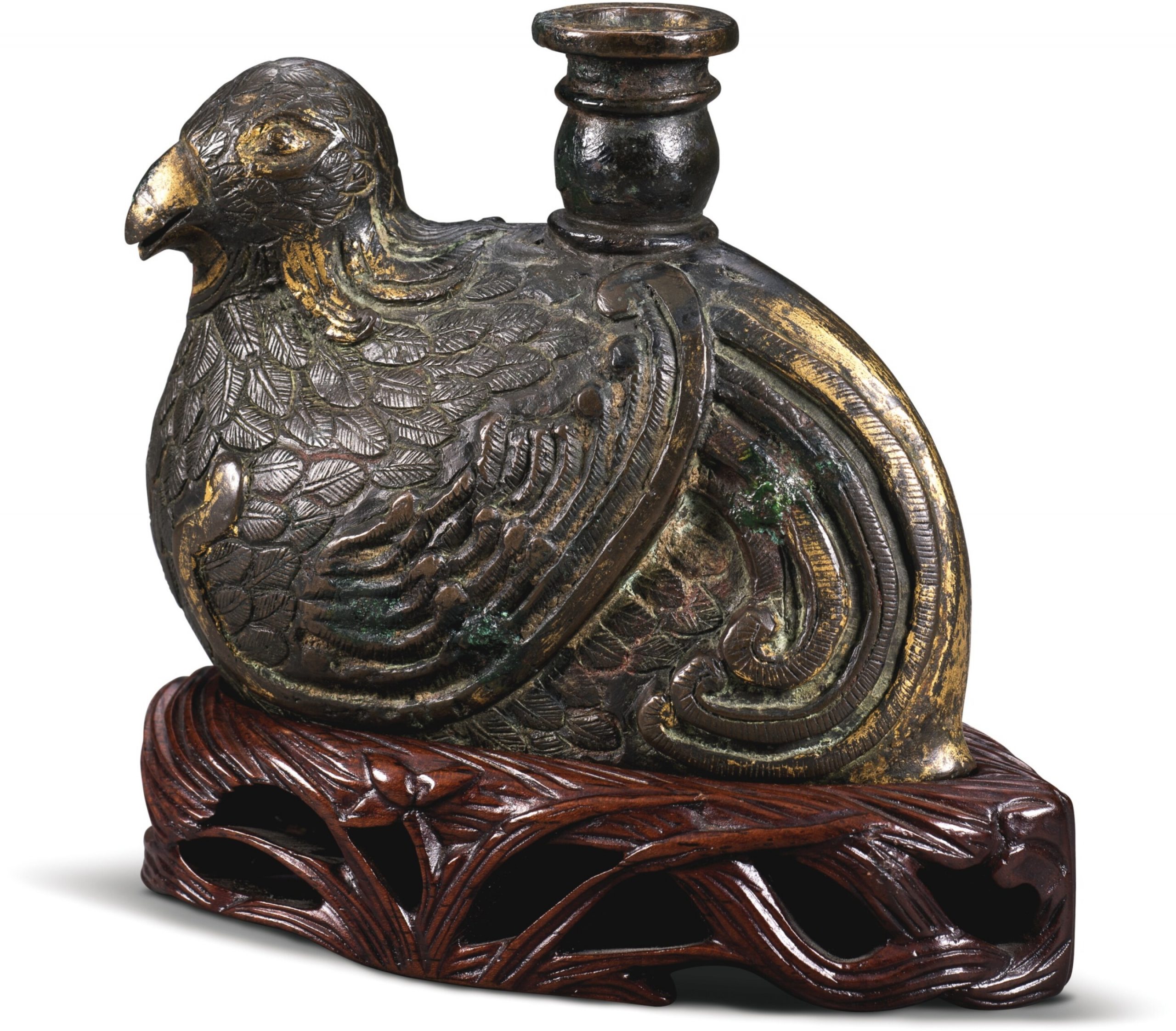
估價 50,000 – 70,000 HKD
已售出 106,250 HKD
描述
bronze
9.8 公分,3 7/8 英寸
sturdily cast nestled with finely detailed wings folded against its body and tail feathers curling down its back, turning its head to the left, with traces of gilt highlighting its head and elaborate plumage, all surmounted by a raised circular holder for receiving the candle, wood stand
参考:臺北故宮博物院藏
天鸡尊(清朝)
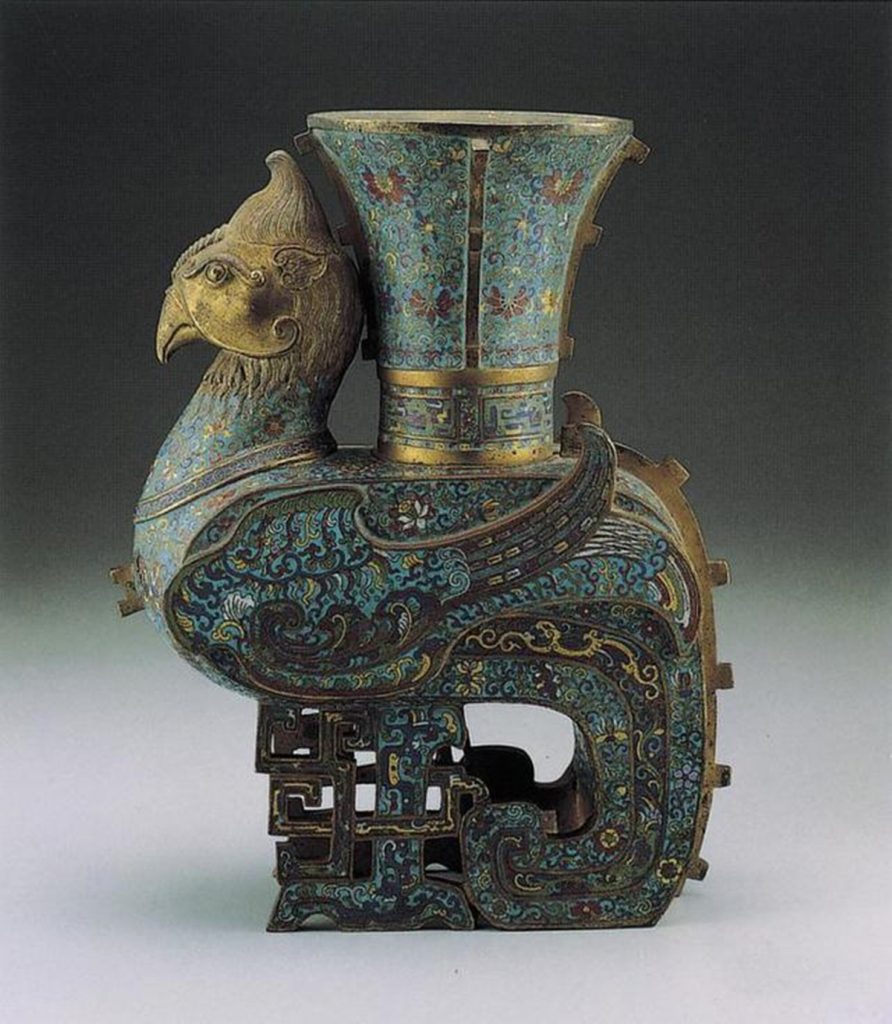
公元纪年: 1736-1795AD
纹识描述: 各式羽毛、缠技花、凤鸟及拐子龙等纹饰
文物描述:铜胎,仿铜器天鸡尊形制,凤首,喇叭口,背和尾部的「T」形棱脊镀金,余均蓝地满布各色羽毛、缠枝花、凤鸟及拐子龙等纹饰,以内卷的眉羽和镂制成拐子龙形状的双足为座,器物沉重,釉色鲜明艳丽。
文物尺寸: 总高:35.4cm 宽:13.7cm 长:28cm
总重:10785g
釉色: 珐琅彩
参考:北京故宮博物院藏
清乾隆 【乾隆款掐丝珐琅天鸡尊】
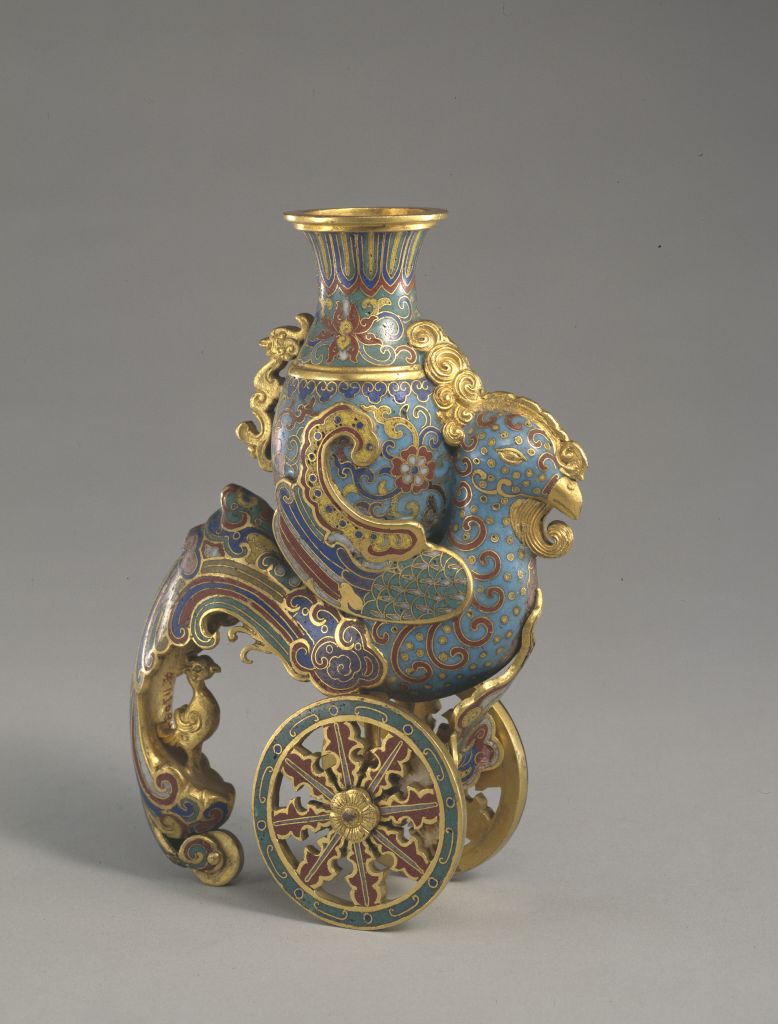
【乾隆款掐丝珐琅天鸡尊】
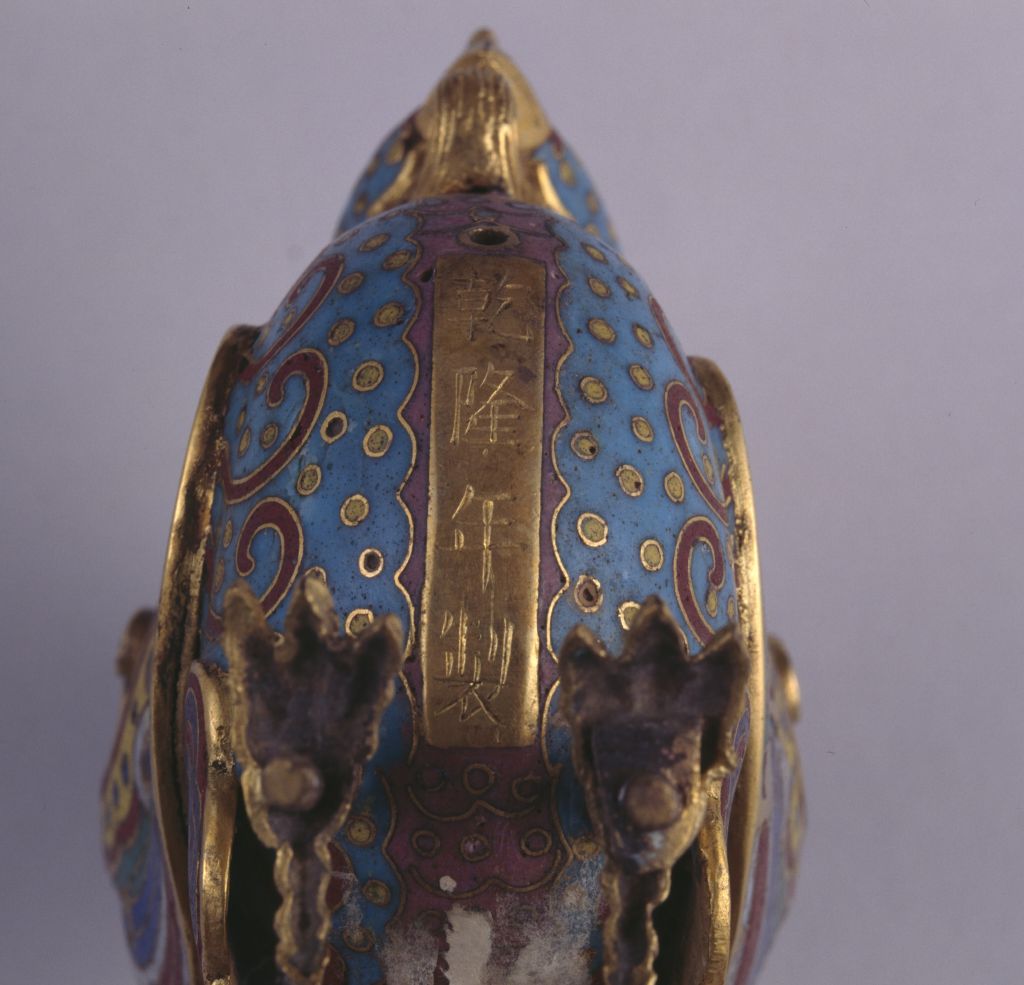
【乾隆款掐丝珐琅天鸡尊】
乾隆款掐丝珐琅天鸡尊,清乾隆,通高18.9厘米,身长13.4厘米,口径4.5厘米。
天鸡作立身昂首状,背负一尊,双翅扬起贴于尊身,爪踩镂空双轮,长尾下垂内卷,尾羽内立一鎏金小天鸡。尊椭圆体,撇口,鎏金螭耳。通体以掐丝填彩釉为纹。天鸡以点、条带、圈状纹做羽毛,尊以缠枝莲和蕉叶纹为装饰。天鸡胸前嵌长方形鎏金片,上阴刻“乾隆年制”楷书款。
天鸡作为传说中的神鸟由来已久,但具体形象的塑造则在清代乾隆朝才开始成熟。乾隆时期造办处曾以多种工艺制造天鸡形象,体态优美,形象生动,有着神异和吉祥之感,是陈设观赏的佳品。
撰稿人:张丽
关键词: 掐丝珐琅 珐琅 天鸡 镂空 阴刻 珐琅彩 缠枝 缠枝莲
銅胎,仿銅器天雞尊形制,鳳首,喇叭口,背和尾部的「T」形棱脊鍍金,餘均藍地滿布各色羽毛、纏枝花、鳳鳥及拐子龍等紋飾,以內卷的尾羽和鏤製成拐子龍形狀的雙足為座,器物沉重,釉色鮮明艷麗,是上好的陳設器。屬十八世紀中後期的文物。
天雞作立身翹首狀,背負螭耳尊,雙翅揚起貼於尊身,足登鏤空雙輪,長尾下垂內卷,尾羽內側立一銅鍍金小天雞。螭耳尊橢圓體,撇口,螭耳鍍金。天雞胸前貼飾片狀彩雲,中間嵌長方形銅鍍金片,其上陰刻”乾隆年制”單行楷書款。整器以紅銅作胎體,掐絲花紋內填入琺瑯彩釉,露銅處鍍金。天雞身上隨形作出羽毛狀飾紋,尊表面飾纏枝蓮紋。
特色
天雞作為一種傳說中的神鳥由來已久,具有吉祥之意,但其具體形象的塑造則在清代乾隆朝才開始成熟。乾隆時期造辦處曾以不同的工藝製造天雞形象,令人耳目一新。此掐絲琺瑯天雞尊器形優美,形象生動,色彩富麗,鍍金輝煌,透露著一種神異之感,體現了乾隆時期琺瑯製作工藝的精湛水平。
参考:佳士得
14 5月 2018 | 現場拍賣 15487
中國瓷器及工藝精品
拍品 77 明 銅錯金銀天雞尊
A RARE GOLD AND SILVER-INLAID BRONZE ARCHAISTIC BIRD-FORM RITUAL VESSEL, ZUN
MING DYNASTY, 17TH CENTURY
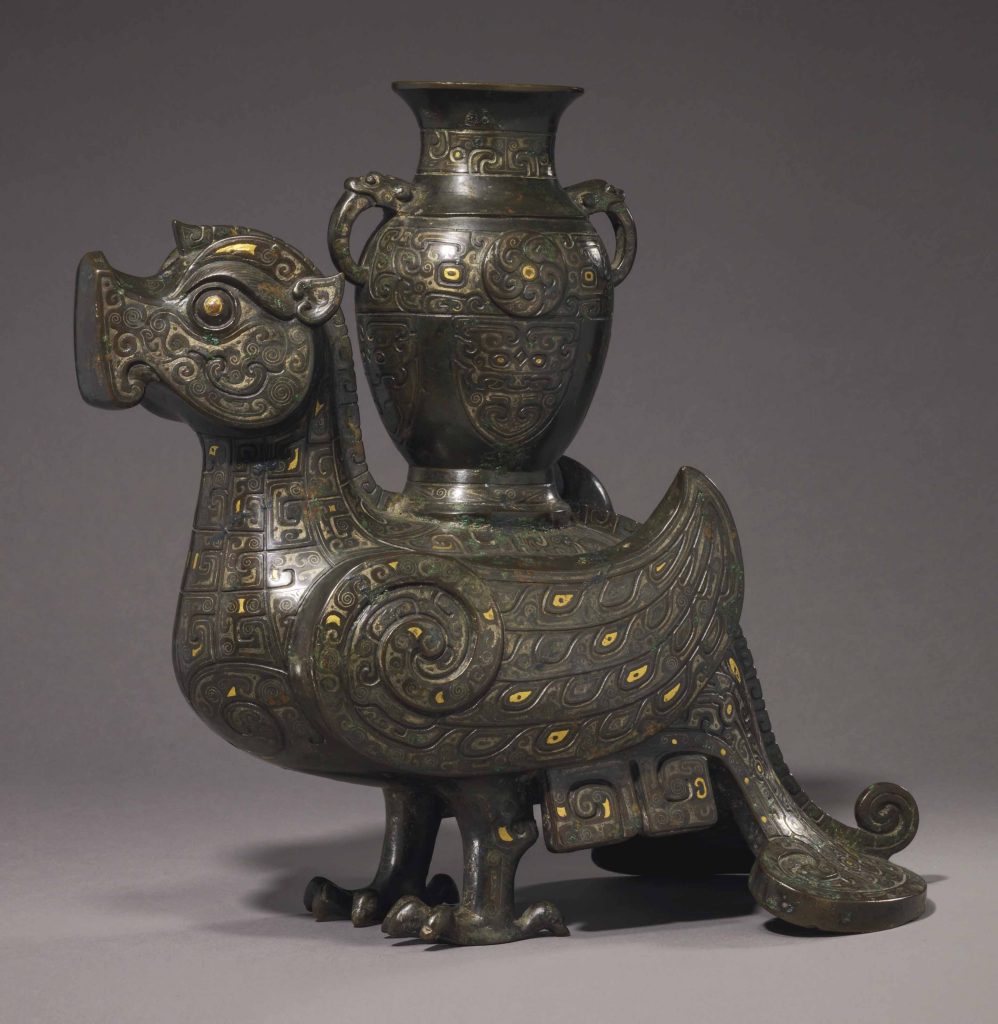
成交價 GBP 380,750
估價 GBP 100,000 – GBP 150,000
14 ½ in. (37 cm.) high
狀況報告
We have sought to record changes in the condition of this piece acquired after its initial manufacture.
– The vessel is in overall good condition for its age.
– There are some tiny knocks and minor dents to the extremities, and some general age-related surface wear, as expected.
– There is a small area of shallow loss to the surface to the back tip of one wing.
– There are a few minor losses to the gilt and silver inlaid areas, as expected.
來源
By repute, with Bluett & Sons, London, then Michael Goedhuis, London.
明 銅錯金銀天雞尊
來源: 倫敦古董商Bluett & Sons, 倫敦古董商Michael Goedhuis (傳)
蘇玫瑰
佳士得國際資深學術顧問
此鳥貌似鳳凰,實為天雞。「雞」,音「吉」,寓意吉祥;雞冠之「冠」,音「官」,可寓加官進爵,見《邃古來今 - 故宮仿古文物精品展特集》,澳門,2005年,頁182。雞背盛器亦可作多重解讀:「瓶」,音「平」,即平安無恙,天下太平;「壺」可引伸渤海神山「方壺」;「罐」屬佛教八寶「八吉祥」之一,象徵佛陀教法圓滿無漏。
本銅錯金銀天雞尊,製於明末清初,仿古風格,造型典雅,屬同類製器典範。當時慕古之風正盛,高古藝術深受文人墨客推崇,更得商賈貴族青睞,同發思古幽情。古物珍玩稀罕難求,能親炙其風采者少之有少,其相關叢書遂銷量倍增,以饗社會各界之嗜古熱潮。上溯宋代,收錄古代青銅器及其銘文之圖冊早已大受歡迎。此外,古物出土屢見不鮮,農民田間時有所獲,古物買賣愈趨蓬勃。收藏古玩蔚然成風,最為人所稱道者,非宋徽宗(公元1101 ― 26年在位)莫屬,據說收藏逾萬,蔚為大觀。古物圖鑑不僅為尚古之人提供豐富資料,同時啟發後世銅匠創作不息,其中以宋末出版圖冊為最。傳世最古者為呂大臨編修之《考古圖》,1092年成書,七、八十年後由另一位作者附加補記。原版《考古圖》專研金石學,記載古物銘文,收錄諸多名藏,不乏宮廷瑰寶。(柯玫瑰著《Later Chinese Bronzes》,倫敦,1990年,頁14,圖版2,記一1601年版本《考古圖》內容)《考古圖》圖文並茂,分門别類,精摹細繪,毋庸置疑,乃同類著作先驅,為後世考古圖冊楷模。
另一早期考古圖錄為《重修博古圖錄》,公元1123年由宋徽宗命王黼纂修,圖文紀錄宣和宮藏品,包括逾八百件青銅器,有無銘文者皆輯錄其中。(其1588年版本記一周朝鵝形盛器,見柯玫瑰,《Later Chinese Bronzes》,同上,頁16,版圖3;一宋代鵝形銅錯金銀壺,現藏於維多利亞及艾伯特博物館,著錄同上,圖版4。)《重修博古圖錄》所列之器皆斷代為商、周、漢,部分物品實質出自較晚時期,例如唐代。如此誤差固然令讀者產生混淆,而後世學者亦有所論述。趙明誠(1081 - 1129年)、李清照(1084 - 1155年)合撰之《金石錄》,蒐集逾二千銘文,約1119至1125年間成書,序文寫道:
「若夫歲月、地理、官爵、世次,以金石刻考之,其抵牾十常三四。蓋史牒出於後人之手,不能無失,而刻詞當時所立,可信不疑。」
柯律格指出,明代王錡(1433 - 99年)及文震亨(1581 - 1645年),皆重蹈宋人覆轍,出現斷代謬誤,包括誤指戰國(公元前475 - 221年)或後期錯金錯銀銅器為夏朝(公元前2070 - 1600年)所製,見《長物:早期現代中國的物質文化與社會地位》,劍橋,1991年,頁99。)由此推斷,本尊面世之時,有可能被誤傳為仿照夏朝銅器所製。
臺北故宮博物院藏一天雞尊與本器相像,惟多附一耳,見《古色 - 十六至十八世紀藝術的仿古風》,臺北,2003,頁49,編號I — 24。院藏另一尊與本器風格雷同,載於同一著錄,頁59,編號I—34。該尊連蓋,定為公元十至十七世紀宋至明代所製。院藏範例另有二者,其一造型與本器類近,盛器為觚或尊形,製於明代,見同一著錄,頁175,編號III — 43 (圖 1);其二有耳,十七世紀晚明製作,見頁190,編號III - 59 (圖 2)。
清代期間,此形制不僅見於銅器,更紛呈於諸多材質,涵蓋掐絲琺瑯、陶瓷及玉石。臺北故宮博物院藏一掐絲琺瑯製例,作於十八世紀,雞喙尖細,盛器呈觚形,見《古色 - 十六至十八世紀藝術的仿古風》,同上,頁191,編號III — 60。北京故宮博物院藏一瓷製天雞尊,乾隆年製,撥釉模仿銅鏽,見《邃古來今 - 故宮仿古文物精品展特集》,同上,頁182 — 3,編號58。臺北故宮博物院另藏一玉製例子,乾隆年製,尺寸比本尊略大,連車輪,見《古色 - 十六至十八世紀藝術的仿古風》,同上,頁192,編號III — 61。
晚明至清乾隆製之帶輪者可援數例,臺北故宮博物院藏一銅製天雞車尊,與本雞造型相約,惟背承觚杯,尖喙,帶輪,晚明十六至十七世紀製,見《古色 - 十六至十八世紀藝術的仿古風》,同上,頁174,編號III - 42。《西清古鑑》輯錄乾隆皇帝珍藏銅器逾一千五百件,纂修於1749至1755年間,當中列一天雞車尊,斷代為漢,其1908年版本載圖見柯玫瑰《Later Chinese Bronzes》,同上,頁77,圖版61。
本器不僅寓意吉祥,更印證中國仿古美學之璀璨一頁。
Pre-Lot Text
Heavenly Good Fortune – An Archaistic Inlaid Bronze Bird (英文原稿)
Rosemary Scott, Senior International Academic Consultant
This handsome bird, which most closely resembles a phoenix, is usually known in Chinese as a ‘heavenly chicken’ 天 雞 tianji. In Views of Antiquity in the Qing Imperial Palace, Macau, 2005, p. 182, the authors explain the reason for this name is that 雞ji chicken provides a pun for 吉 ji meaning auspicious, and thus the bird is a symbol of good fortune. In addition, a rooster is a symbol of high rank because of its of its cockscomb, 雞 冠 jiguan in Chinese, which is a pun for 官guan, meaning official. The vase on the bird’s back also has auspicious connotations. The vase can be either 瓶 ping or 壺 hu. Ping is a pun for 平安 ping’an, meaning peace, while 壺 hu suggests one of the isles of the Immortals 方 壺Fanghu. The vase may also suggest the vase 罐 guan which is one of the Eight Buddhist Emblems 八吉祥 ba jixiang. In this context the vase symbolises the elixir of life as well as containing treasures, which represent all wishes fulfilled.
This inlaid bronze bird and vase group is a fine example of the art objects made in the late Ming-early Qing period, which reflect a passionate interest in antiquities not only within the scholar class, but also amongst the upper echelons of the newly wealthy merchant class. While a relatively small proportion of the population would have had access to real antiques, the availability of illustrated books on antiques grew exponentially in the late Ming period. During the Song dynasty not only had there been a great interest in the books relating to ancient bronzes and their inscriptions, but a significant number of ancient sites were excavated, adding to the ancient works which had already been brought to the marketplace by farmers who had found precious antiques during the course of their agricultural activities. Extensive collections were built up – the best known being that of the Emperor Huizong (r. AD 1101-26), who was rumoured to have amassed a collection of some ten thousand items. The illustrated catalogues of these collections provide a rich source of information about these collections, and also provided a rich source of inspiration for bronze craftsmen of later periods, often through later editions of the Song dynasty publications. The earliest of these Song dynasty illustrated publications on antiquities, which survives to the present day, is the 考古 圖 Kaogu tu (Illustrated Research on Archaeology) compiled in 1092 by 呂大臨 Lü Dalin, a supplement to which – completed by another author – was published some 70 or 80 years later. The original Kaogu tu dealt with inscribed pieces from a number of different collections, including items from the imperial collection (for an illustration from the 1601 edition of the Kaogu tu, see R. Kerr, Later Chinese Bronzes, London, 1990, p. 14, pl. 2). The Kaogu tu also set a precedent in terms of organisation and illustration for future publications of this type.
Perhaps the best known of these early illustrated catalogues of ancient bronzes is the 重修博古圖錄 Chongxiu Xuanhe bogu tulu (Drawings and Lists of all the Antiquities stored in the Xuanhe Palace) , which was compiled by 王黼Wang Fu on the orders of the Emperor Huizong around AD 1123 and included some 840 bronzes – both inscribed and without inscription – from the palace collections (for an illustration of a goose-shaped pouring vessel – dated in its caption to the Zhou dyansty – from the 1588 edition of the Xuanhe bogu tulu, see R. Kerr, Later Chinese Bronzes, op. cit., p. 16, pl. 3, while a Song dynasty goose-shaped inlaid bronze pouring vessel in the Victoria and Albert Museum is illustrated in pl. 4 ). According to the Xuanhe bogu tulu all the pieces listed belonged to the Shang Zhou or Han periods, while in fact it is clear that a number of them date to later periods, such as the Tang dynasty. Mistakes of this sort caused considerable confusion, a fact that was recognised by contemporary scholars. In the preface to金石錄 Jin Shi Lu (Collection of Texts on Metal and Stone) a book of rubbings from some 2,000 inscriptions compiled between 1119 and 1125, Zhao Mingcheng (趙明誠 1081–1129) and his wife the poet Li Qingzhao (李清照 1084 – c. 1155) pointed out:
‘When archaeological materials are used to examine these things, thirty to forty per cent of the data is in conflict. That is because historical writings are produced by latter-day writers and cannot fail to contain errors. But the inscriptions on stone and bronze are made at the time the events take place and can be trusted without reservation.’ (translated by Craig Clunas in Superfluous Things – Material Culture and Social Status in Early Modern China, Cambridge, 1991, pp. 95-6) Craig Clunas has also pointed out that two famous Ming dynasty literati, Wang Qi (王錡 1433-99) and Wen Zhenheng (文震亨 1585–1645), like their Song dynasty predecessors, were wrong about many things, including the belief that bronzes inlaid with gold and silver dated to the Xia dynasty (夏朝c. 2070-1600 BC), when in fact they should have been dated to the Warring States period (475–221 BC) or later (see Clunas, Superfluous Things – Material Culture and Social Status in Early Modern China, op. cit., p. 99). It is likely, therefore, that when the current bird and vase group was made, it was mistakenly regarded as copying inlaid bronzes of the Xia dynasty.
A smaller Ming dynasty inlaid bronze version of the bird and vase group with the addition of a handle to allow its use as a water dropper is in the collection of the National Palace Museum, Taipei (illustrated in Through the Prism of the Past: Antiquarian Trends in Chinese Art of the 16th to 18th Century, Taipei, 2003, p. 49, no. I-24). It is interesting to note that an inlaid bronze vase of similar style to the one on the back of the bird in the current group is also in the National Palace Museum collection, illustrated in the same volume, p. 59, I-34. The Taipei vase has a lid and is dated to 10th-17th century, Song-Ming period. Two more inlaid bronze bird and vase groups from the National Palace Museum, Taipei, are illustrated in the same volume. One, dated to the Ming dynasty, which is very similar in form to the current group, but has a vase of gu or zun form, is illustrated on page 175, no. III-43 (fig. 1), the other, which has a handle attached to the vase on its back and is dated 17th century, late Ming dynasty, is illustrated on page 190, no. III-59 (fig. 2).
In the Qing dynasty, this form was not only popular in bronze, but was also made in cloisonné enamel, porcelain and jade. An 18th century cloisonné enamel version in which the bird has a pointed beak and gu-shaped vase on its back in the collection of the National Palace Museum, Taipei is illustrated in Through the Prism of the Past: Antiquarian Trends in Chinese Art of the 16th to 18th Century, op. cit., p. 191, no. III-60. A Qianlong porcelain version of the bird and vase group, with a glaze that imitates bronze and even includes greenish splashes to suggest verdigris, is in the collection of the Palace Museum, Beijing, and is illustrated in Views of Antiquity in the Qing Imperial Palace, op. cit., pp. 182-3, no. 58. A Qianlong jade version with a proportionally larger vase and with the addition of wheels is in the National Palace Museum, Taipei, illustrated in Through the Prism of the Past: Antiquarian Trends in Chinese Art of the 16th to 18th Century, op. cit. p. 192, no. III-61.
Several versions of this group with the addition of two wheels were made in the late Ming and the Qing Qianlong reign. A bronze bird of essentially similar form to the current bird, but with a gu-type vase on its back, a pointed beak and the addition of wheels is in the collection of the National Palace Museum, Taipei, illustrated in Through the Prism of the Past: Antiquarian Trends in Chinese Art of the 16th to 18th Century, op. cit., p. 174, No. III-42, where it is dated to the late Ming dynasty, 16th-17th century. A similar bird and vase group with wheels is illustrated in the 西清古鑑 Xi Qing gujian (catalogue of some 1530 bronzes in the collection of the Qing dynasty Qianlong Emperor, compiled between 1749 and 1755) see a page from the 1908 edition illustrated by R. Kerr in Later Chinese Bronzes, op. cit., p. 77, pl. 61. The caption in the Xi Qing gujian dates the piece to the Han dynasty.
The current magnificent bird is therefore not only auspicious, but it is also an important part of the history of archaism in the arts of China.
参考:佳士得
30 5月 2010 | 現場拍賣 2811
中國宮廷御製藝術精品、重要中國瓷器及工藝精品
拍品 2074 清十八世紀 灑金銅方瓶
AN UNUSUAL GILT-SPLASHED BRONZE VASE
THE PROPERTY OF A CHINESE GENTLEMAN

成交價 HKD 262,500
估價 HKD 120,000 – HKD 180,000
細節
清十八世紀 灑金銅方瓶
狀況報告
– There are some minor knocks and rubbing to the gilding as can be expected.
– There is a small loss to one of the rope twist sections, approx. 0.3 cm. long.
– Otherwise in overall good condition.
拍品專文
It is unusual to find a gilt-splashed bronze vessel of this shape and with ropework decoration. This style recalls archaistic bronzes from the Han Dynasty, such as the hu excavated at Tan Shan in Hebei, illustrated by Watson, Ancient Chinese Bronzes, London, 1977, pl. 64b.
参考:佳士得
21 3月 2013 | 現場拍賣 2689
中國瓷器及工藝精品
拍品 1514
A VERY RARE SMALL DEHUA PHOENIX-FORM EWER AND COVER
PROPERTY FROM A WESTCHESTER PRIVATE COLLECTION
清十八/十九世紀 德化白釉鳳形執壺
18TH/19TH CENTURY
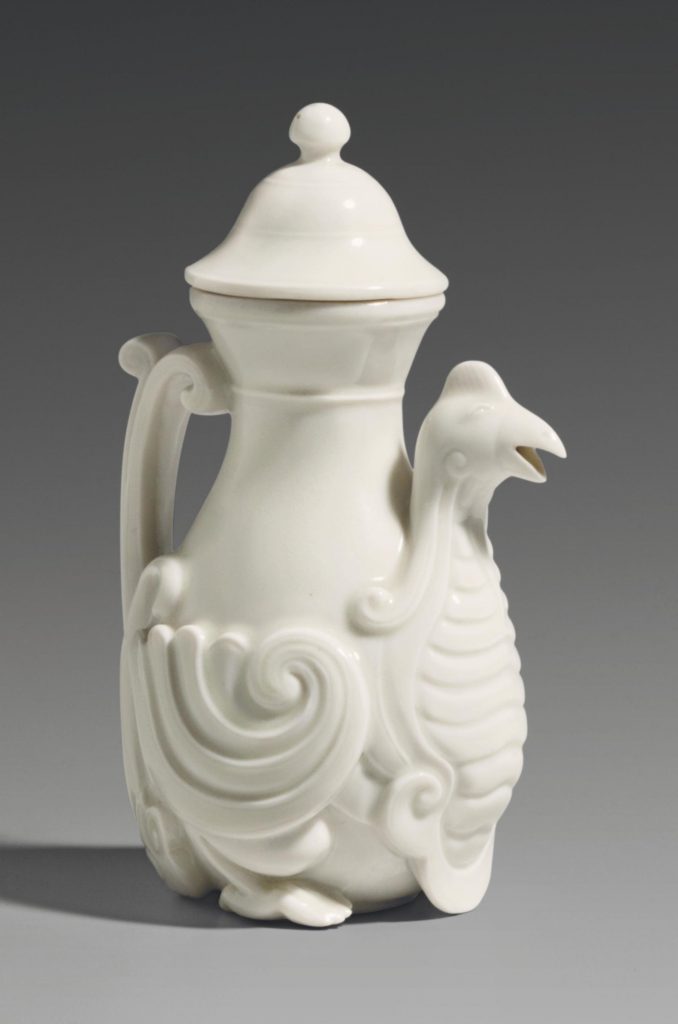
18TH/19TH CENTURY
成交價 USD 56,250
估價 USD 7,000 – USD 9,000
清十八/十九世紀 德化白釉鳳形執壺
18TH/19TH CENTURY
來源
Ralph M. Chait Galleries, New York, ca. 1970-71.
狀況報告
We have sought to record changes in the condition of this piece acquired after its initial manufacture.
There is a short firing flaw or crack to the interior of the neck of the ewer. The cover has two burst glaze bubbles in the finial.
拍品專文
The inspiration for the modeling of this ewer and cover is unknown and appears to be a combination of European and Chinese sources; the Chinese-derived phoenix is molded on the chest with a European-style cartouche. A virtually identical ewer is illustrated by P.J. Donnelly in Blanc-de-Chine, New York, 1969, p. 151A, where it is noted that the piece bears a He Chaochun mark. The same ewer is mentioned by R. Blumenfeld in Blanc de Chine, The Great Porcelain of Dehua, Berkeley, 2002, p. 137, where the author discusses the works by the potter He Chaochun in the collection of the late P.J. Donnelly and notes a “bird-shaped pitcher” that is now in London.
參考:紐約大都會博物館
清中期 玉雕瑞獸瓶
Fantastic creature supporting a vase
18th century
China
On view at The Met Fifth Avenue in Gallery 222
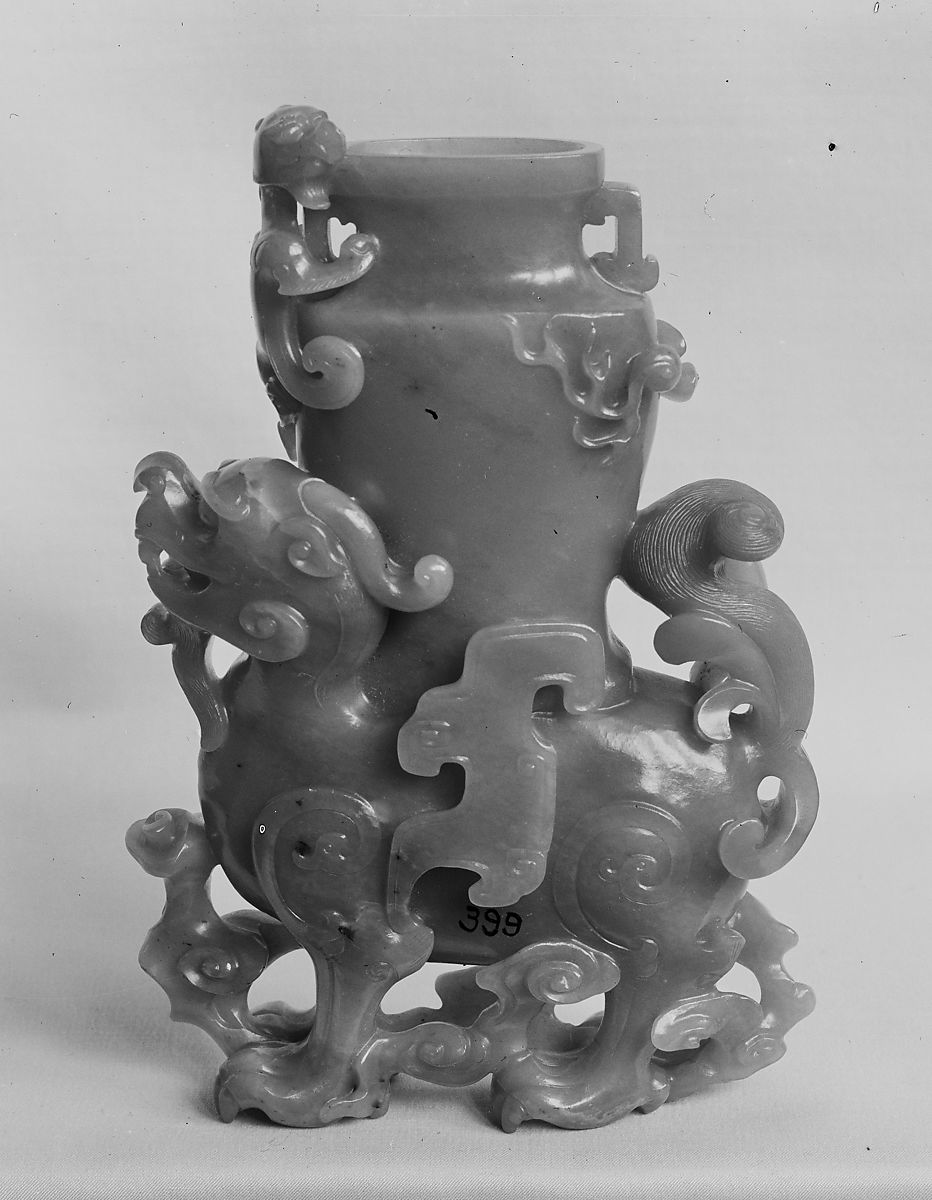
Object Details
Period:Qing dynasty (1644–1911)
Date:18th century
Culture:China
Medium:Jade (nephrite)
Dimensions:H. 5 11/16 in. (14.5 cm); W. 3 3/4 in. (9.6 cm); L. 1 5/16 in. (3.4 cm)
Classification:Jade
Credit Line:Gift of Heber R. Bishop, 1902
Accession Number:02.18.399
Provenance
Heber R. Bishop , New York (until 1902; donated to MMA)
Exhibition History
New York. The Metropolitan Museum of Art. “A Passion for Jade: Heber Bishop and His Collection”.
New York. The Metropolitan Museum of Art. “The Bishop Jades,” March 30, 2004–February 12, 2006.
New York. The Metropolitan Museum of Art. “The “Hundred Antiques”,” February 18, 2006–October 31, 2006.
New York. The Metropolitan Museum of Art. “Extravagant Display: Chinese Art in the Eighteenth and Nineteenth Centuries,” December 14, 2010–May 1, 2011.
New York. The Metropolitan Museum of Art. “A Passion for Jade: The Heber Bishop Collection,” March 14, 2015–June 19, 2016.
New York. The Metropolitan Museum of Art. “Colors of the Universe: Chinese Hardstone Carvings,” June 25, 2016–October 9, 2017.
Timeline of Art History
Timelines
Central and North Asia, 1600-1800 A.D.
China, 1600-1800 A.D.
参考: 拍卖结果
纽约苏富比
2019纽约亚洲艺术周春季拍卖会
中国艺术珍品
明 铜错金银天鸡形炉

拍卖信息
Lot 672 明 铜错金银天鸡形炉
估价:20,000-30,000 USD
成交价: 275,000 USD (含买家佣金)
尺寸:高28 cm
拍品说明:
来源: Ben Birillo,纽约,1972年11月6日
参考:拍卖结果
香港苏富比2018年五月拍卖
中国艺术品
二十世纪 掐丝珐琅天鸡尊
中國藝術品
480
亞洲私人收藏
二十世紀 掐絲琺瑯天雞尊
估價 200,000 — 300,000 港幣

拍卖信息
Lot 480 二十世纪 掐丝珐琅天鸡尊
估价:200,000-300,000 HKD
未成交
尺寸:高36 cm
拍品说明:
展览: 传新加坡国家博物馆,1982年10月;1985年7月及1987 年12月
SALE 15487 Fine Chinese Ceramics and Works of Art
London|15 May 2018
LOT 77
A RARE GOLD AND SILVER-INLAID BRONZE ARCHAISTIC BIRD-FORM RITUAL VESSEL, ZUN
MING DYNASTY, 17TH CENTURY
Price realised :GBP 380,750
Estimate:GBP 100,000 – GBP 150,000
A RARE GOLD AND SILVER-INLAID BRONZE ARCHAISTIC BIRD-FORM RITUAL VESSEL, ZUN
MING DYNASTY, 17TH CENTURY
The vessel is well cast as a standing mythical bird with the head facing forward, carrying a twin-handled vase decorated with monster masks between a pair of upswept wings, all intricately inlaid in gold and silver in contrast to the dark patina. The long tail cascades downwards, centralised by a trail of upright geometric stylised scrolls running along the spine and ending in a curled tip.
14 ½ in. (37 cm.) high
Provenance
By repute, with Bluett & Sons, London, then Michael Goedhuis, London.
Special Notice
These lots have been imported from outside the EU for sale using a Temporary Import regime. Import VAT is payable (at 5%) on the Hammer price. VAT is also payable (at 20%) on the buyer’s Premium on a VAT inclusive basis. When a buyer of such a lot has registered an EU address but wishes to export the lot or complete the import into another EU country, he must advise Christie’s immediately after the auction.
参考:西泠印社拍卖有限公司
2015秋季拍卖会 > 木易居藏文房古玩专场
3564 清 掐丝珐琅凤首衔环尊 (一对)

拍品信息
作者 — 尺寸 高30cm;口径18cm
作品分类 工艺品杂项 金银琉璃珐琅器
创作年代 清
估价 RMB 320,000-450,000
成交价 RMB 575,000 HKD 694,444 USD 86,250 EUR 63,250
专场 木易居藏文房古玩专场 拍卖时间 2015-12-27
拍卖公司 西泠印社拍卖有限公司 拍卖会 2015秋季拍卖会
说明 说明:一直以来我们的祖先就格外崇尚凤鸟,商代以凤鸟为图腾,即有所谓“玄鸟声生商”之说,周代则将之视作民族的守护神。正是出于对凤鸟的崇敬,以及凤寓意吉祥,商周时期出现了大量凤鸟形青铜器。《周礼.春官.司尊彝》记载古代祭礼礼品中有所谓的“六尊六彝”,就包括了“鸟彝”和“凤首尊”。清代追摹古风到乾隆年间达到高峰,这时宫廷常将古代青铜器的造型纹饰运用到珐琅器的制作中,并将动物立体造型制成铜器或珐琅器以作为陈设观赏用。虽然仿古器物多有所本,但与珐琅结合后,创出另一番别样的艺术特色。珐琅器最早诞生于希腊,希腊普鲁斯岛出土的公元前十二世纪的六枚戒指和双鹰令牌首,被公认为最原始的掐丝珐琅。到了公元前五—六世纪又曾烧造珐琅器;直到公元六世纪,希腊拜占廷的珐琅工艺逐渐发展,后至公元十—十三世纪初,掐丝珐琅工艺极为兴盛。在十二世纪,掐丝珐琅器由阿拉伯地区直接或间接传入中原,并被中国人民发扬光大,是为中西文化交流的一段佳话。
此件器形身形圆润,以蓝色珐琅釉为地,凤首衔环,背部及尾部浮雕出翅膀及尾羽,匠心独具;背开一圆槽,装连椭圆形尊,作卷尾立式。端庄雅致,营造出一种庄重之感。其掐丝细致,釉色纯凈,高贵典雅,置之面前熠熠生辉,新奇中不乏古意。
拍卖 5000 Cloisonnés d’Exception – Collection Juan Jose Amezaga – Seconde Partie
巴黎 2007年12月7日
拍品 20 RARE ET IMPORTANT VASE ‘RHYTON’ EN BRONZE DORE ET EMAUX CLOISONNES
CHINE, DYNASTIE QING, EPOQUE QIANLONG (1736-1795)

CHINE, DYNASTIE QING, EPOQUE QIANLONG (1736-1795)
成交总额 EUR 408,250
估价EUR 30,000 – EUR 50,000
RARE ET IMPORTANT VASE ‘RHYTON’ EN BRONZE DORE ET EMAUX CLOISONNES
CHINE, DYNASTIE QING, EPOQUE QIANLONG (1736-1795)
Le vase de forme évasée, la bordure en bronze doré ciselé de grecques, le corps orné d’élégants branchages feuillagés et pivoines épanouies ou en boutons, aux teintes subtiles contrastant avec le fond turquoise, la partie inférieure prenant naissance sur le dos d’un phénix en repoussé avec lequel le vase se confond, l’animal mythique représenté couché, les pattes repliées, les ailes et la queue déployées de part et d’autre du vase en gracieuses volutes émaillées de bleus divers et rehaussées de gerbes de plumes dorées en relief, la gorge d’un rose pâle subtil, le cou et la tête en bronze doré ciselé de plumes en cascade, l’animal tenant dans son bec un lingzhi formant un anneau ; l’anse manquante
Hauteur: 31,5 cm. (12 3/8 in.)
来源
Sotheby’s London, 29 October 1982, lot 39.
Bluett & Sons Ltd., London, 1982.

![[临渊阁]天地一家春](https://www.antiquekeeper.ca/wp-content/uploads/2023/03/cropped-Asian-Art-Wallpaper-Painting3-6-2.jpg)

